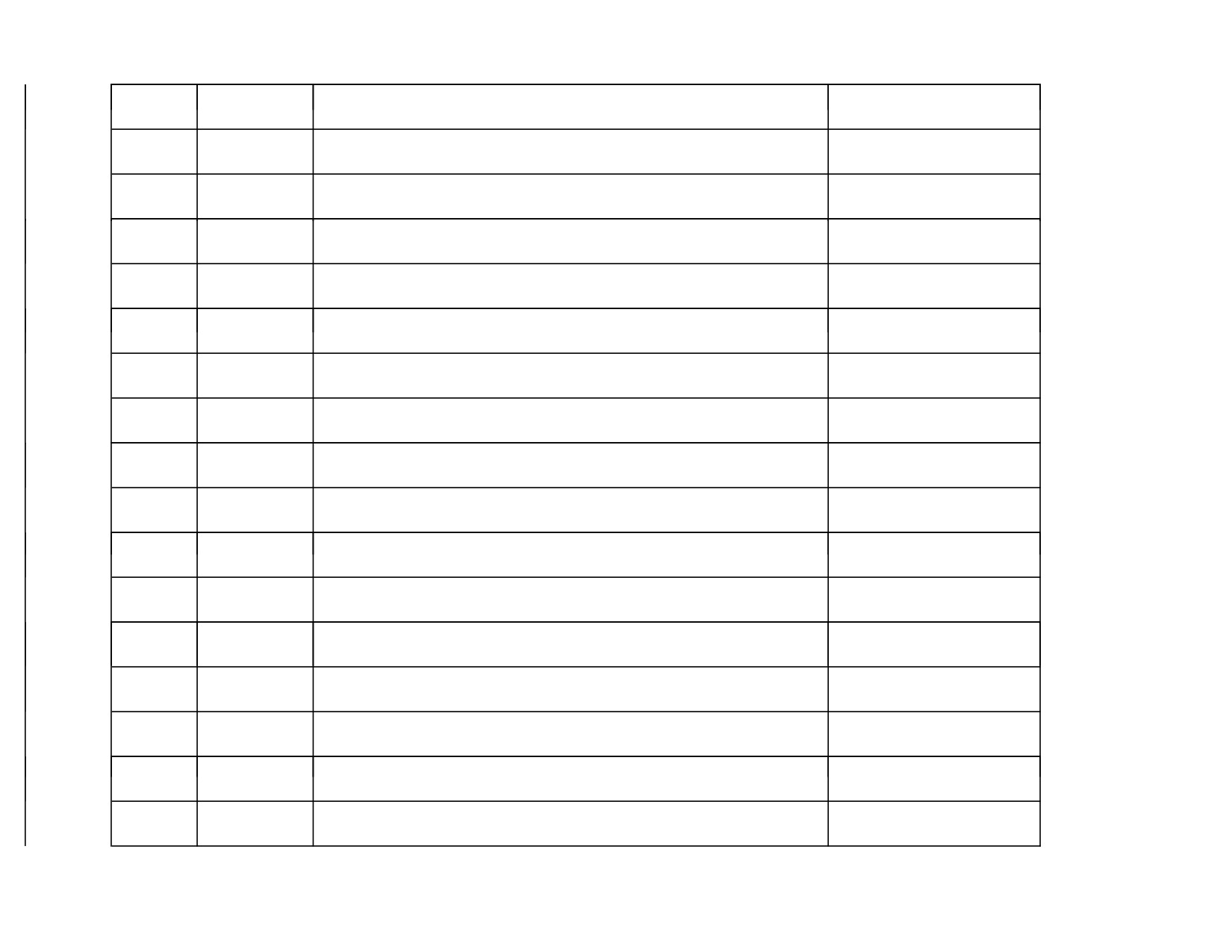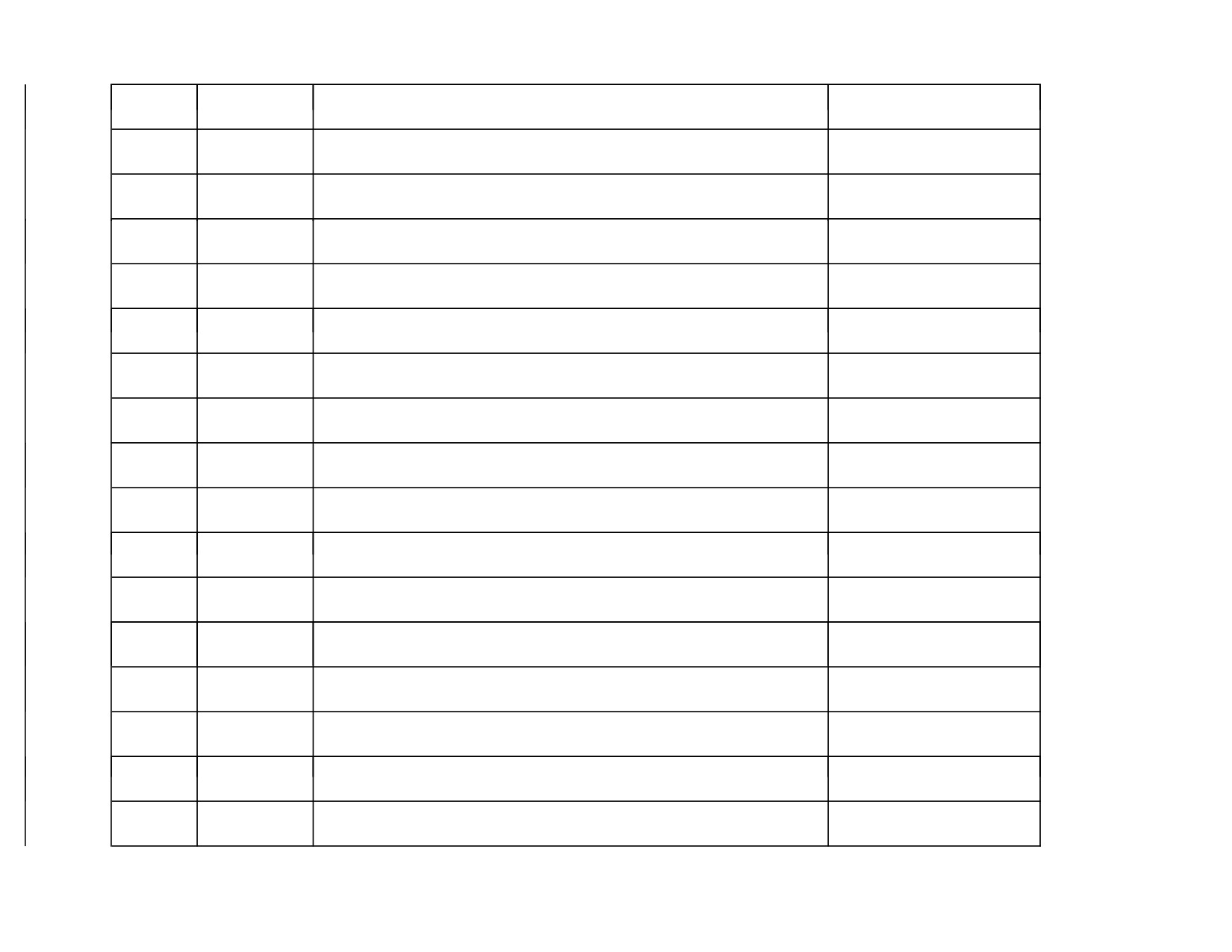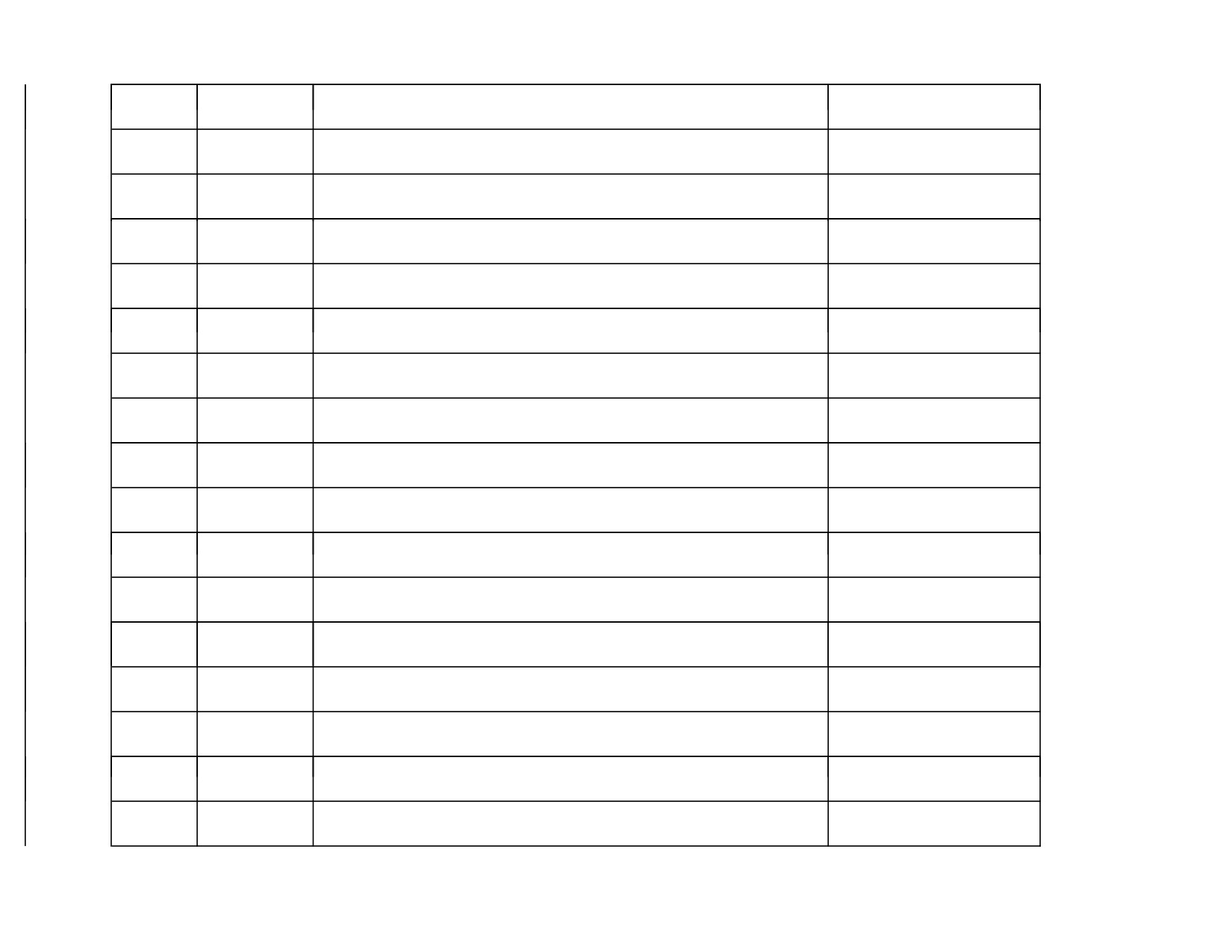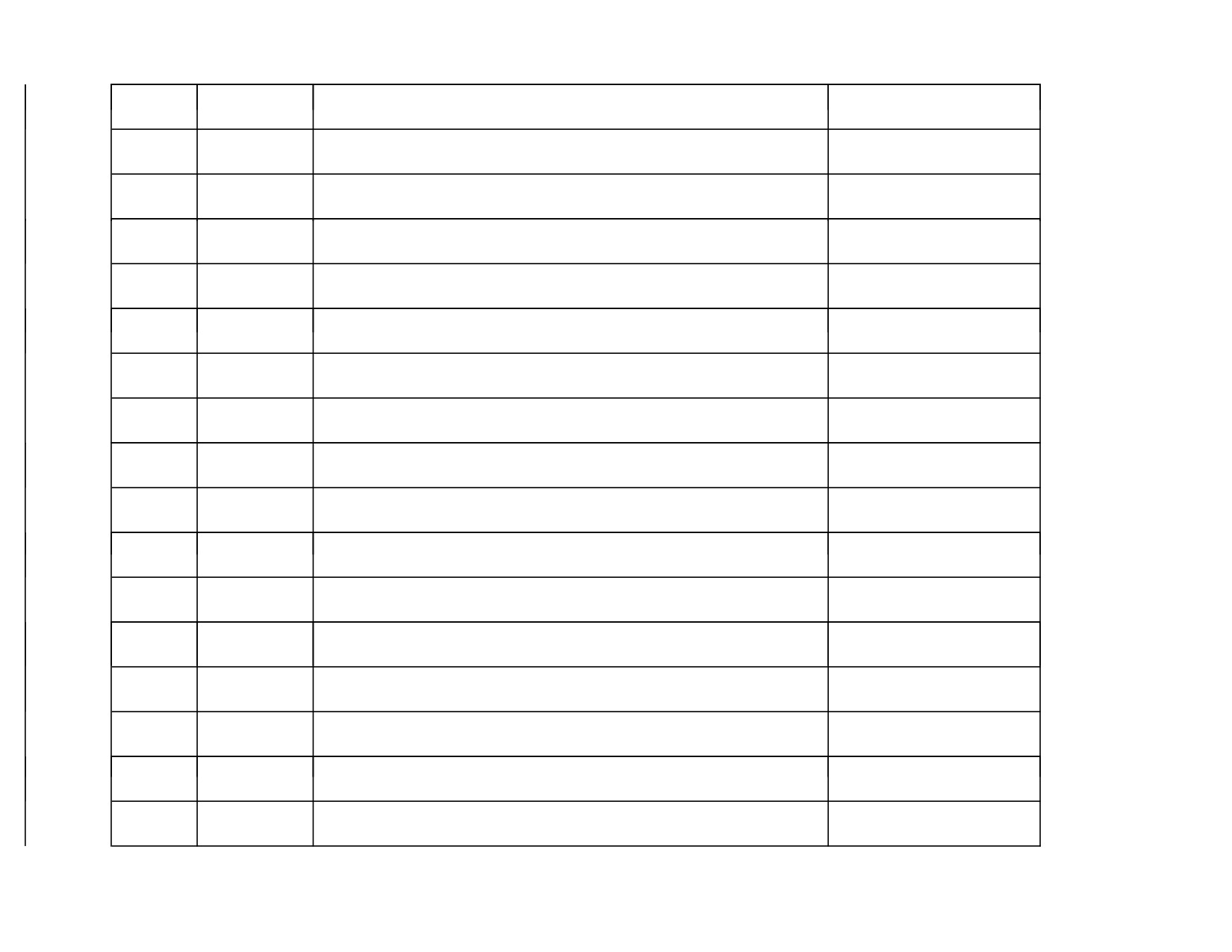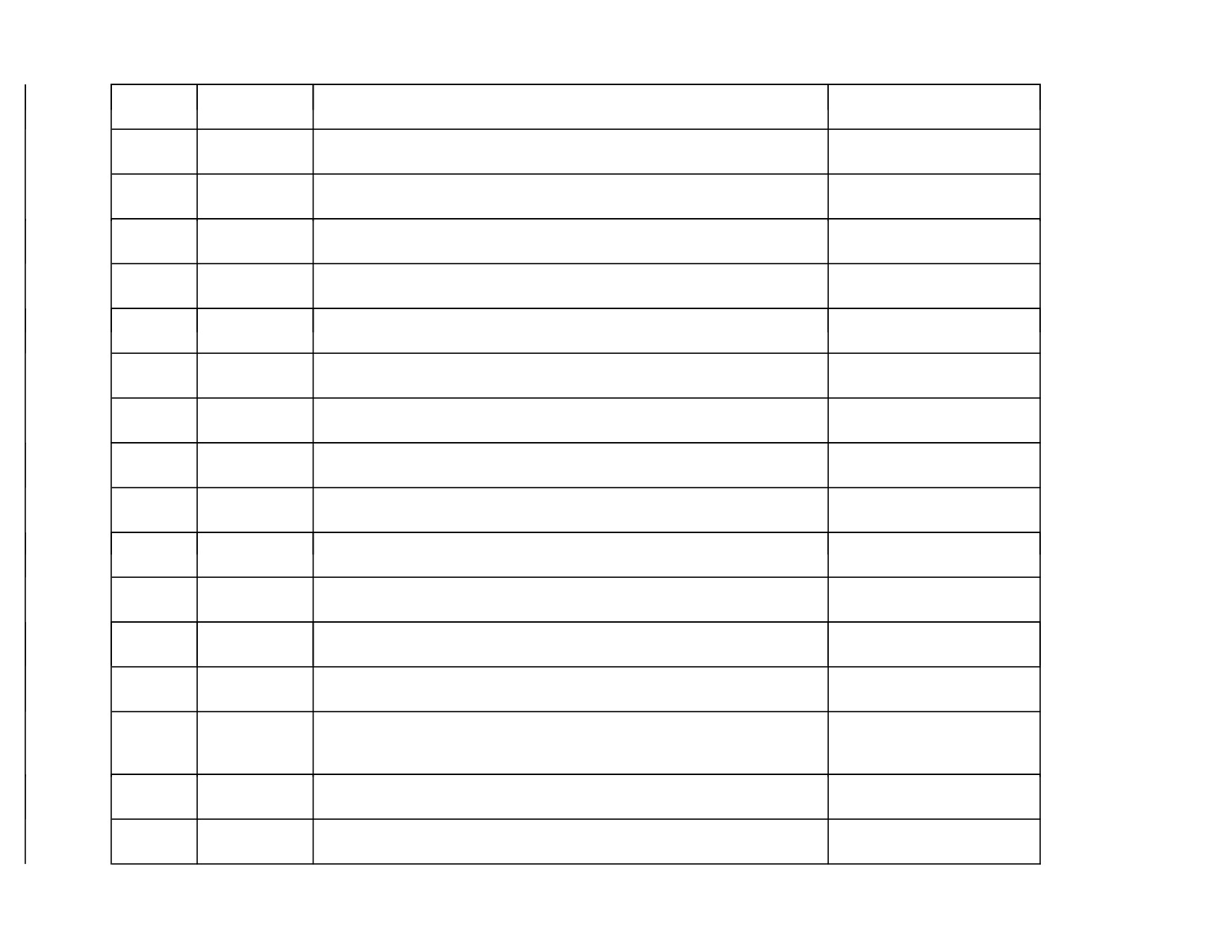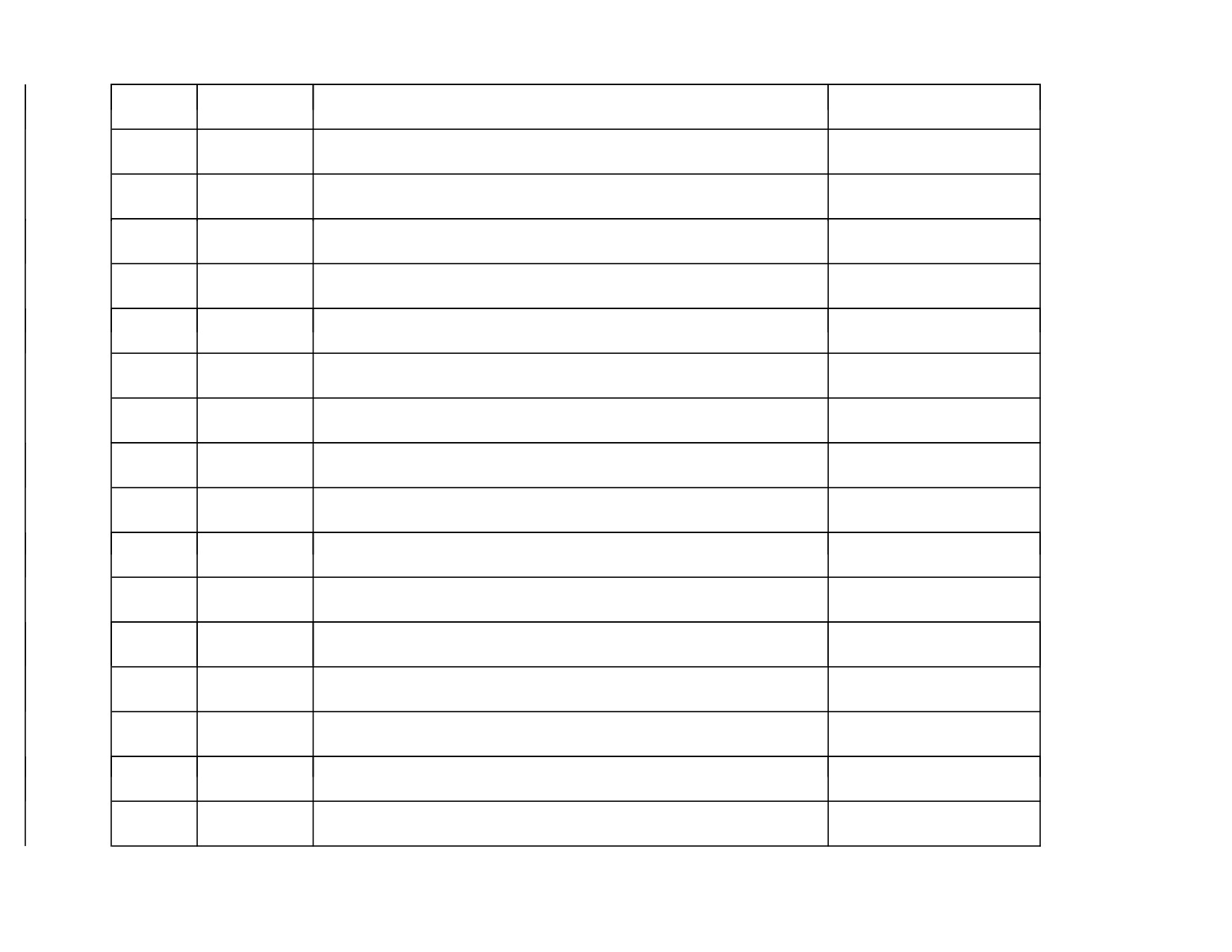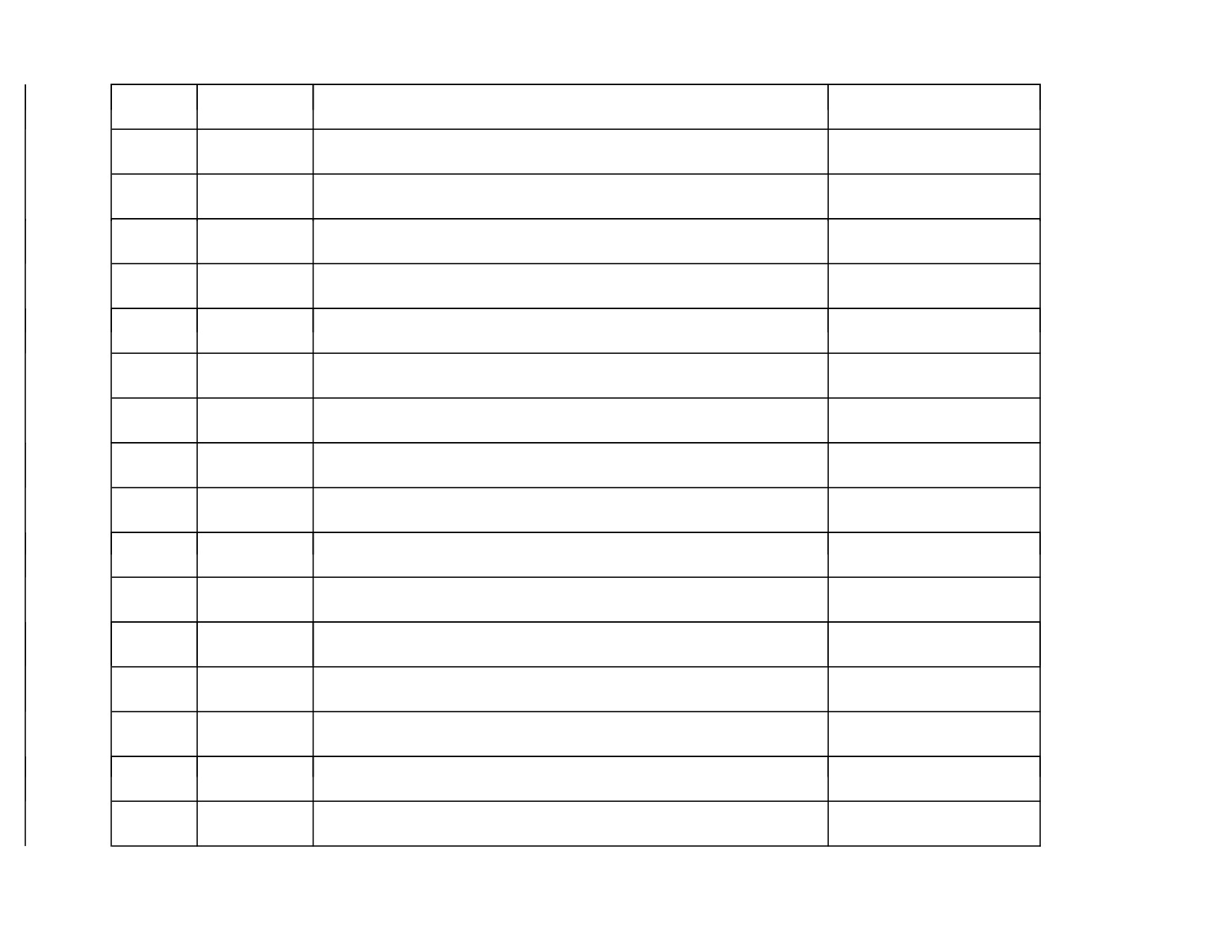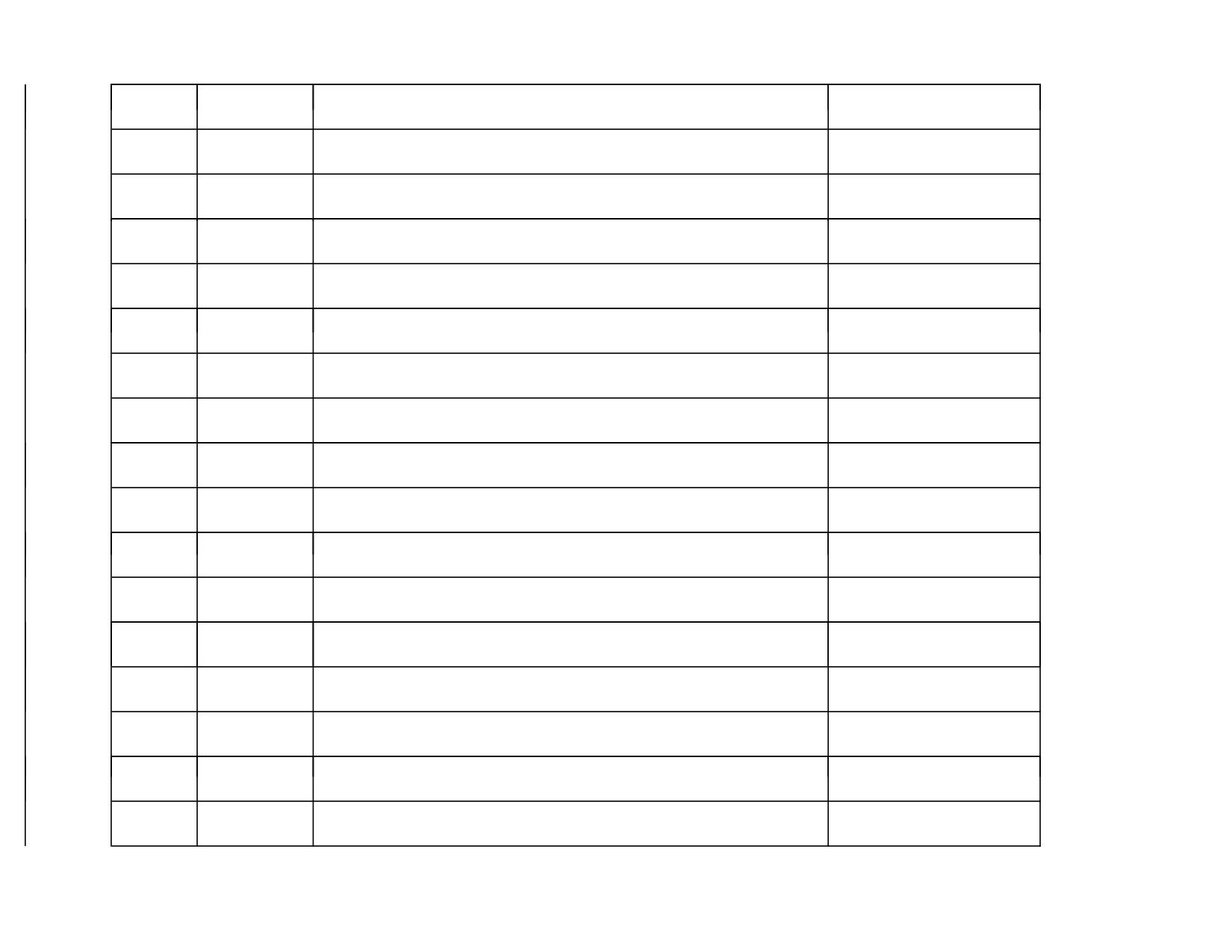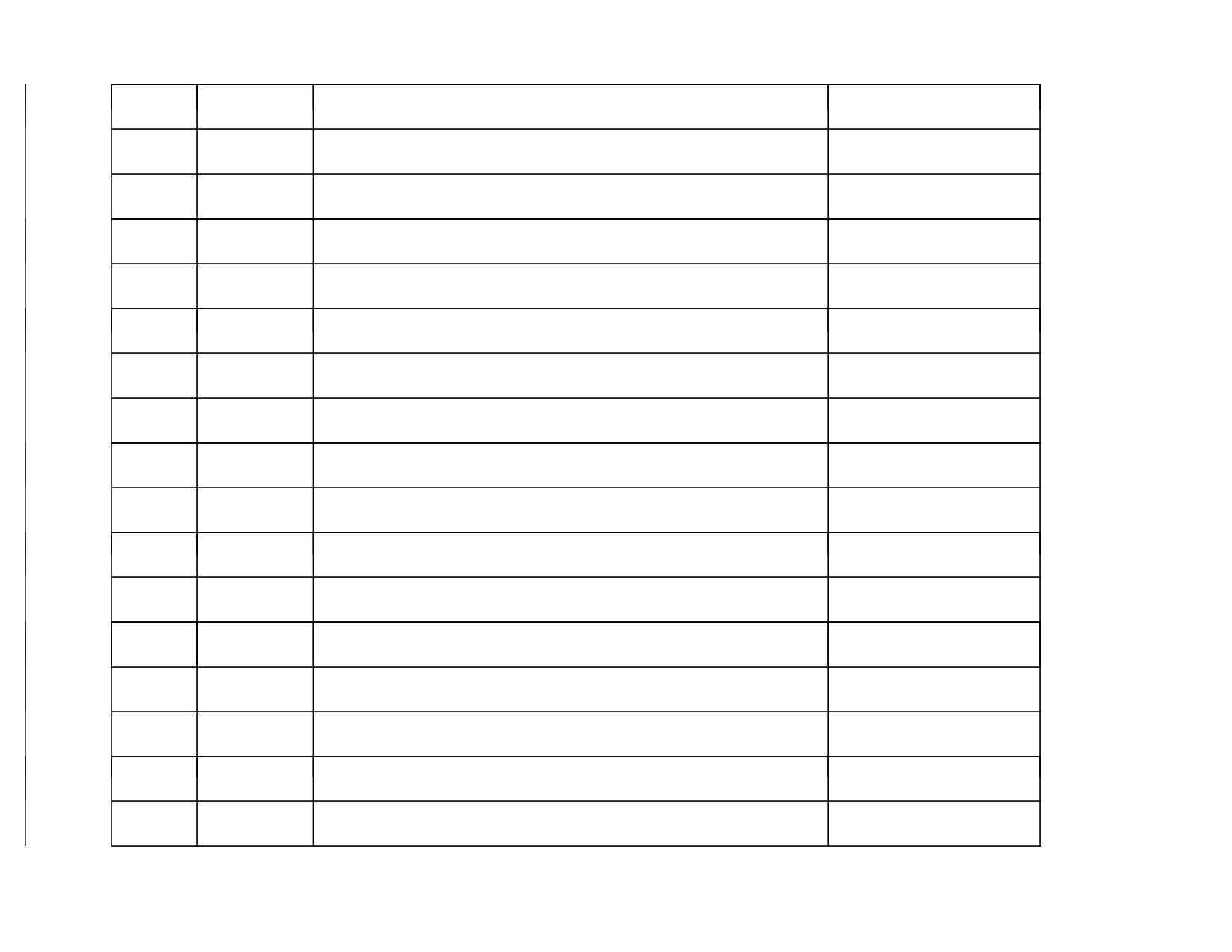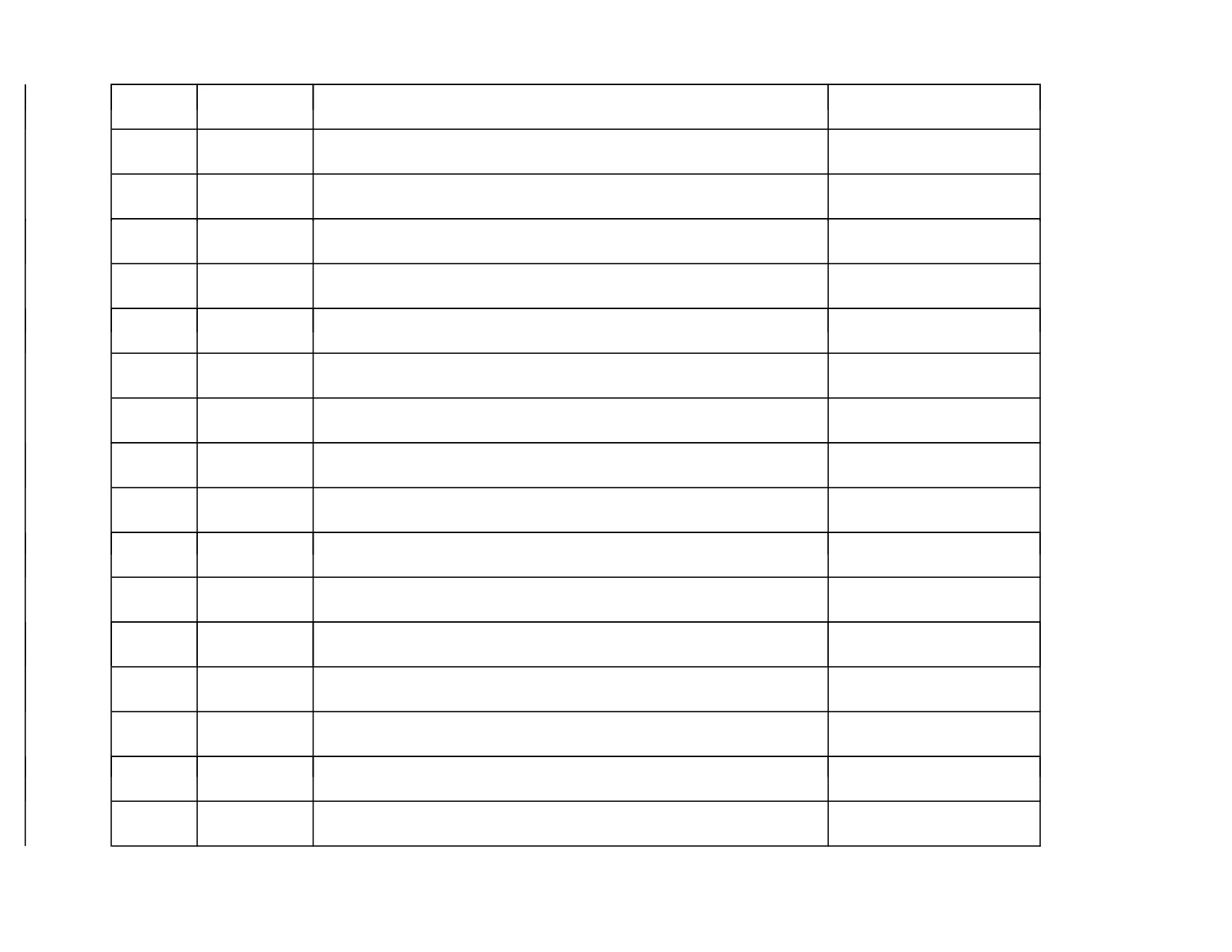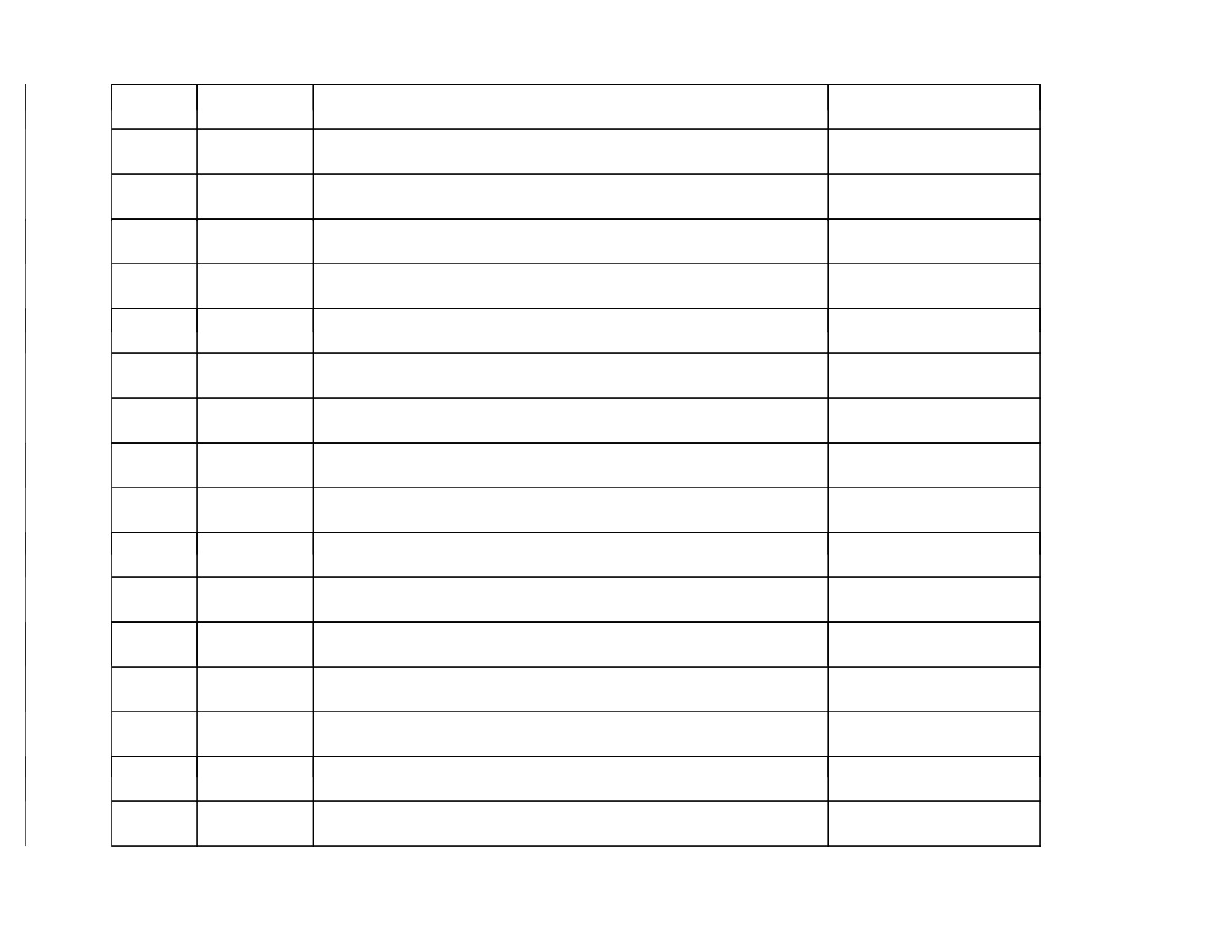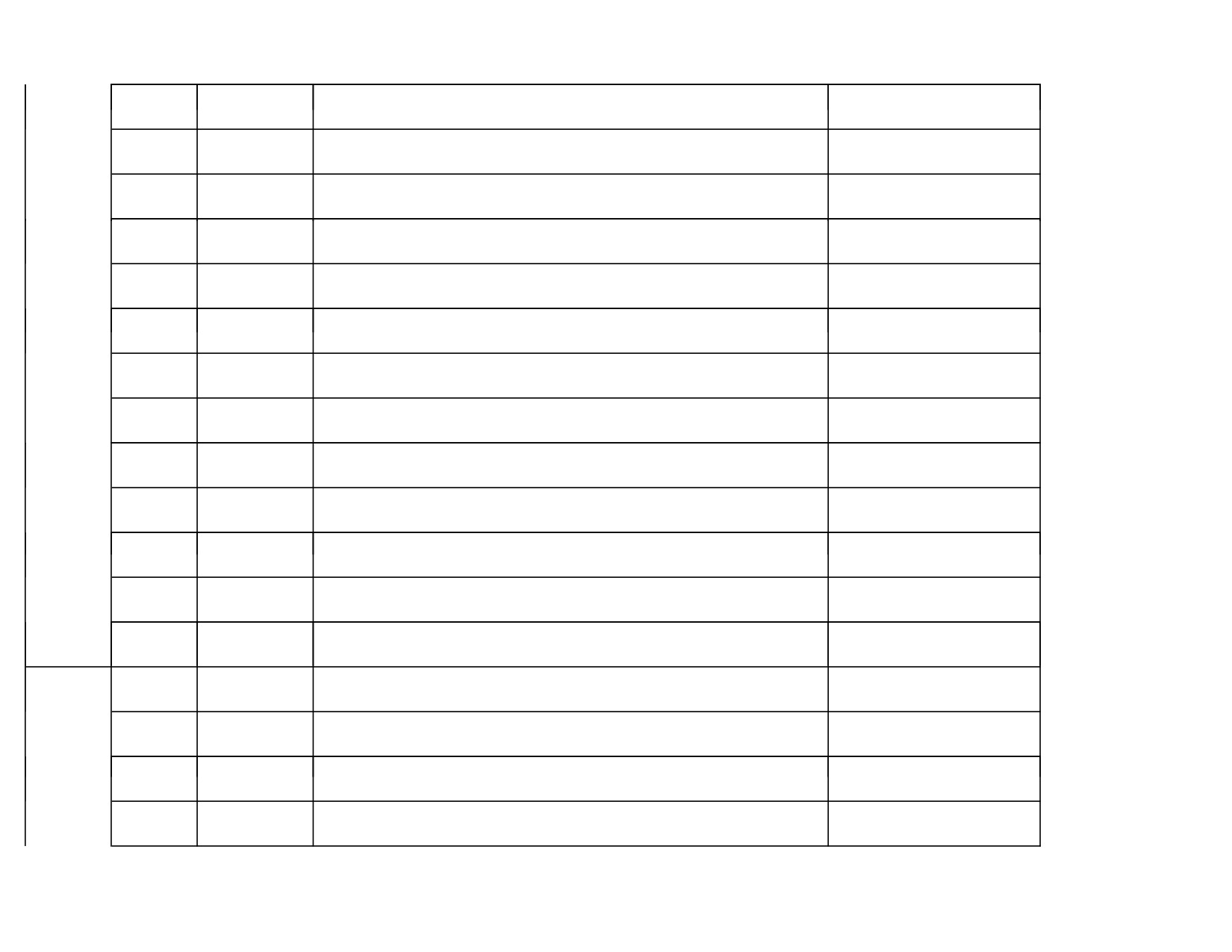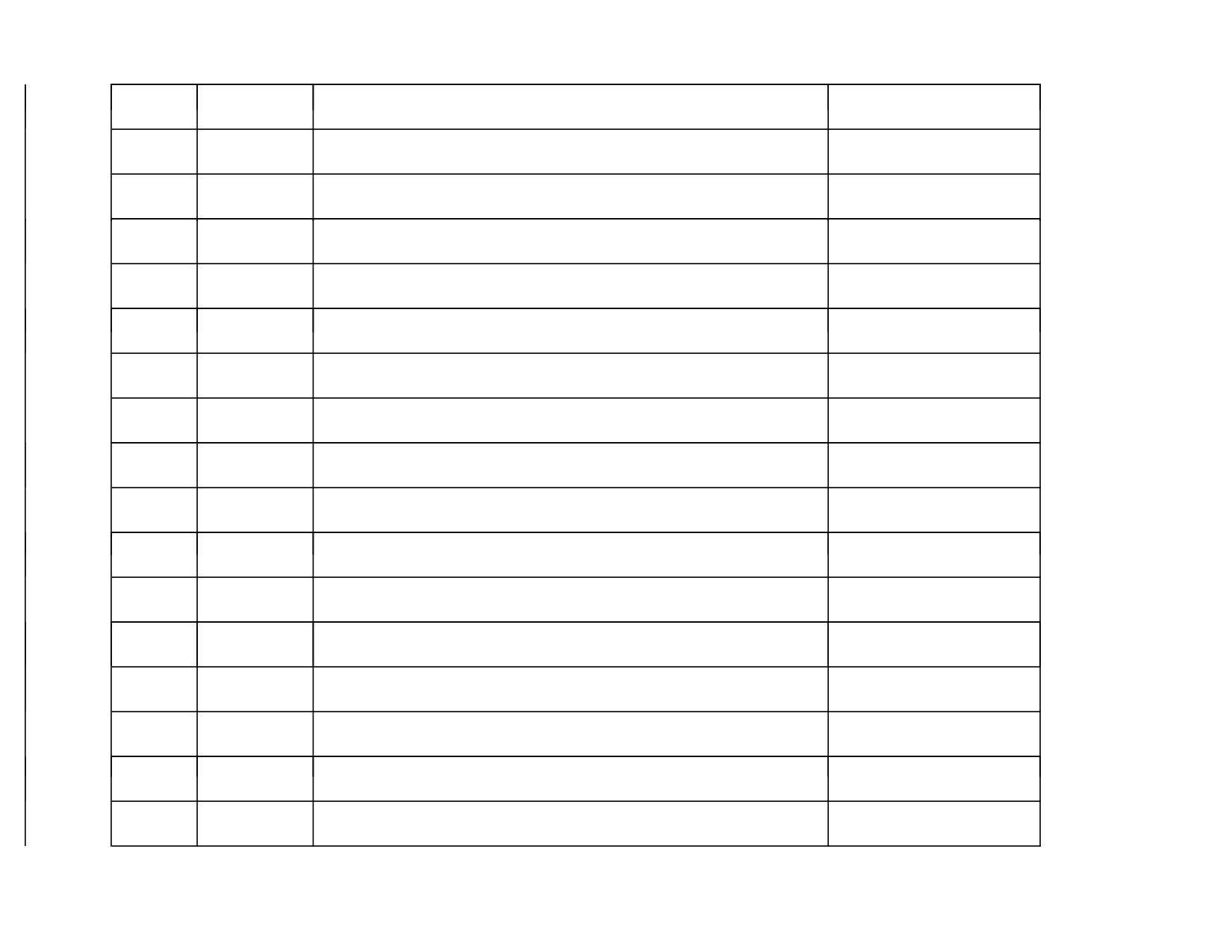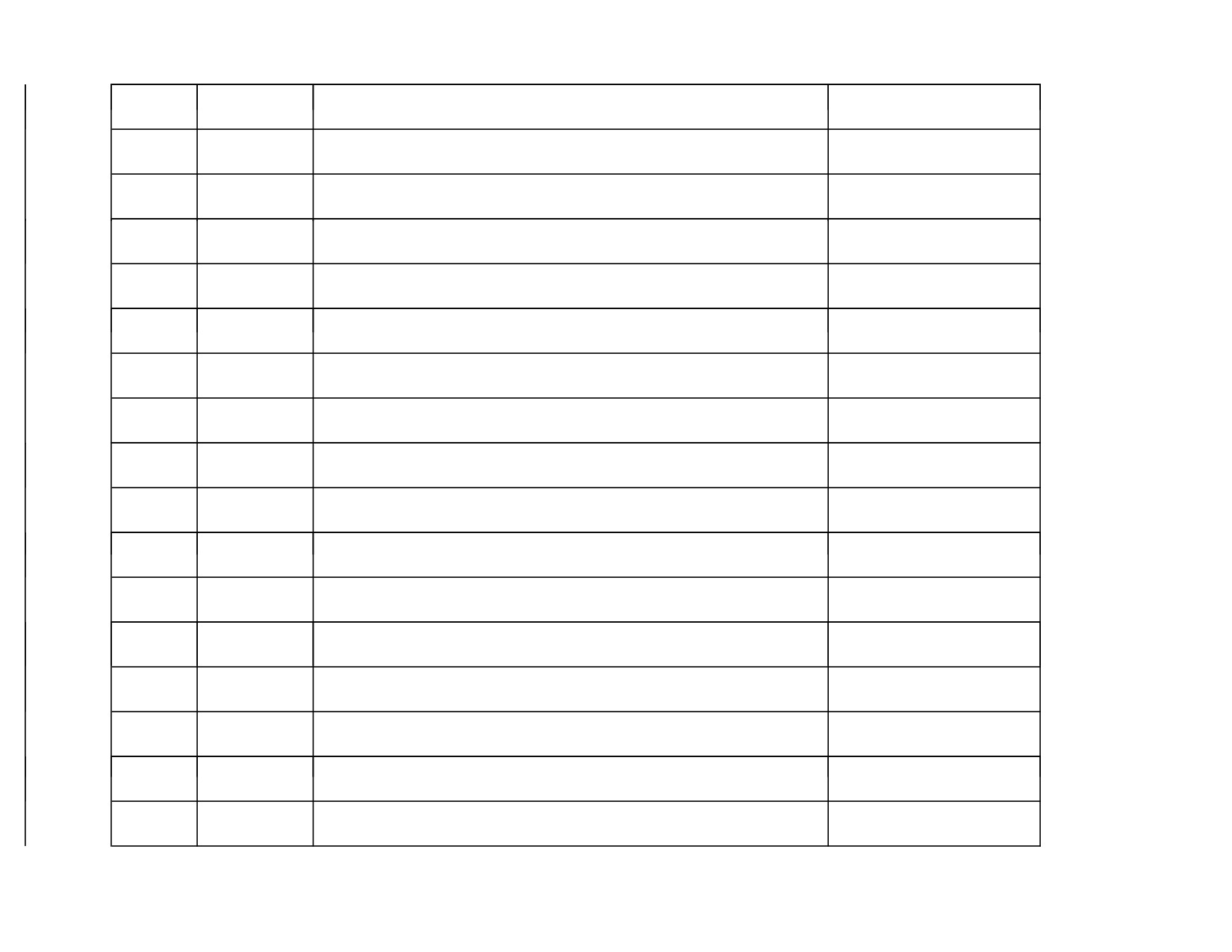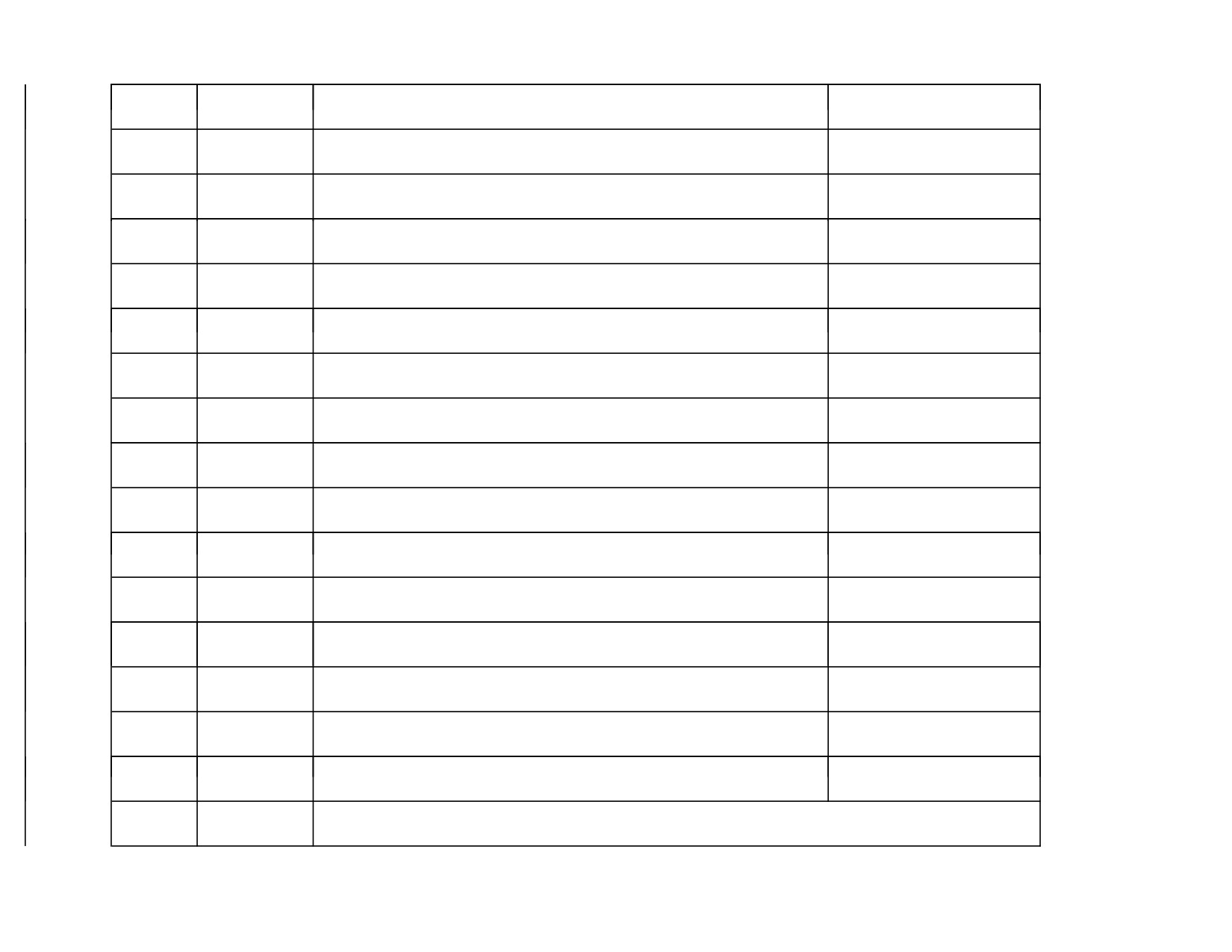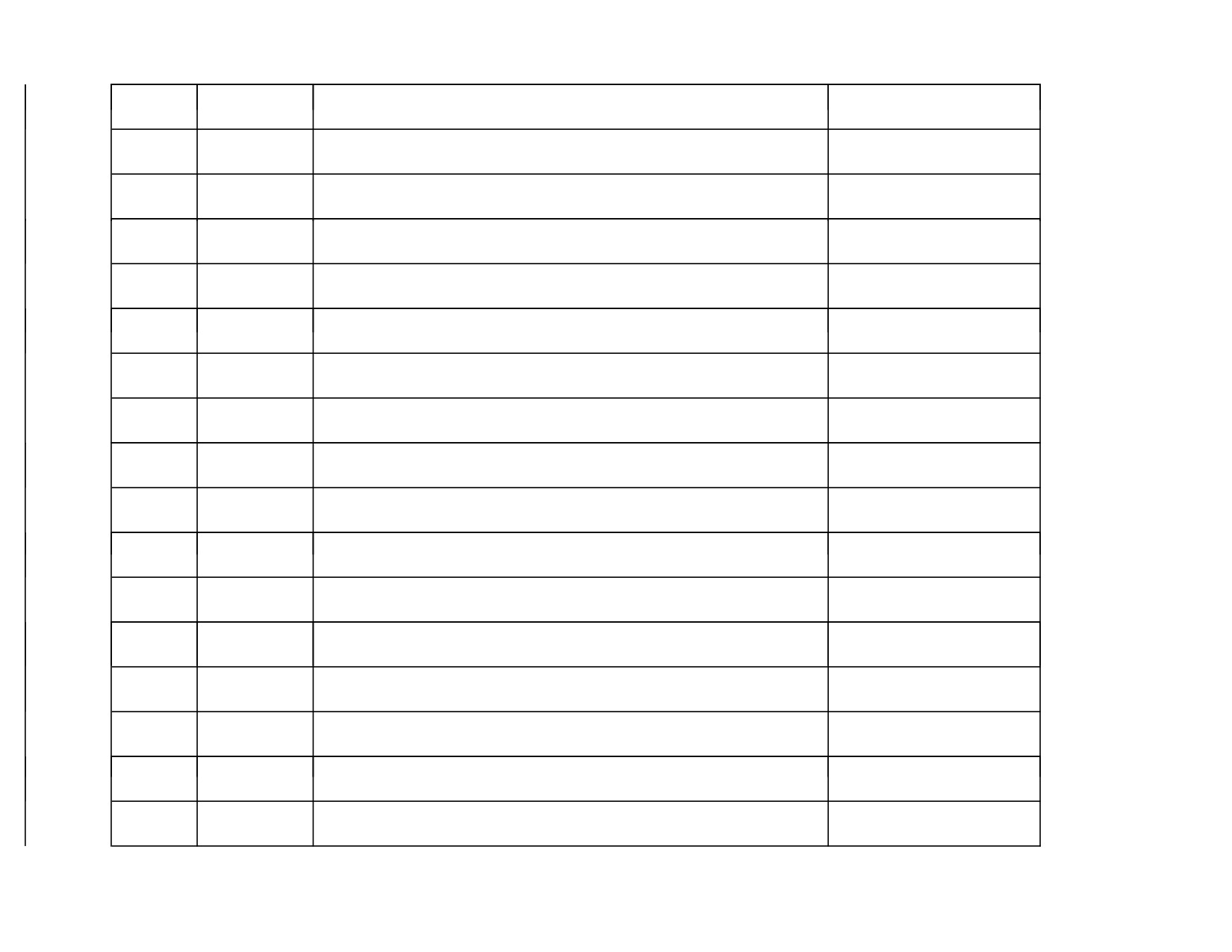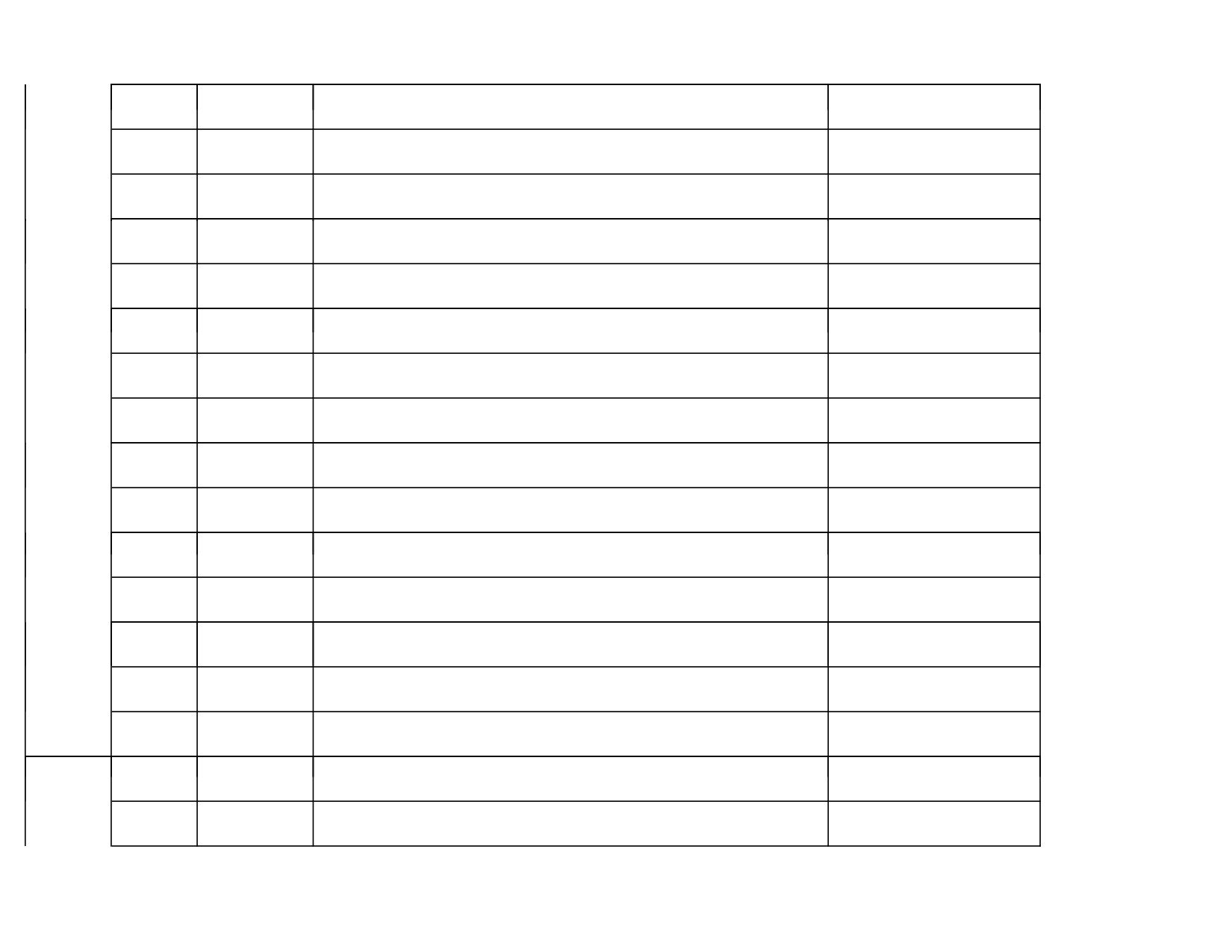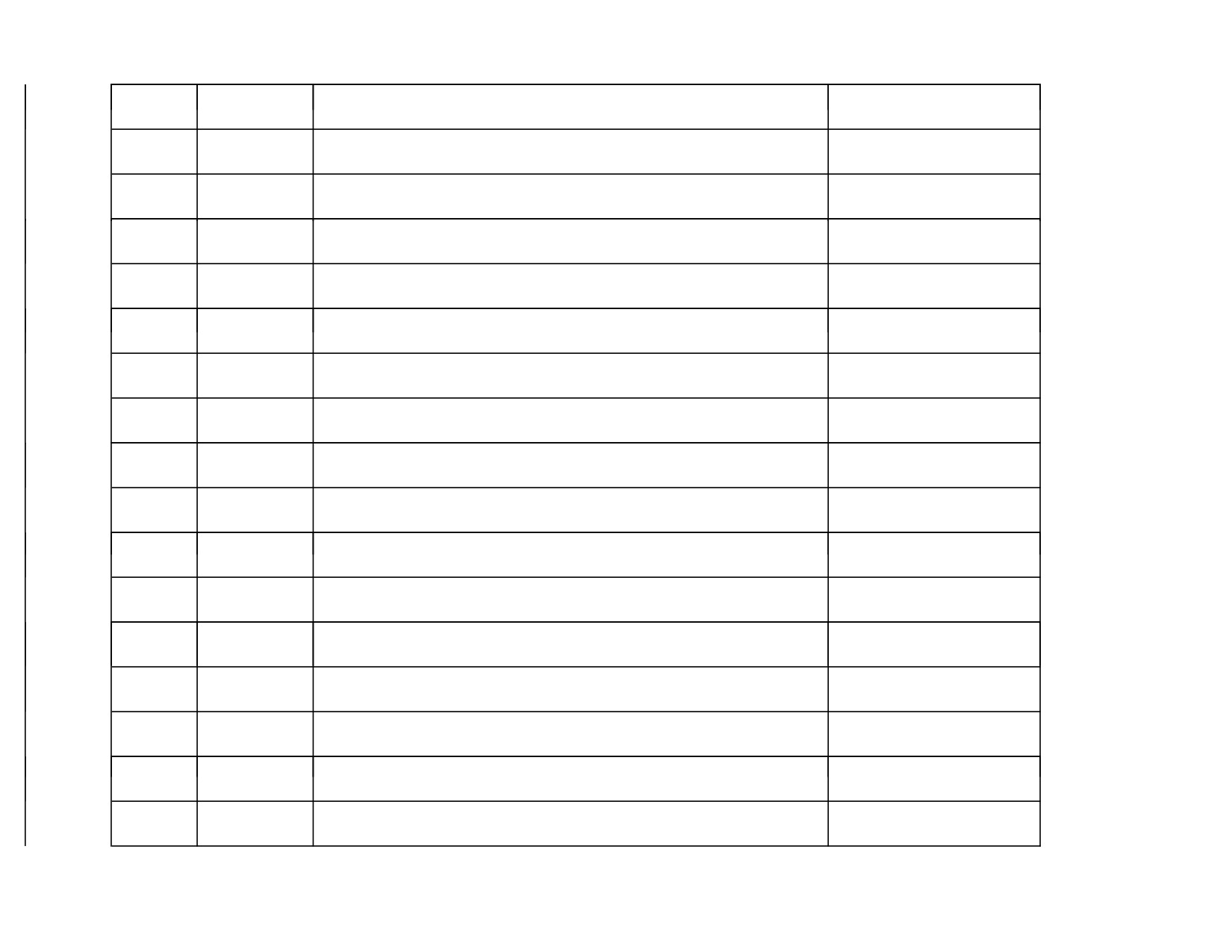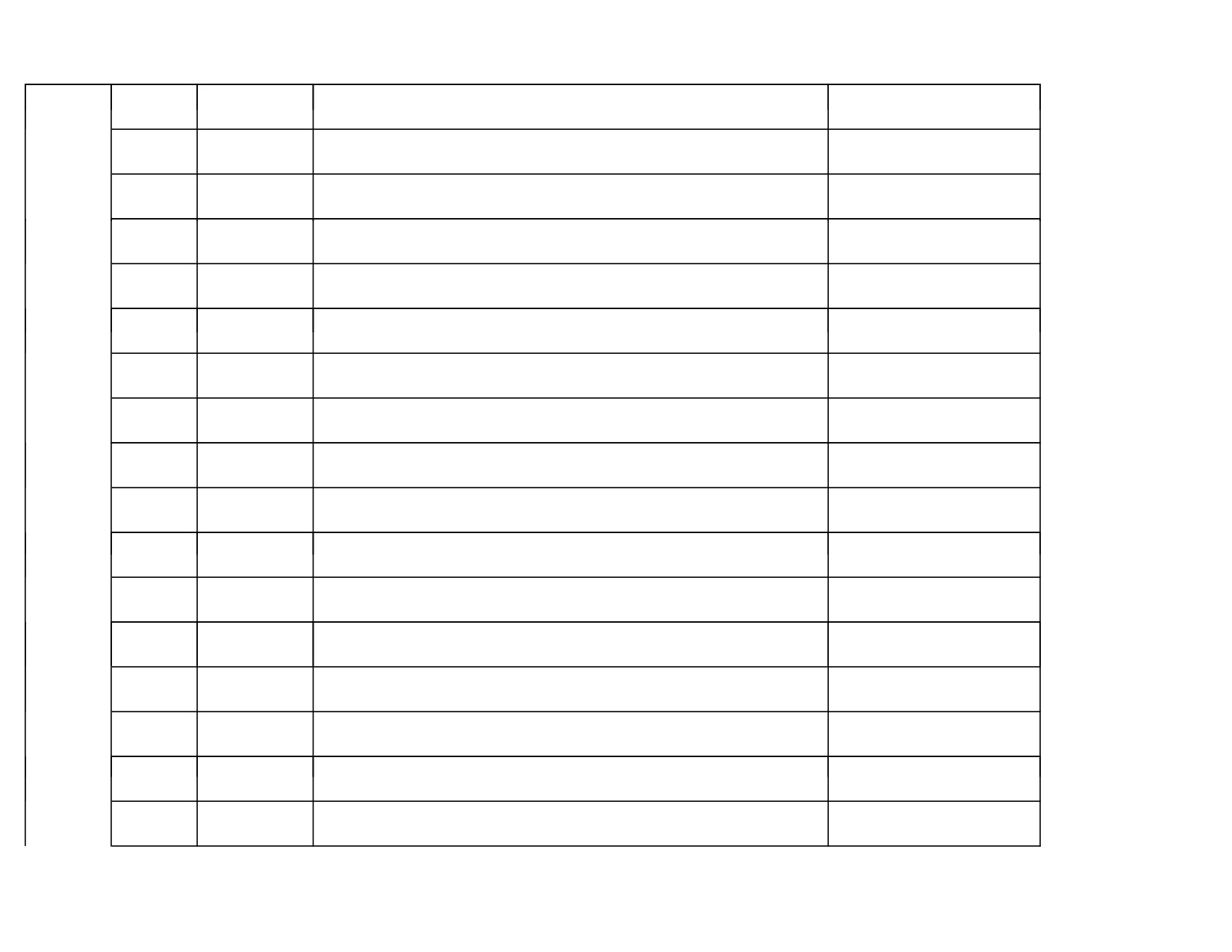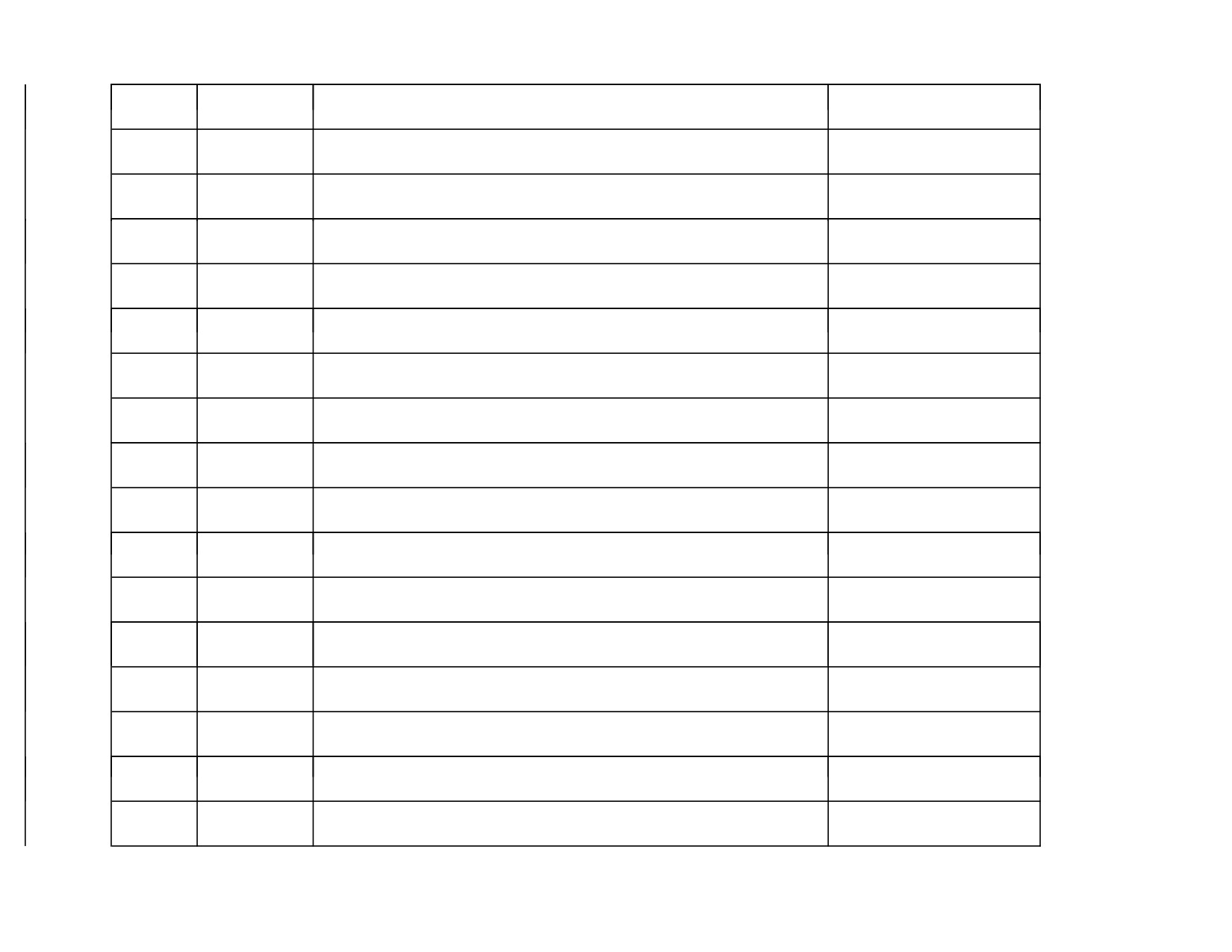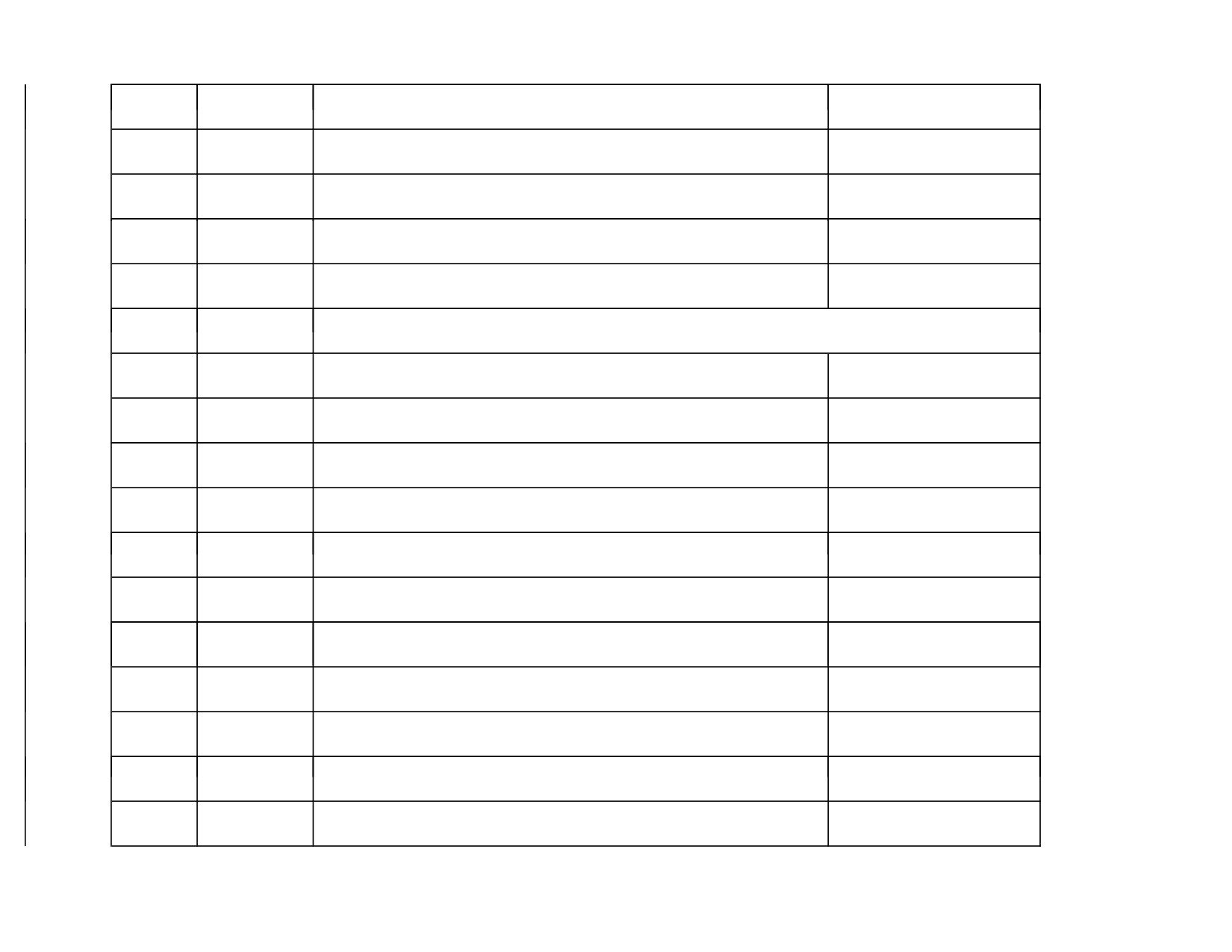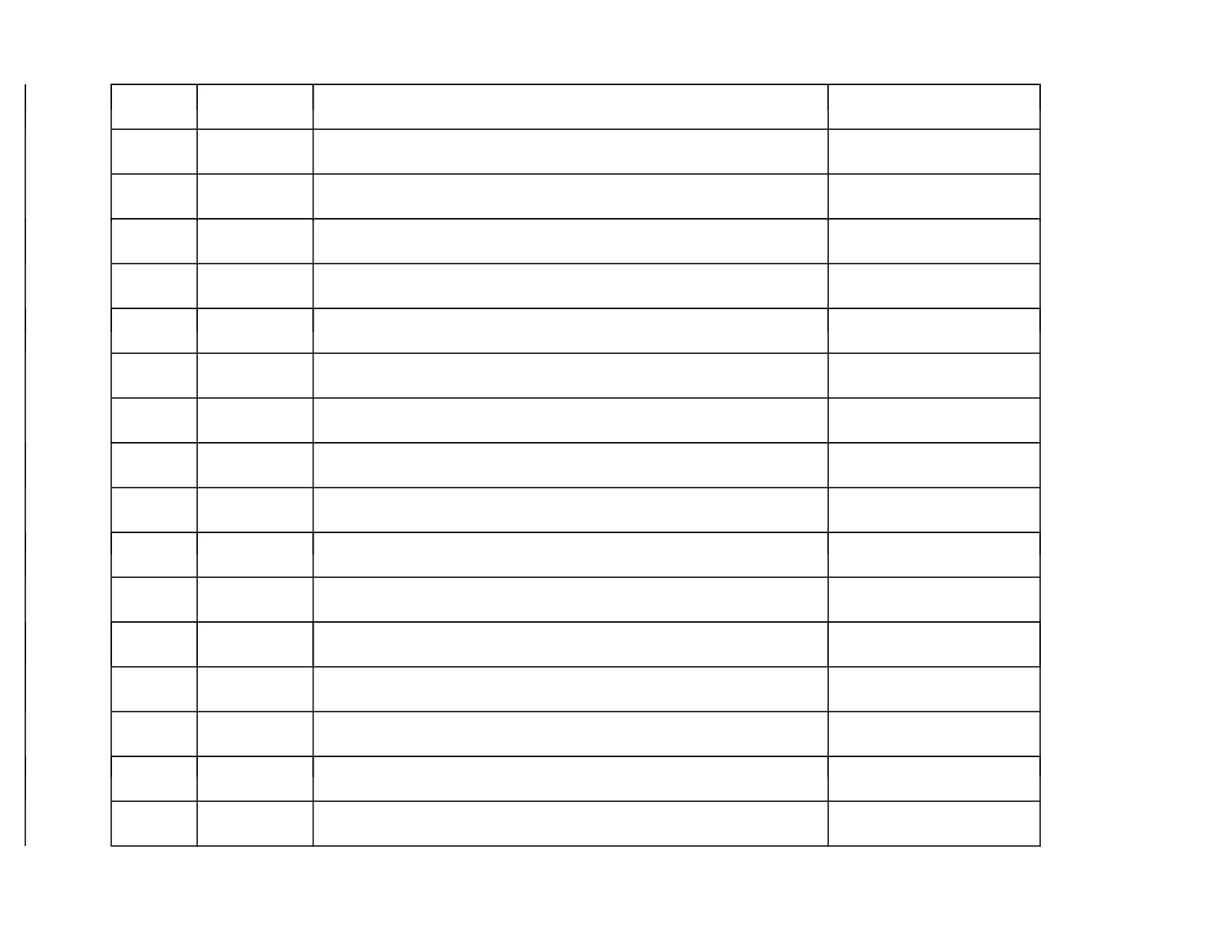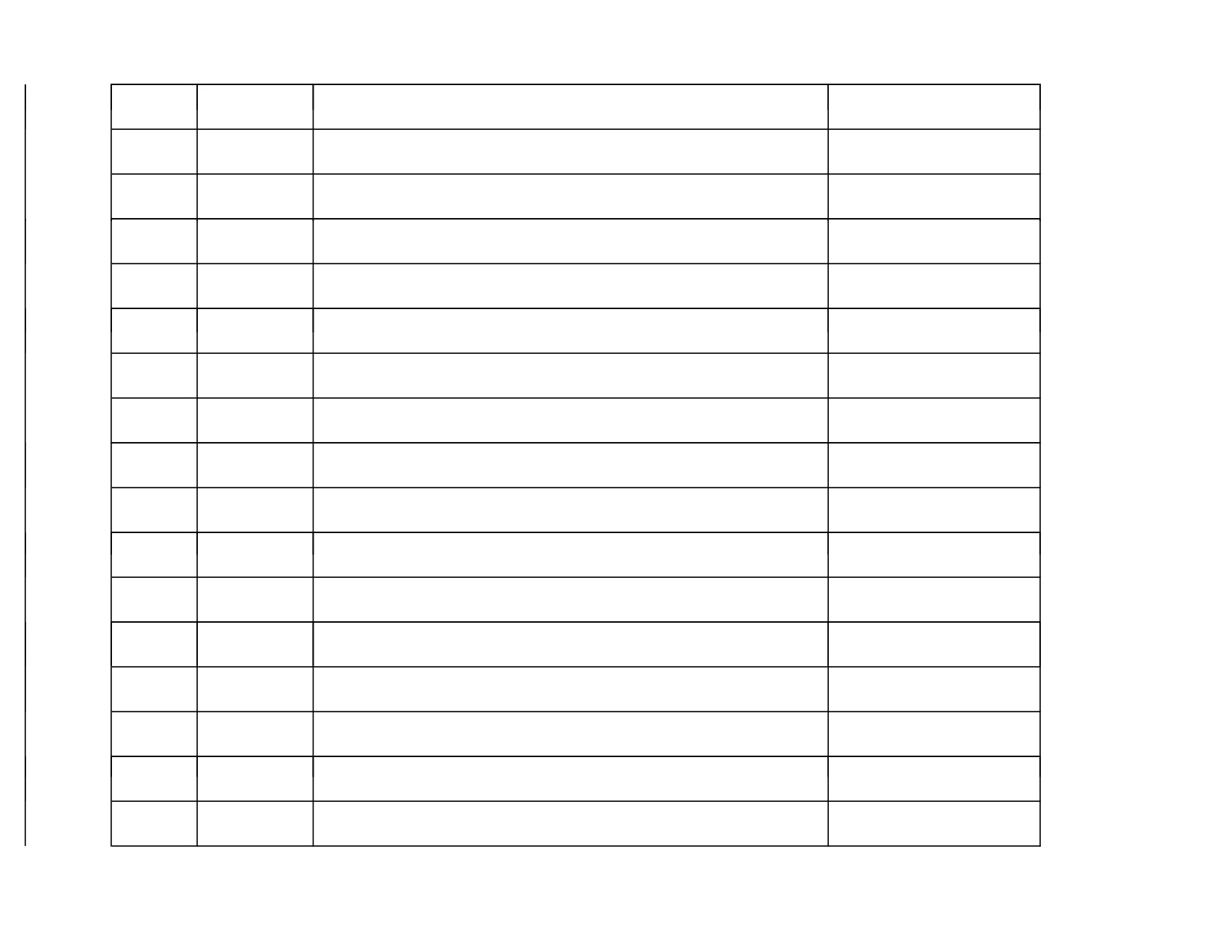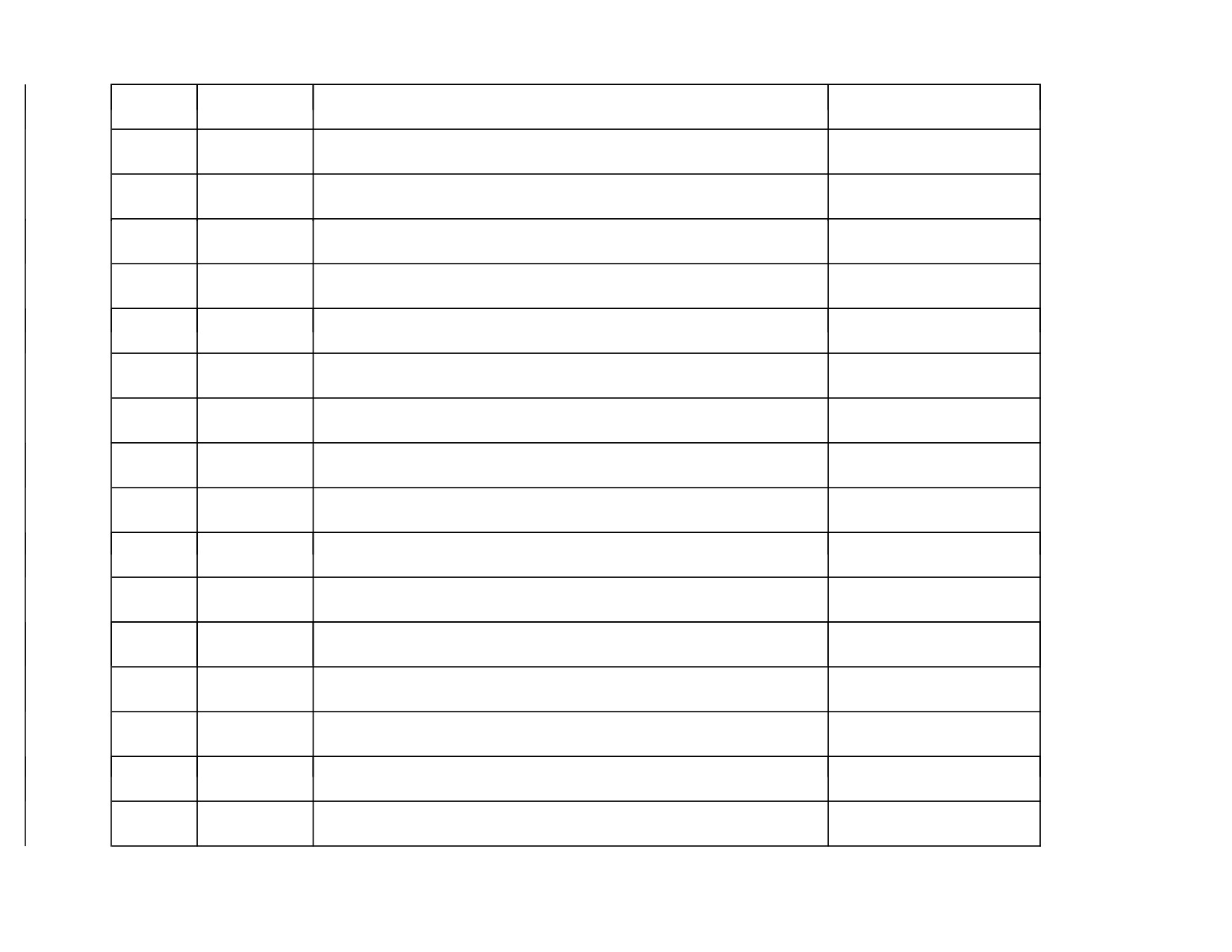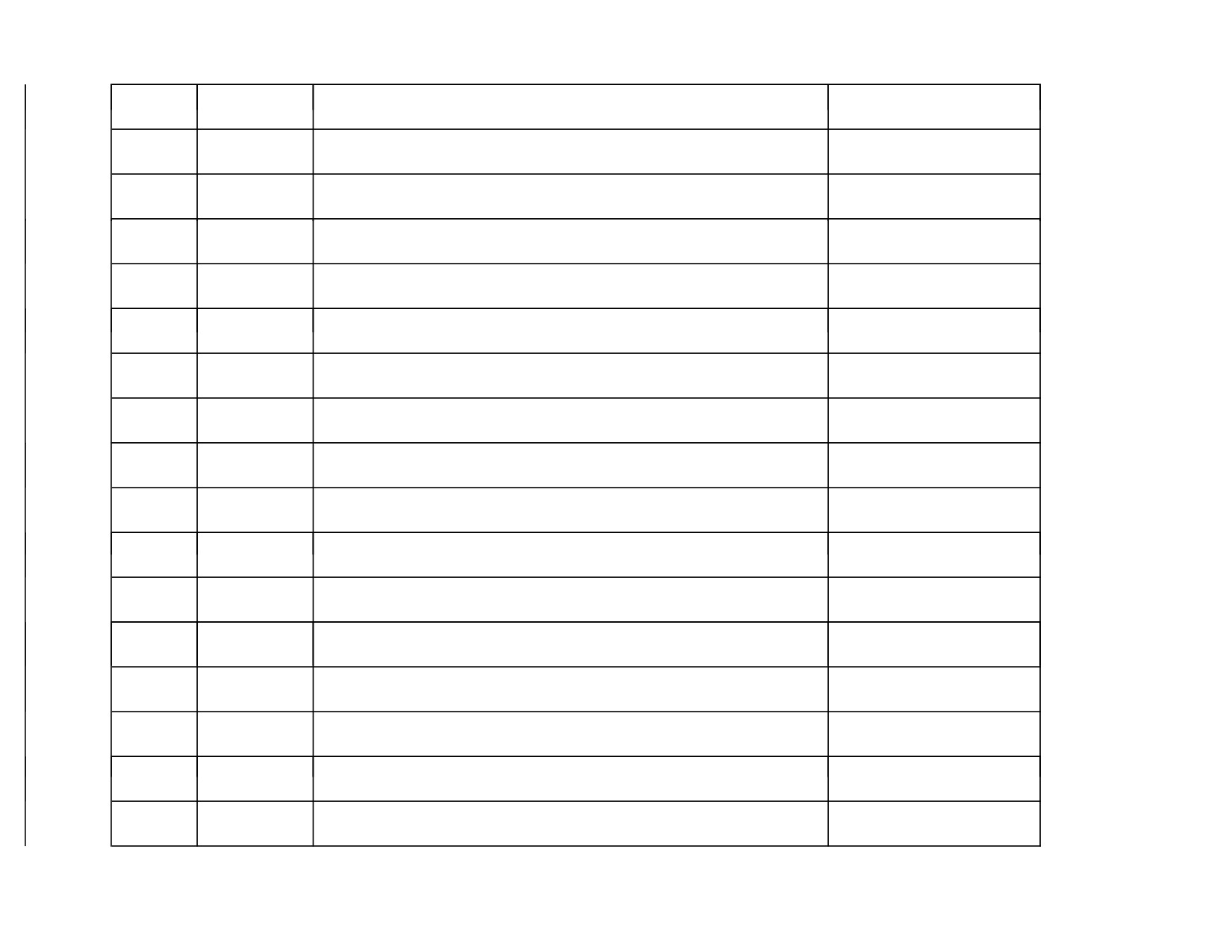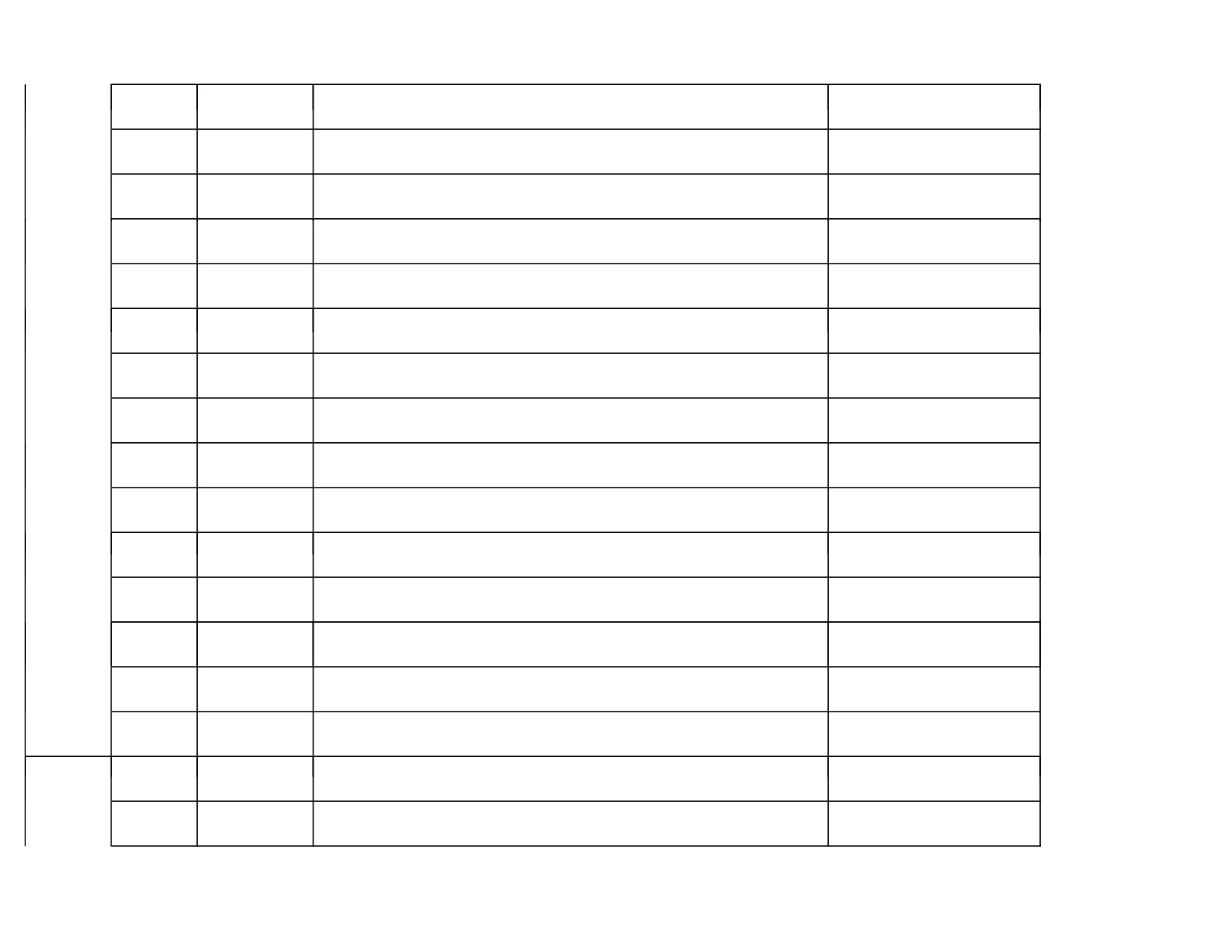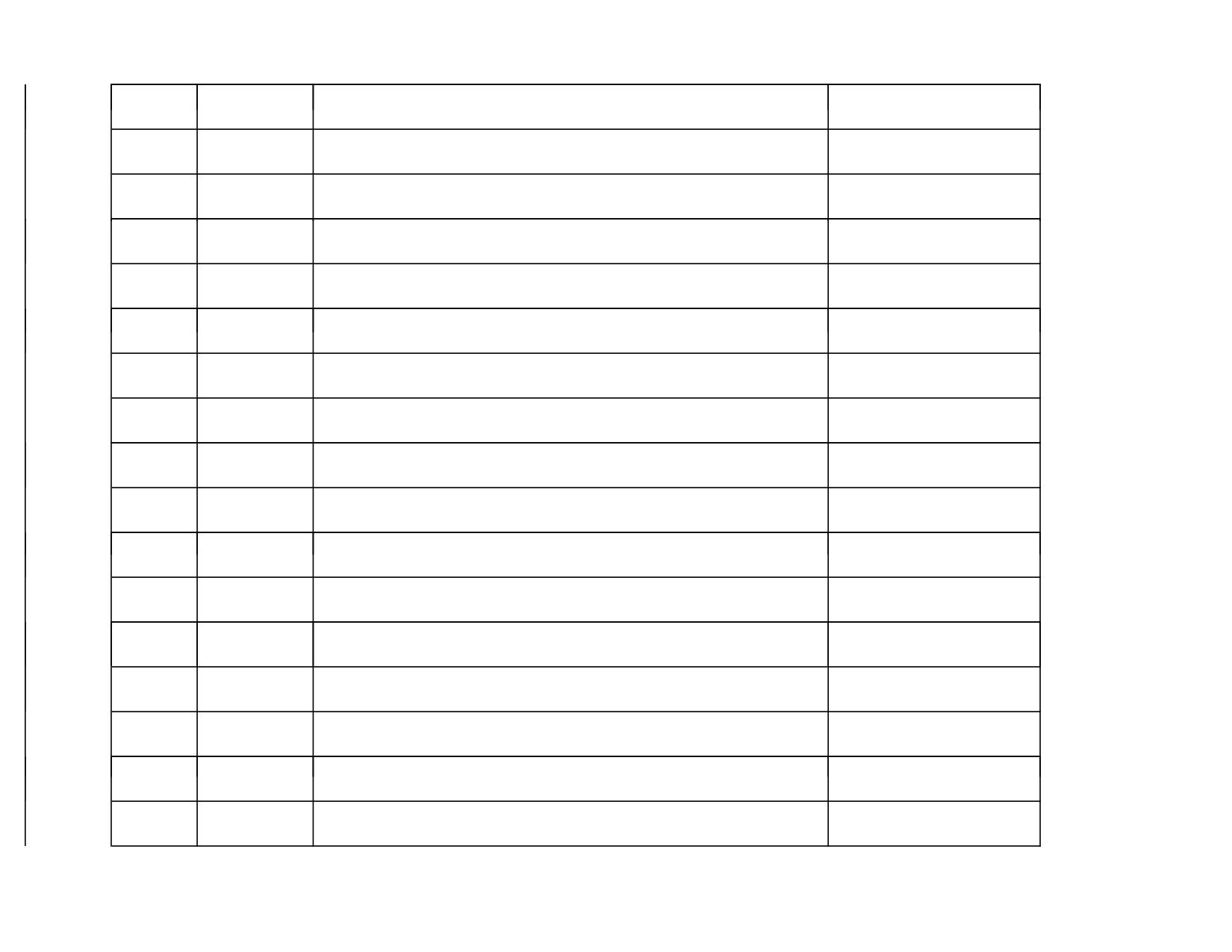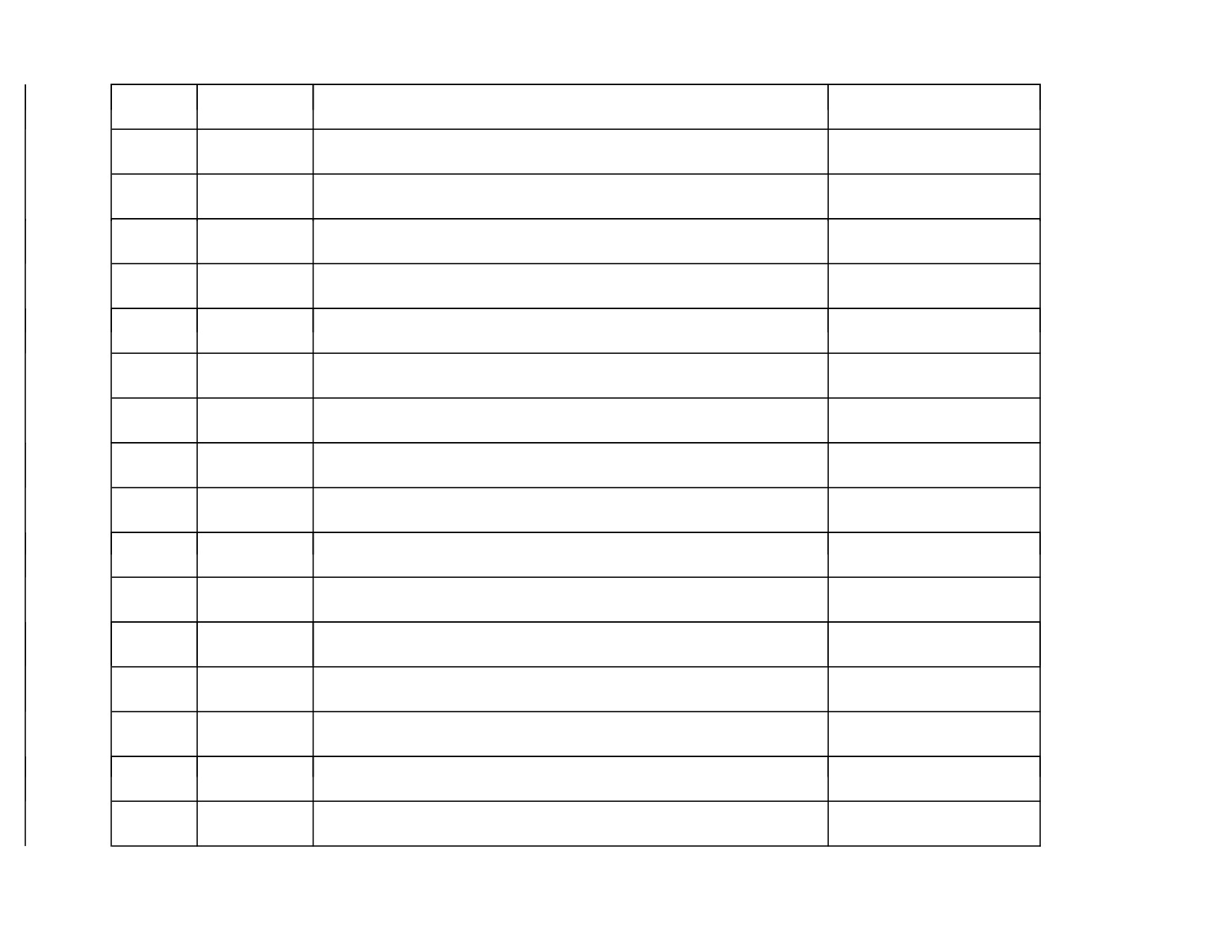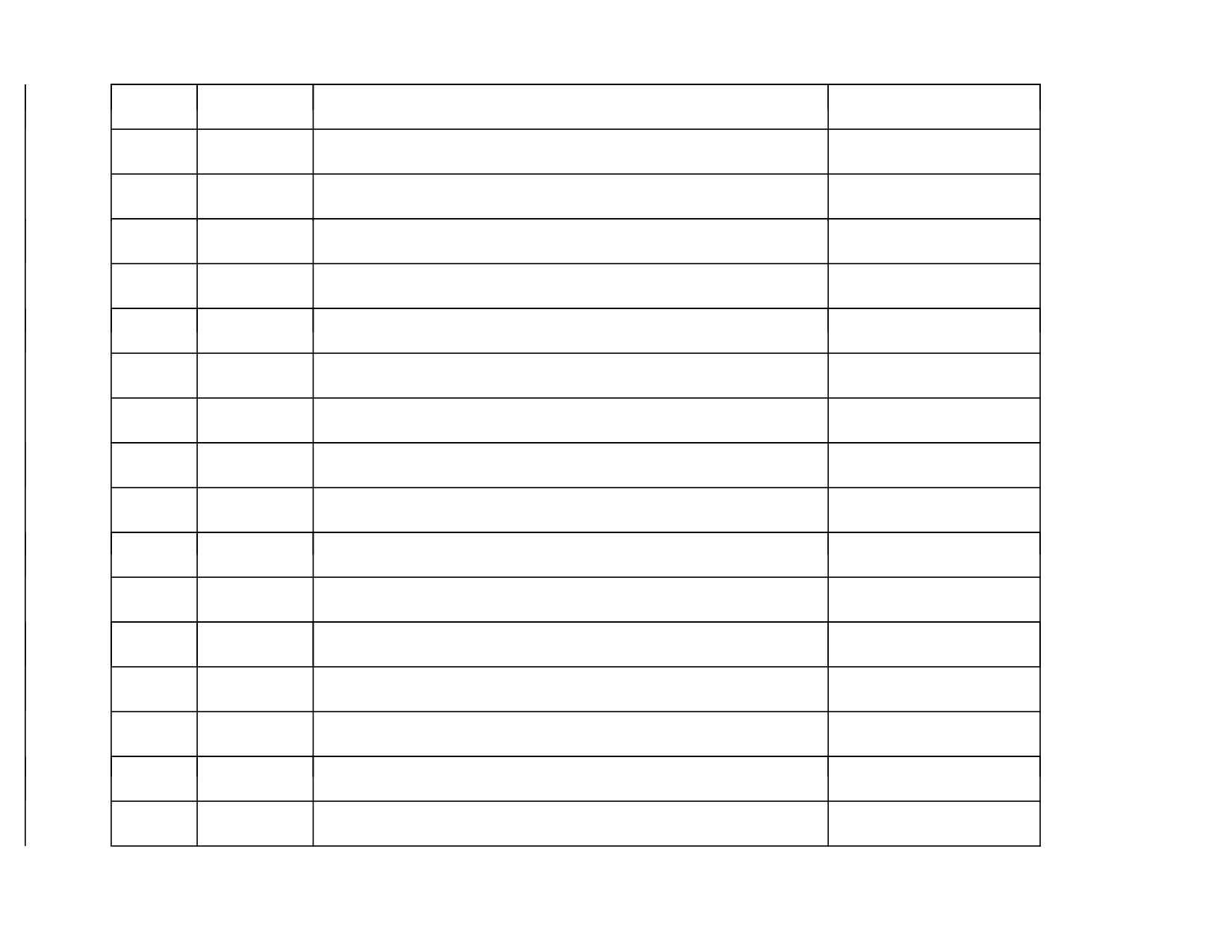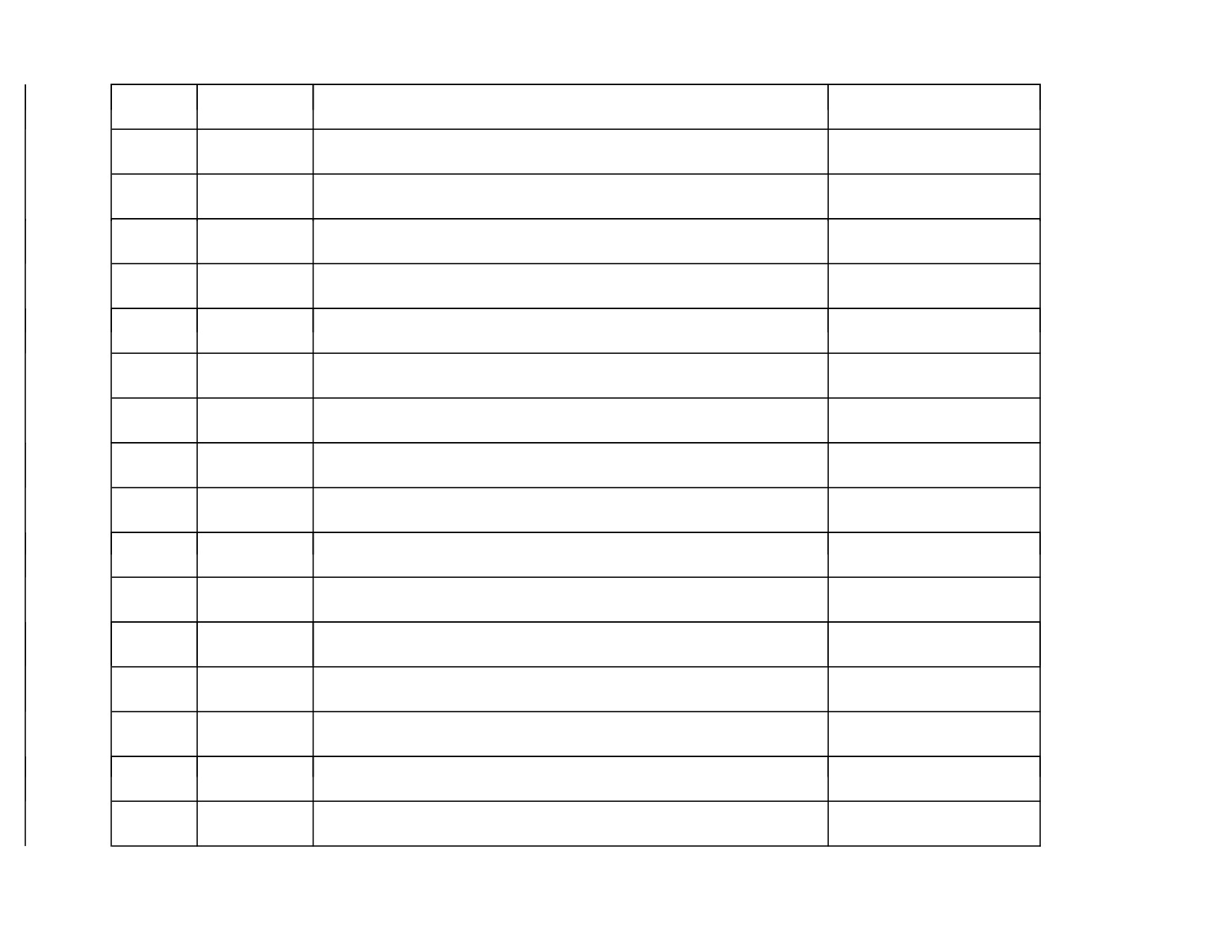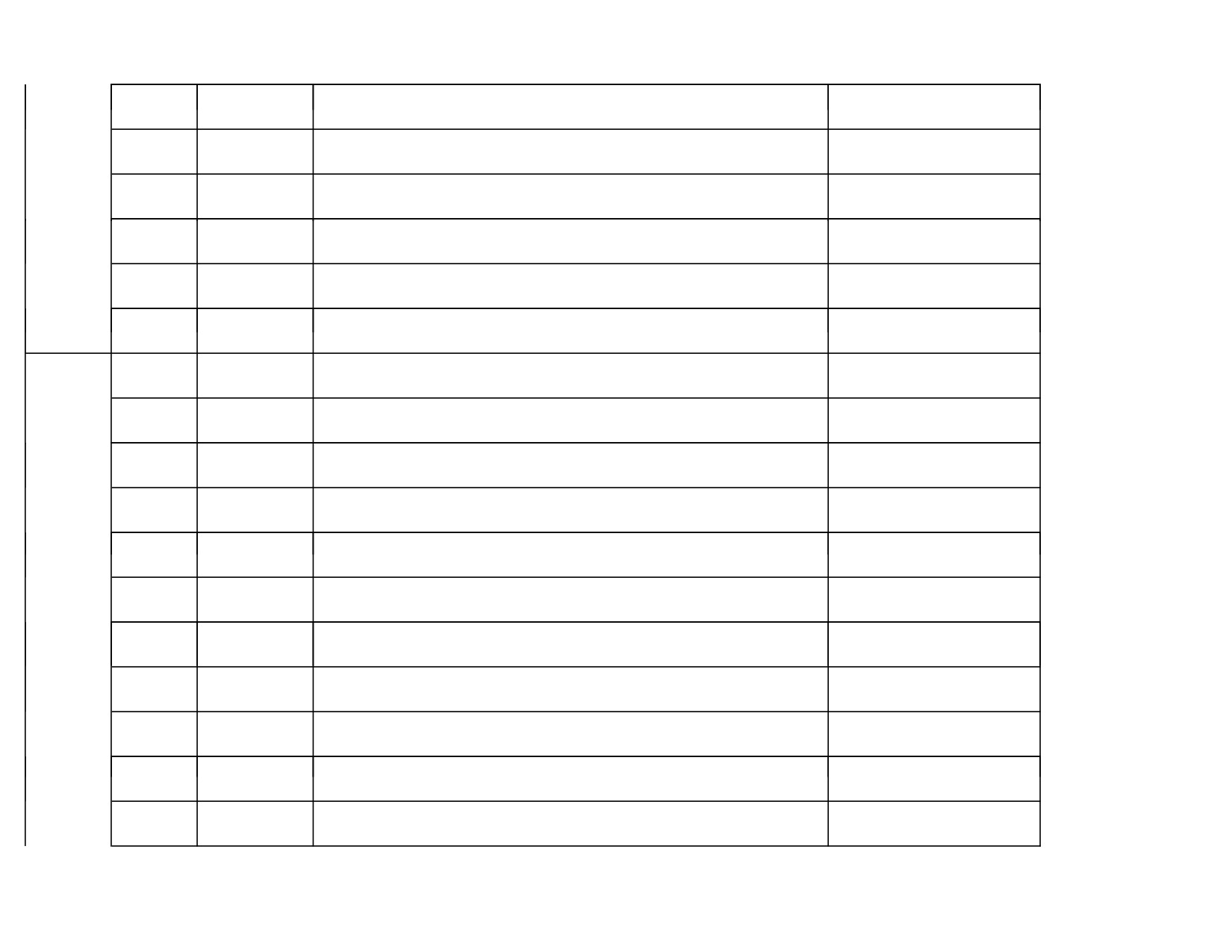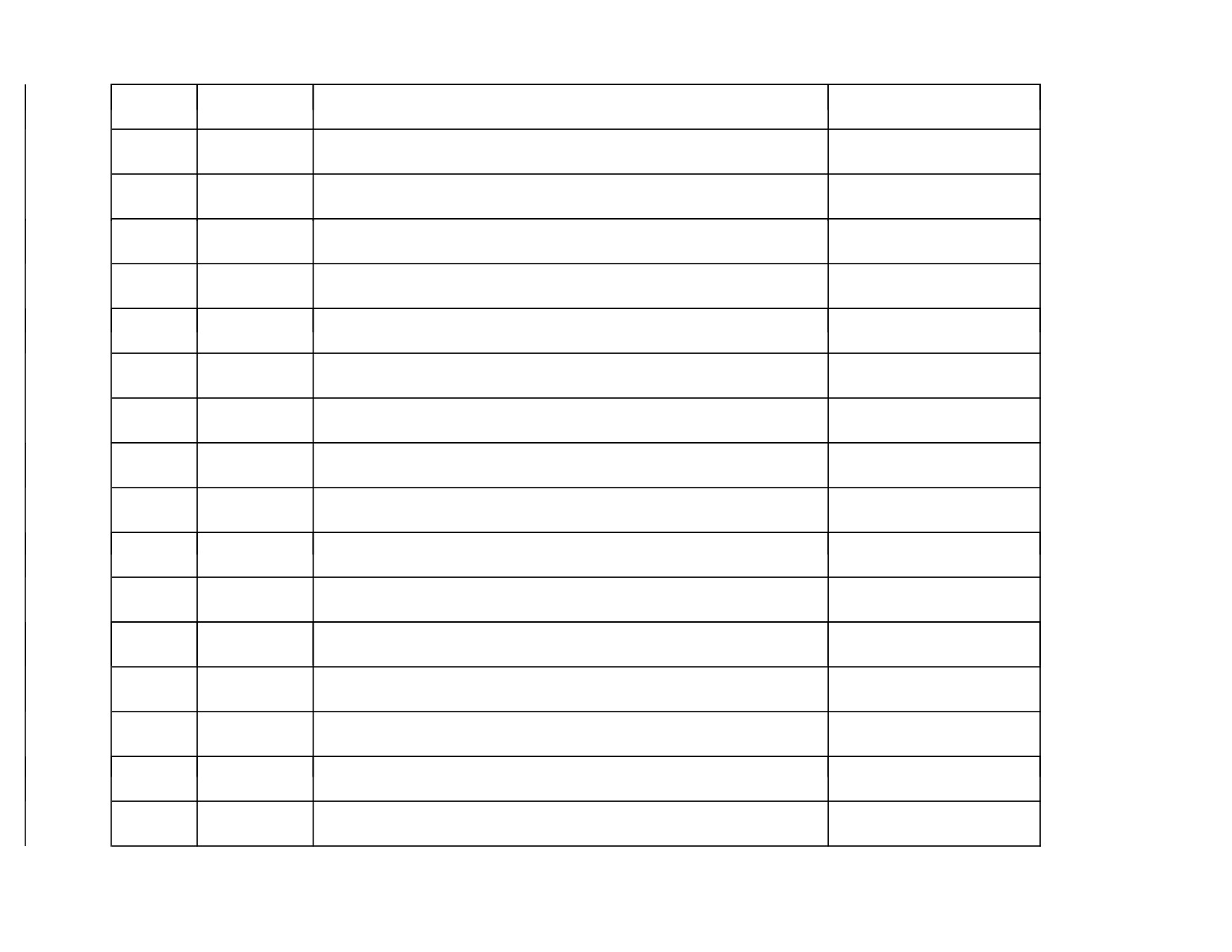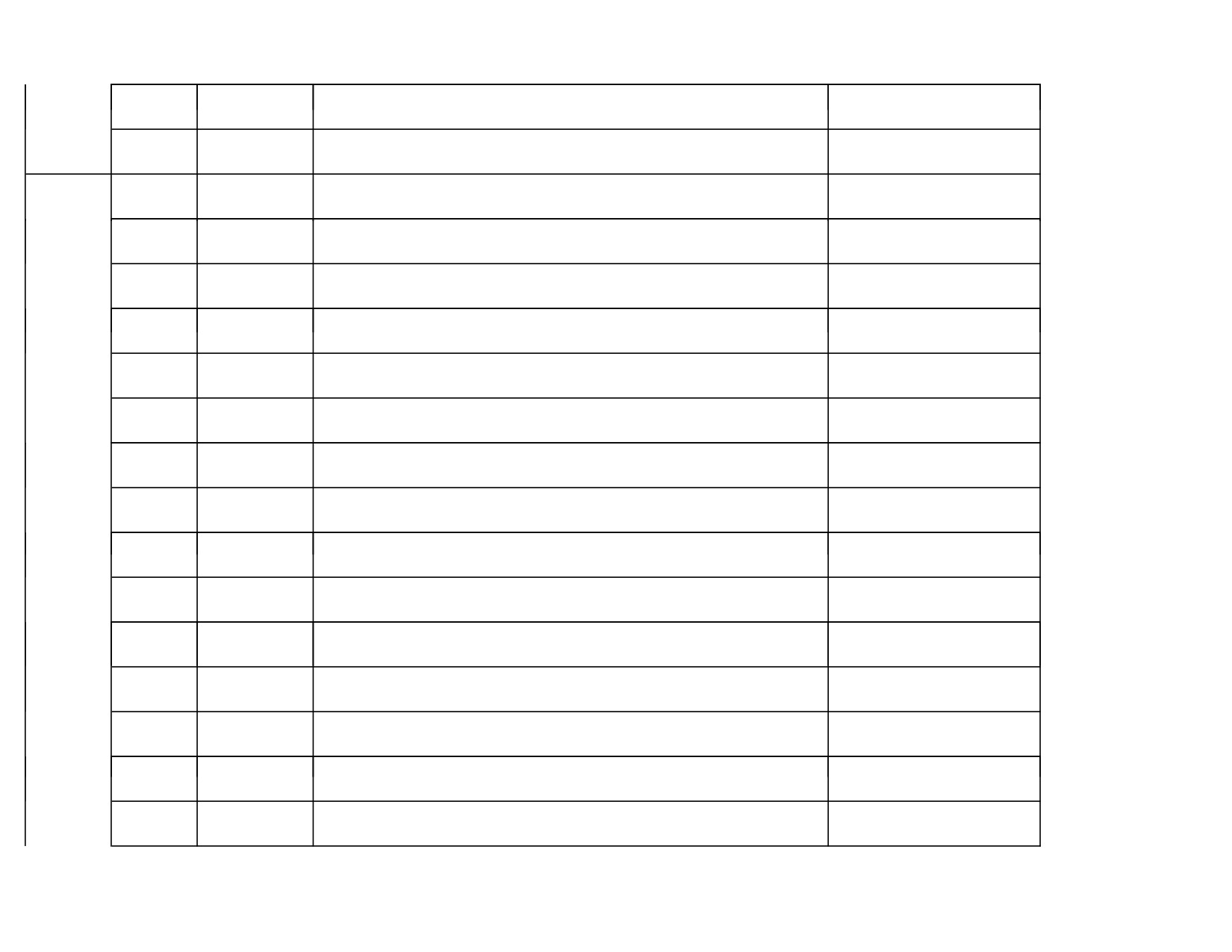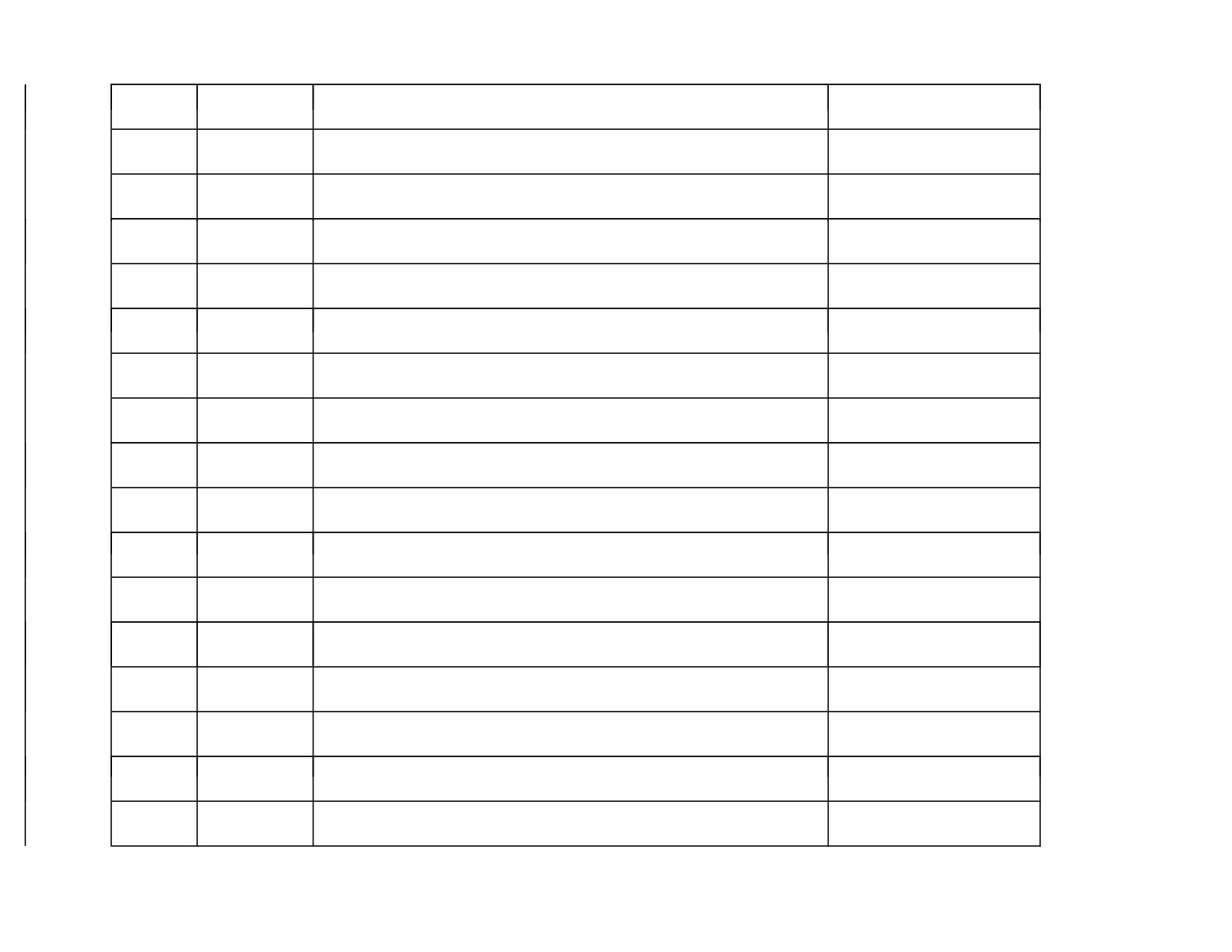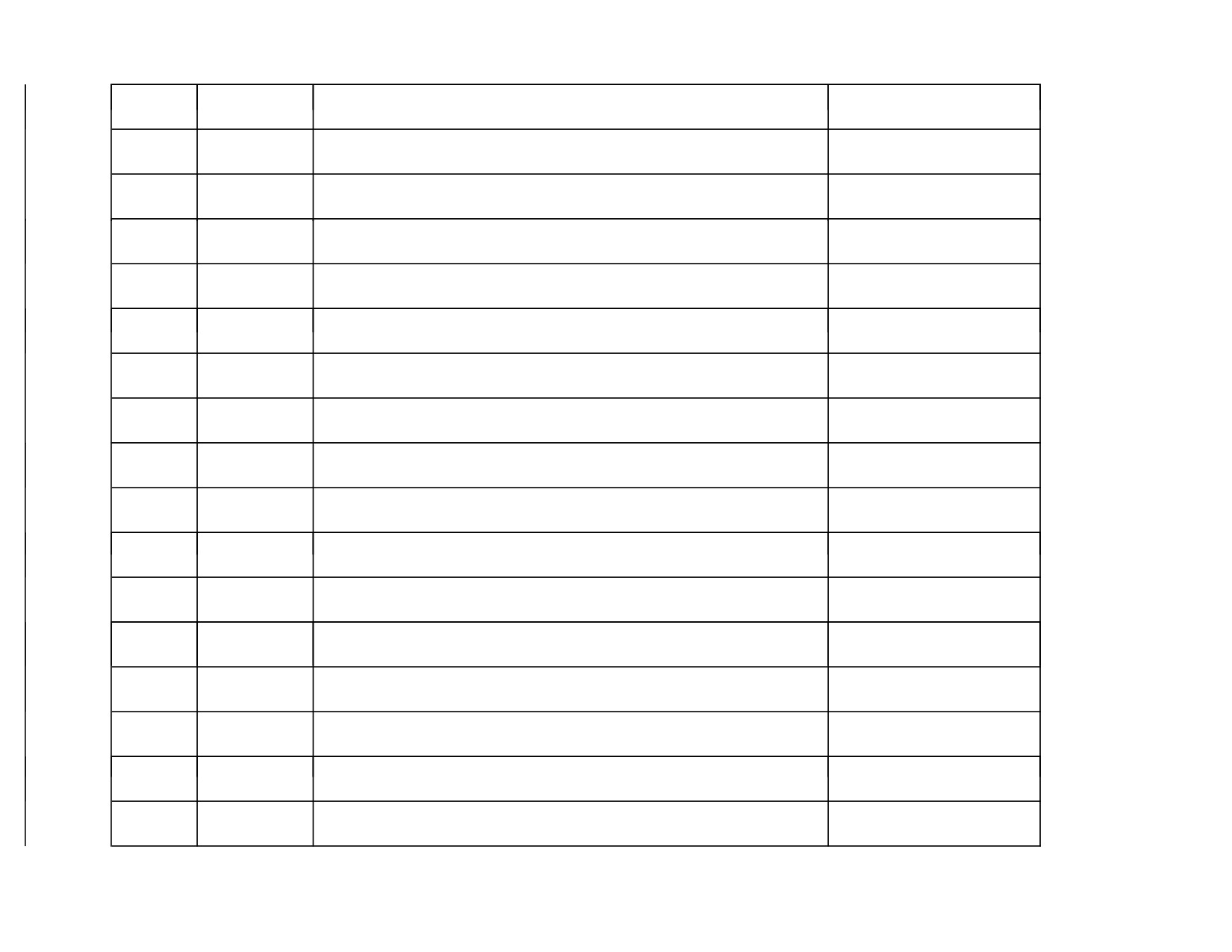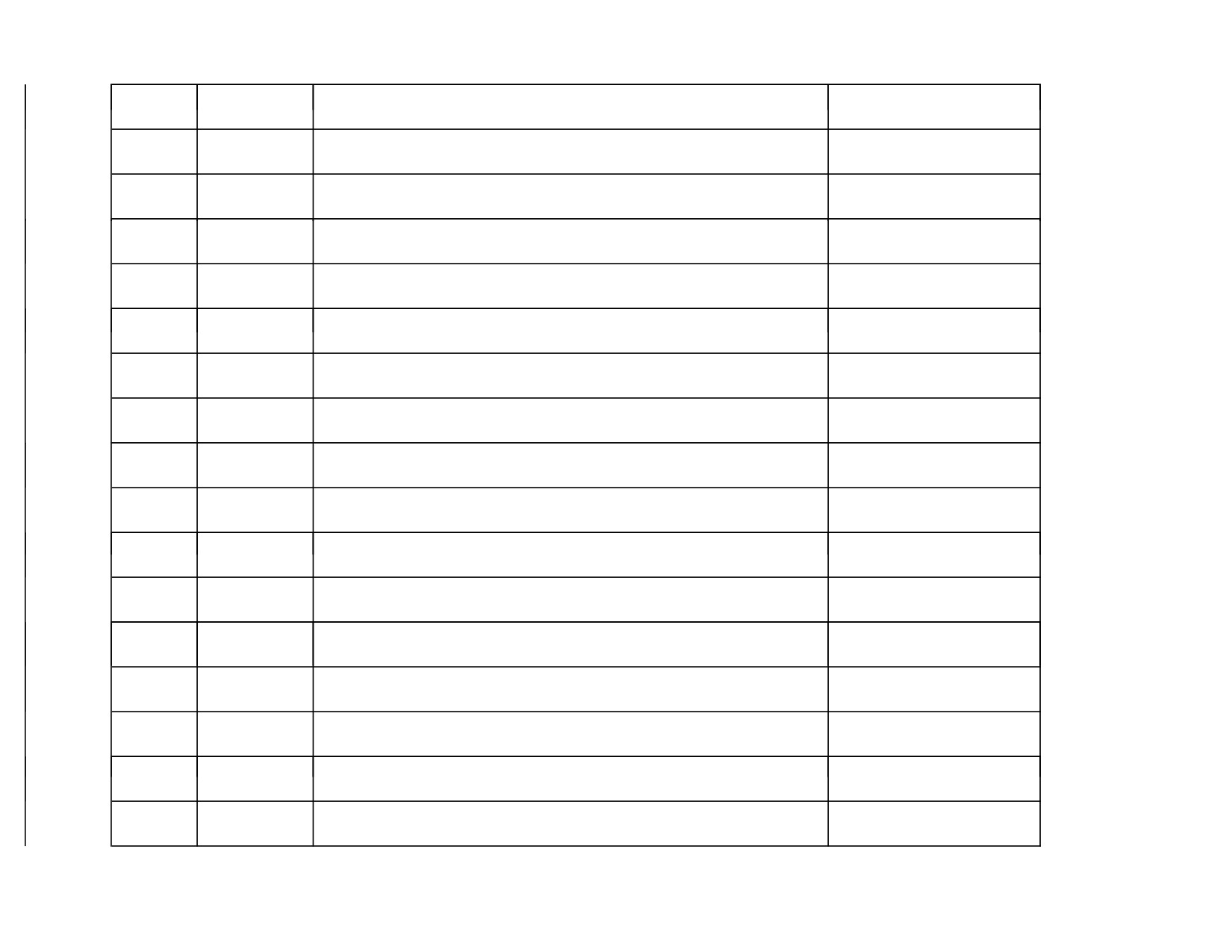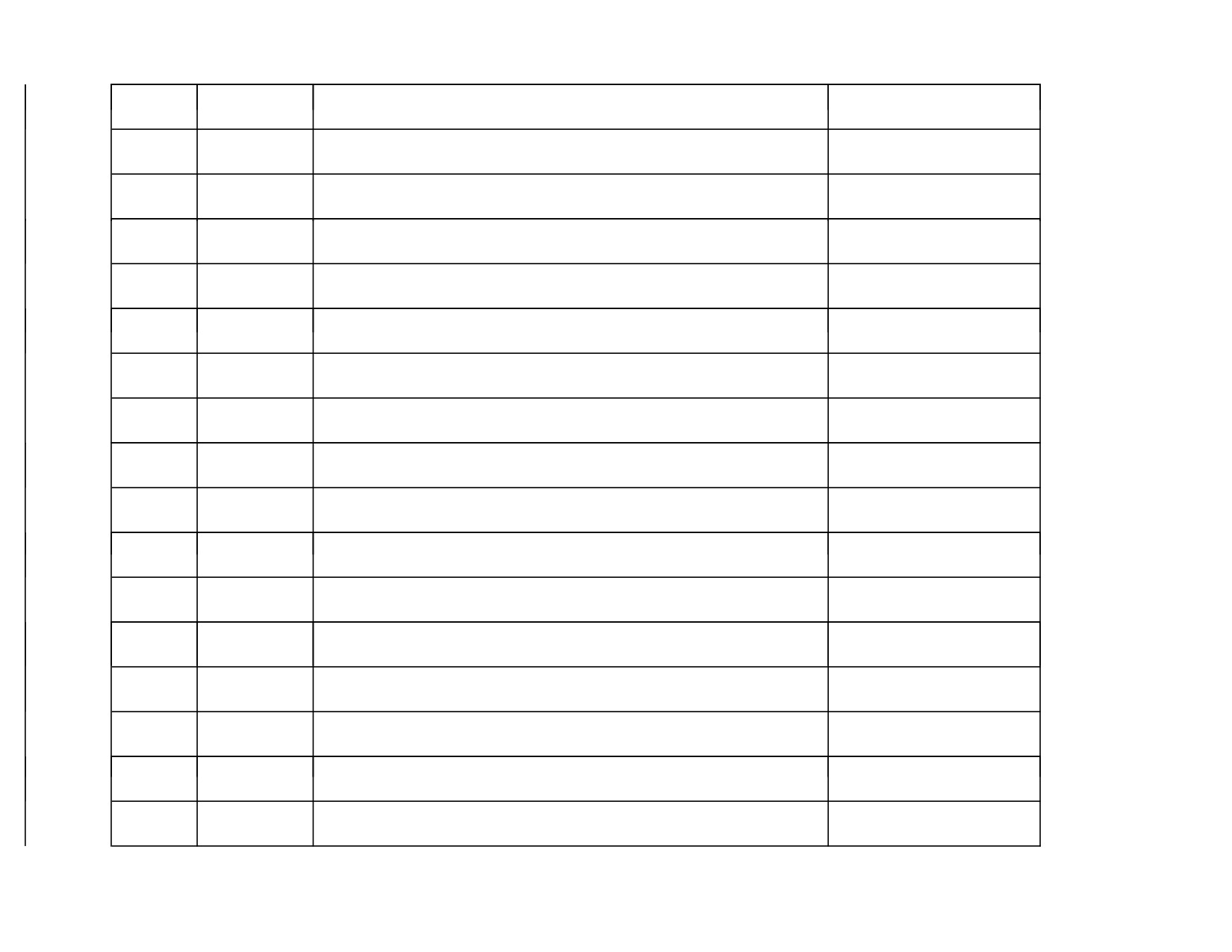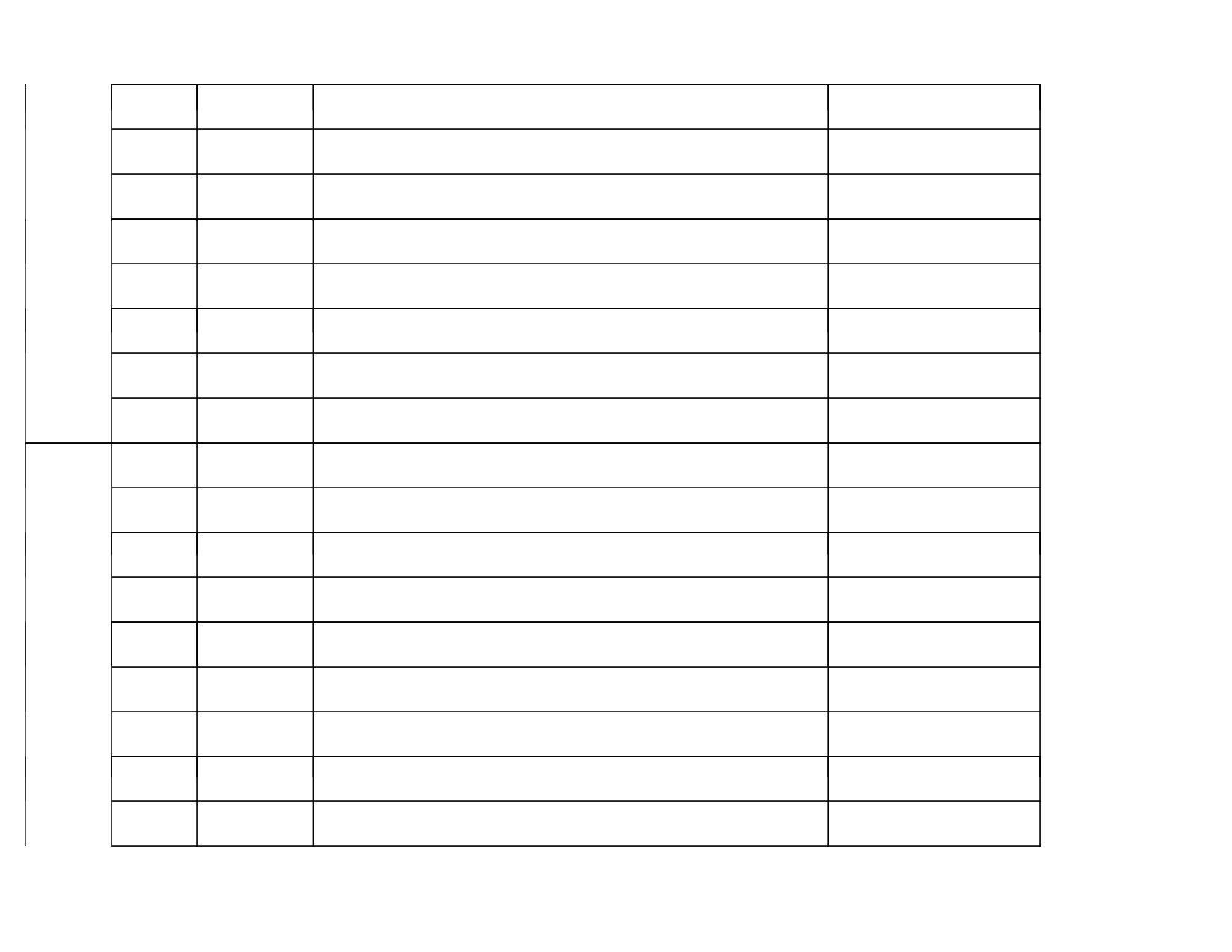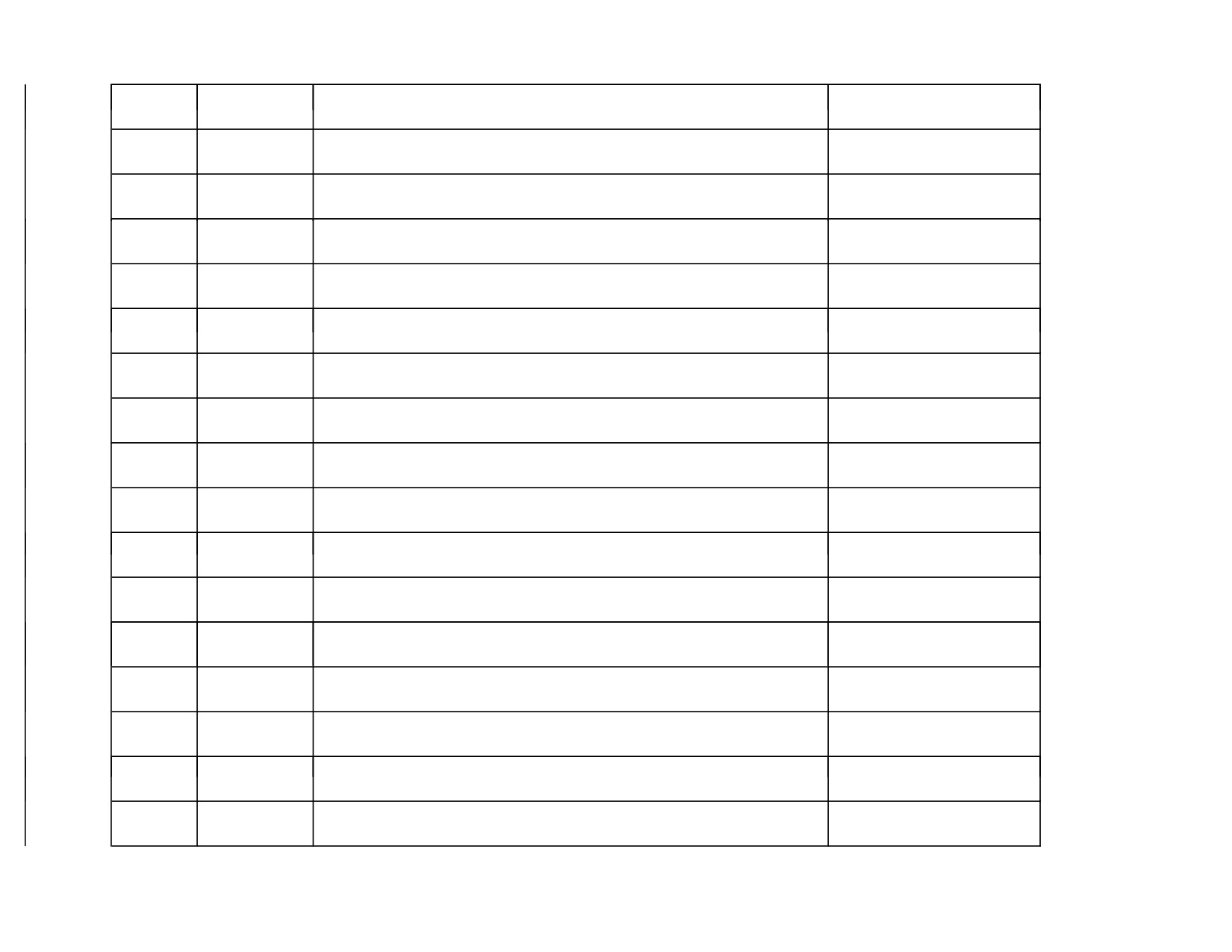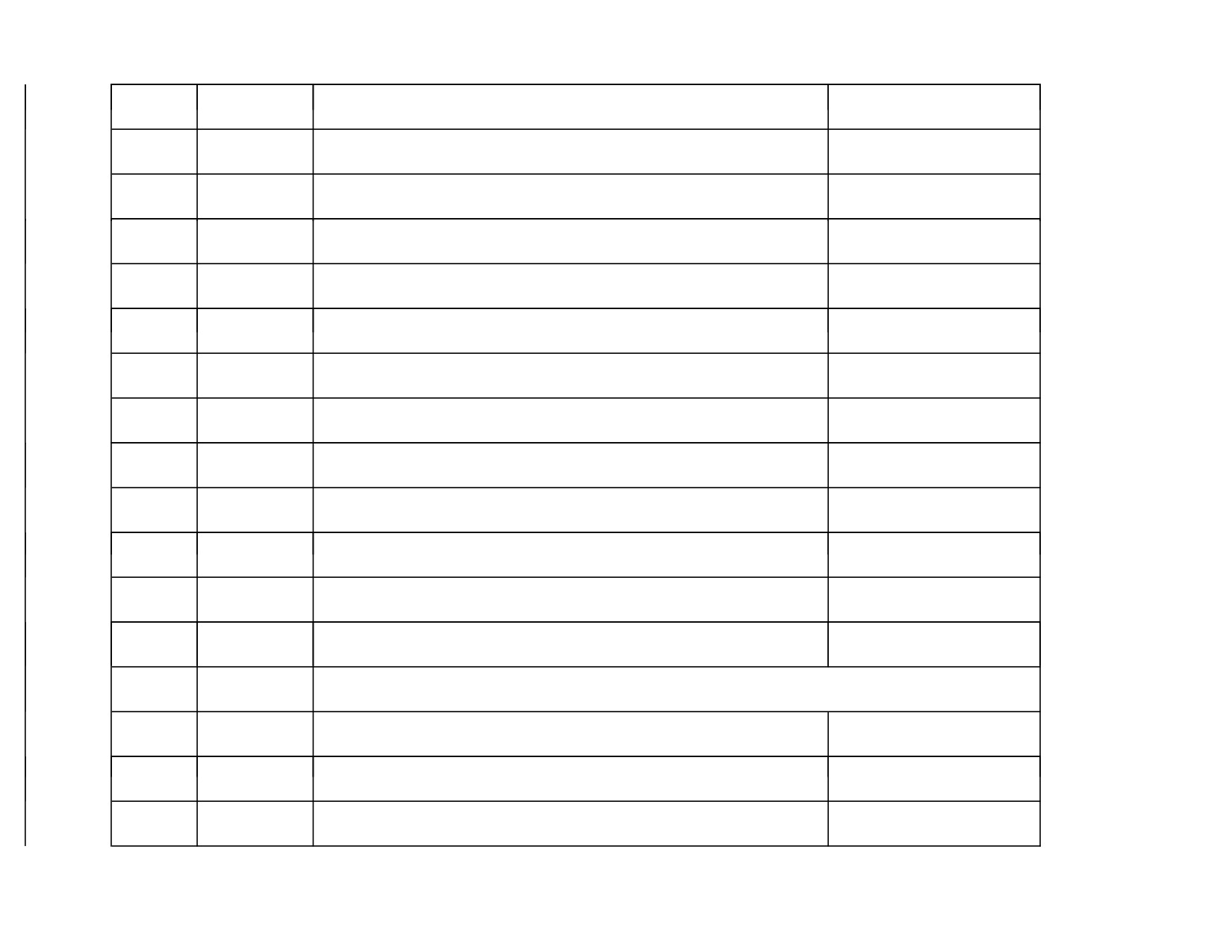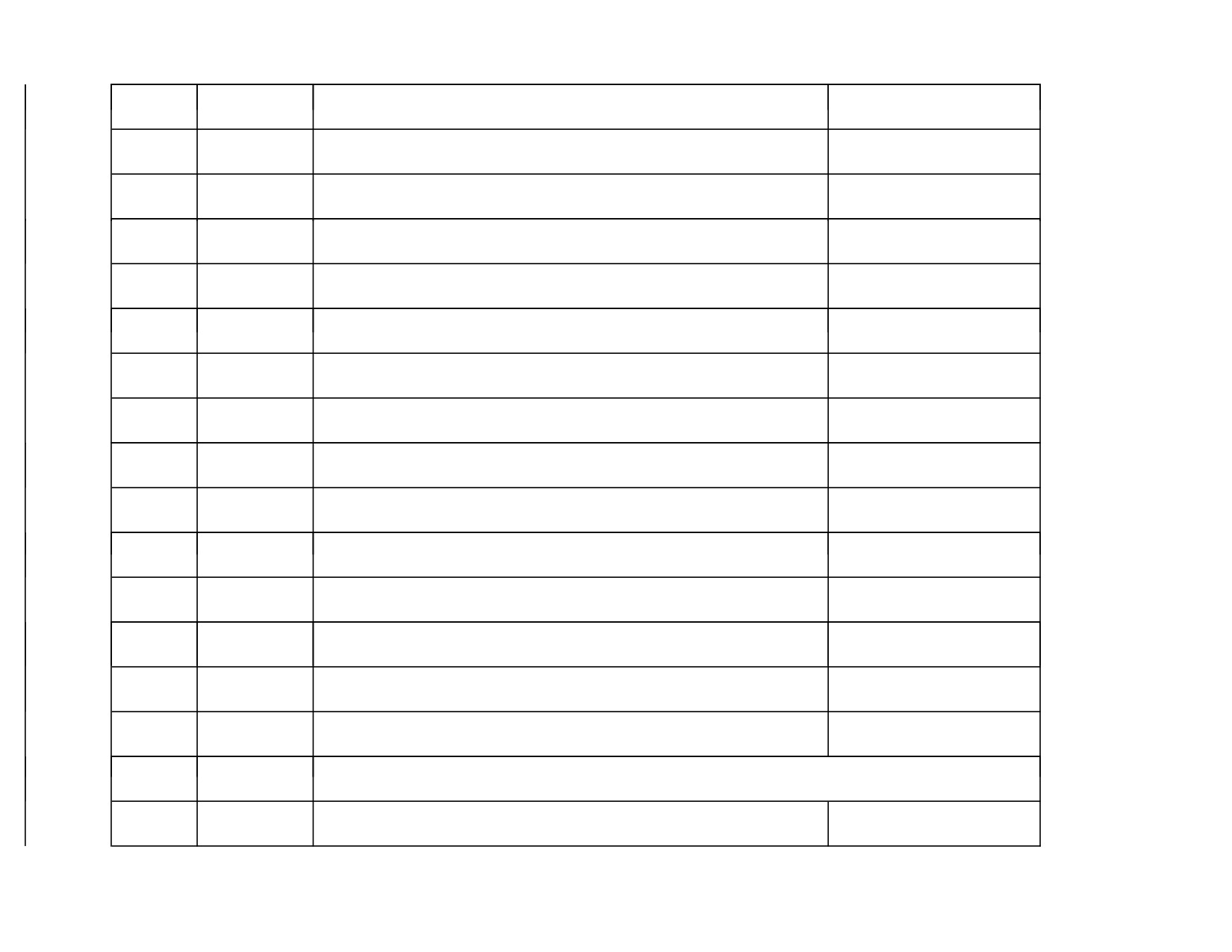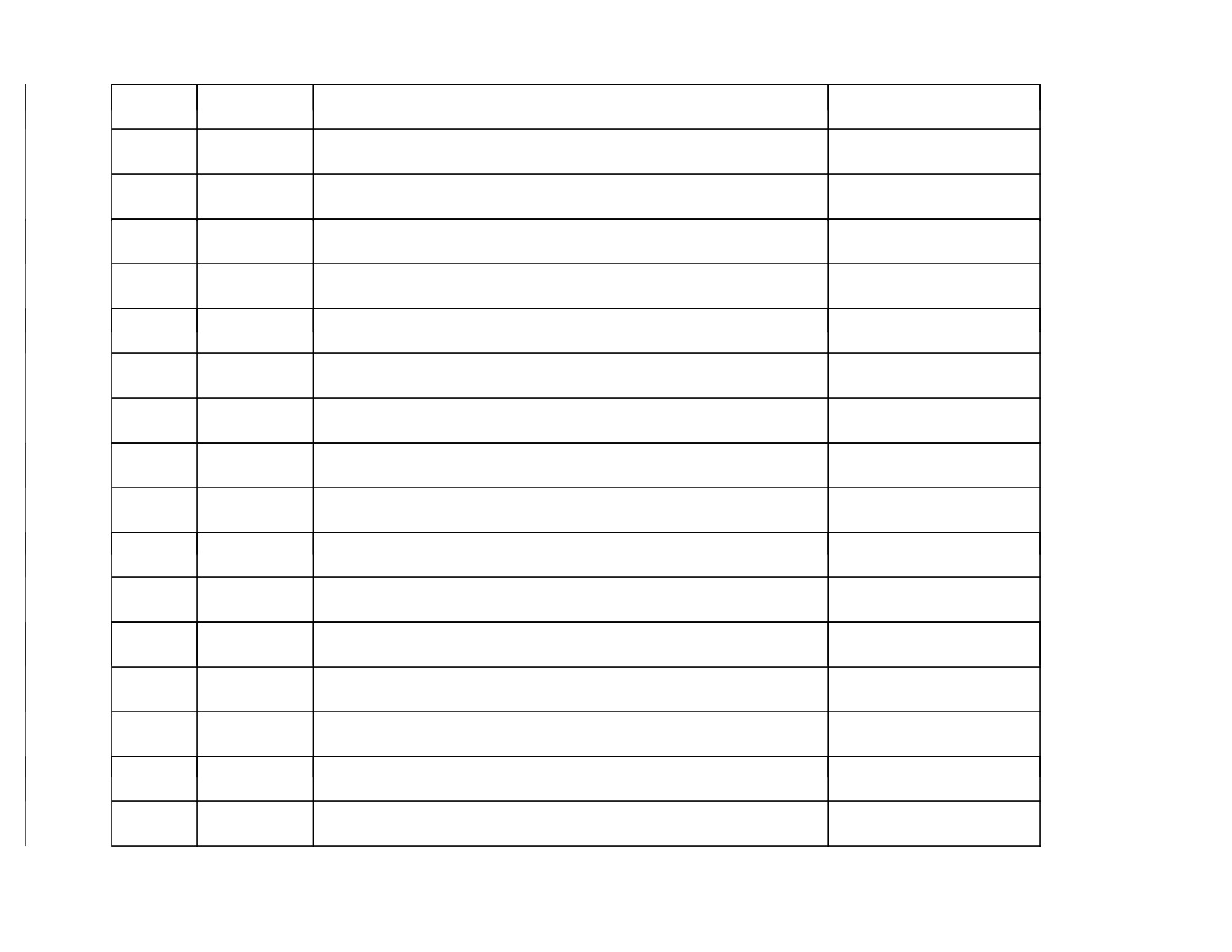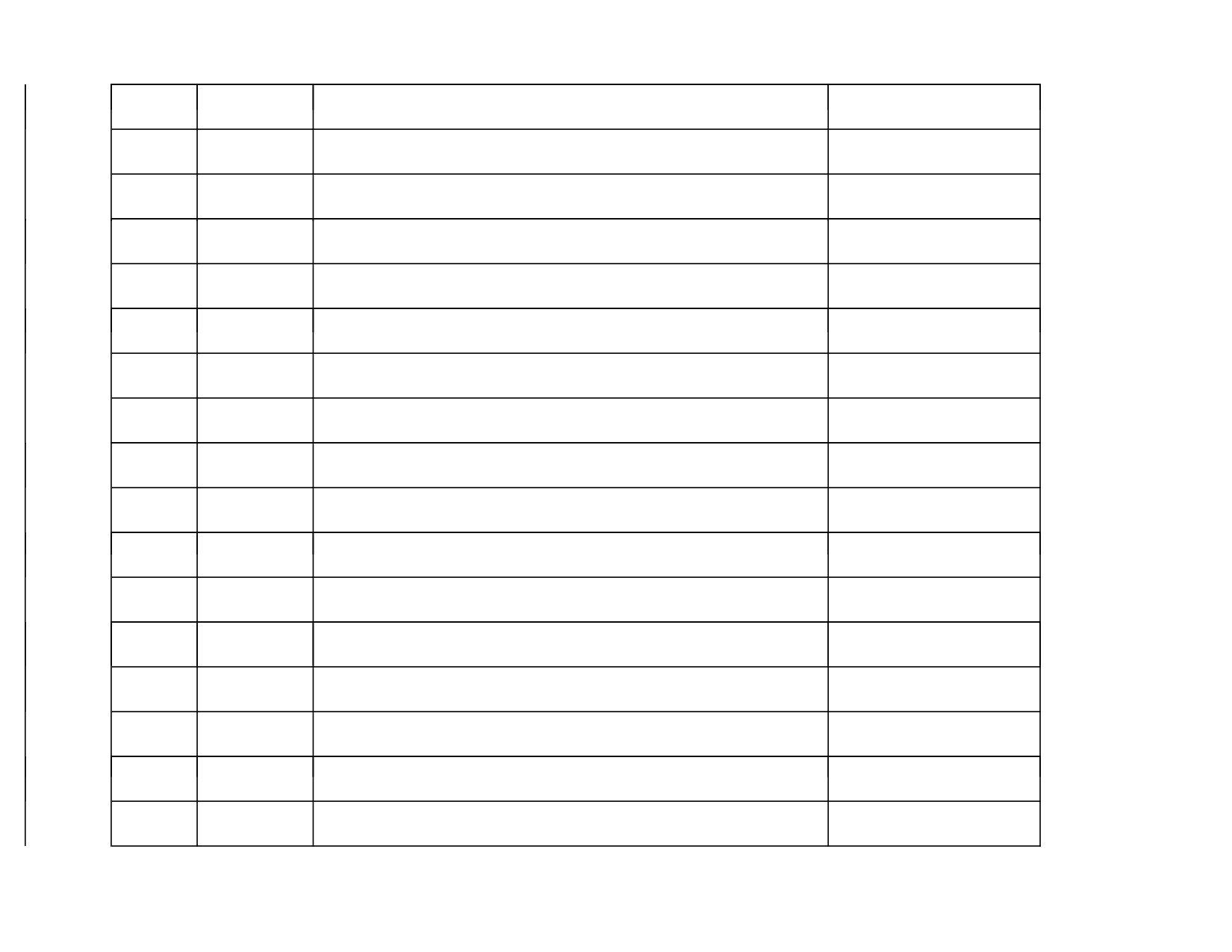Annapoorana Medical College & Hospitals
GENERAL MEDICINE PHASE III PART 1I MBBS LESSON PLAN
CBME UG CURRICULUM
LECTURE
COMPETENCY
TOPIC NO
TITLES:Topic,Competency,Lesson
TEACHING METHODOLOGY
NO
NO
HEART FAILURE
IM 1.8
OBJECTIVES
2.Definition of atrial fibrillation
3.Types of atrial fibrillation
4.Etiology of atrial fibrillation
5.Pathogeneis of atrial fibrillation
6.Diagnosis of atrial fibrillation
7.Management of atrial fibrillation
1
ATRIAL FIBRILLATION
LECTURE
Enumerate the indications for and describe the findings of heart
IM 1.19
failure with the following conditions including: 2D echocardiography, brain
natriuretic peptide, exercise testing, nuclear medicine testing
IM 1.19/SLO
1.Brain natriuretic peptide and its role in heart failure
2. 2D ECHO - indications and interpretation
3.Stress resting and its significance
4.Nuclear medcine testing in heart failure
5. Coronary angiogram - Indications
6.Coronary angiogram procedure
INVESTIGATIONS IN HEART FAILURE - ECHO,STRESS TESTING AND
2
LECTURE
NUCLEAR MEDICINE
3
CORONARY ANGIOGRAM
LECTURE
Elicit document and present an appropriate history
IM 1.10
the diagnosis, cause and severity of heart failure including:
presenting complaints, precipitating and exacerbating factors, risk
OBJECTIVES
1.History for the diagnosis of heart failure
2.Causes for severity of heart failure
3.History of precipitating and exacerbating factors
4.Risk factors of heart failure
5.History regarding sleeping pattern in heart failure
6.History suggestive of infective endocarditis in heart failure
4
HISTORY DOCUMENTATION IN HEART FAILURE
SMALL GROUP DISCUSSION
Perform and demonstrate a systematic examination based on the
IM 1.11
history that will help establish the diagnosis and estimate its severity
including: measurement of pulse, blood pressure and respiratory
OBJECTIVES
1.Demonstrate Vital signs in heart failure
2.Measurement of bloodpressure in heart failure and interpretation
3.JVP measurement and wave patterns in heart failure
4.Peripheral pulsations and their quality
5.Examination of apical impulse in heart failure
6.Cardiac murmurs and gallop in heart failure
7.Demonstration of lung signs in heart failure
8.Demonstration of abdominal distension and hepatosplenomegaly
SMALL GROUP
5
PHYSICAL EXAMINATION IN HEART FAILURE
DISCUSSION/DOAP
Demonstrate peripheral pulse, volume, character, quality and
IM 1.12
variation in various causes of heart failure
OBJECTIVES
1. Peripheral pulse in heart failure
2.Volume and character of pulse forms in heart failure
3.Quality of various pulse forms in heart failure
Measure the blood pressure accurately, recognise and discuss
IM 1.13
alterations in blood pressure in valvular heart disease and other
OBJECTIVES
1.Recording blood pressure
2.Interpretation of Blood pressure alteration in heart failure
3.Blood pressure in valvular heart diseases
4.Blood pressure in cardiac tamponade
SMALL GROUP
6
PULSE AND BLOOD PRESSURE IN CARDIAC FAILURE AND CARDIAC TAMPON
DISCUSSION/DOAP
Demonstrate and measure jugular venous distension
IM 1.14
OBJECTIVES
1.Definition of JVP
2.Wave pattern in JVP
3.Clinical significance of JVP
4.Measurement of JVP and its interpretation
Identify and describe the timing, pitch quality conduction and significance of
IM 1.15
precordial murmurs and their variations
OBJECTIVES
1.Definition of murmur
2.Various types of murmurs
3.Identification of systolic and diastolic murmurs
4.Interpretation of murmurs
5.Variations in intensity of the murmurs
SMALL GROUP
7
JVP AND MURMURS IN HEART FAILURE
DISCUSSION/DOAP
Generate a differential diagnosis based on the clinical presentation
IM 1.16
and prioritise it based on the most likely diagnosis
OBJECTIVES
1.Differential diagnosis of heart failure
2. Clinical presentation for the differential diagnosis
Order and interpret diagnostic testing based on the clinical
IM 1.17
diagnosis including 12 lead ECG, Chest radiograph, blood cultures
1
OBJECTIVES
1.Definition of ECG
3.ECG interpretation in heart failure
4.Chest radiography interpretation in heart failure
5.Blood investigations including culture in heart failure
8
DIFFERENTIAL DIAGNOSIS AND INVESTIGATIONS IN HEART FAILURE
SMALL GROUP DISCUSSION
IM 1.18
Perform and interpret ECG
OBJECTIVES
1.Definition of ECG
2.Wave pattern in ECG
3.Recording ECG
4.Damping , underdamping and isoelectric line in ECG
5.Interpretation of ECG - Axis ,Heart rate calculation and Rhythm abnormalities
6.Interpretation of ECG - Chamber hypertrophy and conduction abnormalities
7.Interpretation of ECG -ischemia and infarction
9
ECG
LECTURE /SGD
Describe and discuss and identify the clinical features of acute and
IM 1.21
subacute endocarditis, echocardiographic findings, blood culture
and sensitivity and therapy
OBJECTIVES
1.Definition of acute and subacute endocarditis
2.Etiology
3.Clinical features of infective endocarditis
4.ECHO findings
5.Blood culture and sensitivity
6.Therapy
Assist and demonstrate the proper technique in collecting specimen
IM 1.22
for blood culture
OBJECTIVES
1.Technique of collection of blood sample for endocarditis
10
INFECTIVE ENDOCARDITIS
LECTURE
Describe, prescribe and communicate non pharmacologic
IM 1.23
management of heart failure including sodium restriction, physical
activity and limitations
OBJECTIVES
1.Dietary advice - salt restricted diet and rich potassium diet
2.Lifestyle modification
Describe and discuss the pharmacology of drugs including
IM 1.24
indications, contraindications in the management of heart failure
including diuretics, ACE inhibitors, Beta blockers, aldosterone
OBJECTIVES
1.Drug therapy - Diuretics,ACE inhibitors,Beta blockers,Aldosterone
anatgonists and cardiac glycosides
2.Drug doses and half life of the drugs
3.Drug side effects
4.Indications and contraindications of drug therapy
Develop document and present a management plan for patients with
IM 1.26
heart failure based on type of failure, underlying aetiology
OBJECTIVES
1.Management plan of heart failure
2.Management based on etiology
11
PHARMACOLOGICAL AND NON -PHARMACOLOGICAL THERAPY IN HEART F
LECTURE
PHARMACOLOGY
Enumerate the indications for valvuloplasty, valvotomy, coronary
IM 1.25
revascularization and cardiac transplantation
OBJECTIVES
1.Valvuloplasty - Procedure and its indications
2.Valvotomy - Procedure and its indications
3.Coronary revascularisation - Procedure and its indications
4.Cardiac transplantation - Procedure and its indications
12
INTERVENTIONAL MANAGEMENT OF HEART FAILURE
LECTURE
Enumerate the causes of adult presentations of congenital heart
IM 1.28
disease and describe the distinguishing features between cyanotic
and acyanotic heart disease
OBJECTIVES
1.Adult presentation of congenital heart disease
2.Difference between cyanotic and acyanotic heart disease
Elicit document and present an appropriate history, demonstrate
IM 1.29
correctly general examination, relevant clinical findings and
formulate document and present a management plan for an adult
OBJECTIVES
1.History and examination
2.clinical features
3.Management
13
CONGENITAL CYANOTIC HEART DISEASES
LECTURE
14
CONGENITAL ACYANOTIC HEART DISEASES
LECTURE
Administer an intramuscular injection with an appropriate
IM 1.30
explanation to the patient
OBJECTIVES
1. Technique for intramuscular injection
2.Sterile precautions before intramuscular injection
3.Test dosing method
3.Complications of intramuscular injection
4.Early identification of anaphylaxis and its management
15
INTRAMUSCULAR INJECTION
DOAP SESSION
PHARMACOLOGY
TOPIC
ACUTE MYOCARDIAL INFARCTION/IHD
Discuss and describe the epidemiology, antecedents and risK
IM 2.1`
factors for atherosclerosis and ischemic heart disease
OBJECTIVES
1.Epidemiology
2.Risk factors
Discuss the aetiology of risk factors both modifiable and non modifiable risk
IM 2.2
factors.Discuss the aetiology of risk factors both modifiable and non modifiable
of atherosclerosis and IHD
OBJECTIVES
1.Etiology
2.Modifiable and non modifiable risk factors
16
ATHEROSCLEROSIS AND IHD- ETIOLOGY AND RISK FACTORS
LECTURE
Discuss and describe the lipid cycle and the role of dyslipidemia in
IM 2.3
the pathogenesis of atherosclerosis
OBJECTIVES
1.Lipid cycle
2.Role of dyslipidemia in atherosclerosis
Discuss and describe the pathogenesis natural history, evolution
IM 2.4
and complications of atherosclerosis and IHD
OBJECTIVES
1.Patholgy and clinical evolution
2.Complications
Choose and interpret a lipid profile and identify the desirable lipid
IM 2.12
pro=ile in the clinical context
OBJECTIVES
1.Interpretation of Lipid profile
Discuss and describe the indications, formulations, doses, side
IM 2.18
effects and monitoring for drugs used in the management of
dyslipidemia
OBJECTIVES
1.Drug dosing,indications
2.Side effects
3.Monitoring of drugs in dyslipidemia
17
LIPID CYCLE AND DYSLIPIDEMIA - CLINICAL PRESENTATION AND MANAGE
LECTURE/DOAP
Define the various acute coronary syndromes and describe their
IM 2.5
evolution, natural history and outcomes
OBJECTIVES
1.Acute coronary syndrome- types
2.Natural history
3.Outcomes
Elicit document and present an appropriate history that includes onset
IM 2.6
evolution, presentation risk factors, family history, comorbid conditions,
complications, medication, history of atherosclerosis, IHD and coronary
OBJECTIVES
1.History of atherosclerosis
2.Risk factors of CAHD
3. Comorbid conditions and complications
Perform, demonstrate and document a physical examination including a
IM 2.7
vascular and cardiac examination that is appropriate for the clinical
presentation
OBJECTIVES
1.Examination of CVS
2. Clinical findings Interpretation
Generate document and present a differential diagnosis based on the clinical
IM 2.8
presentation and prioritise based on “cannot miss”, most likely diagnosis and
OBJECTIVES
1. Differential diagnosis
2.Final diagnosis and severity
18
ACUTE CORONARY SYNDROMES - INTRODUCTION AND HISTORY TAKING
LECTURE
19
ACUTE COROINARY SYNDROMES - EXAMINATION AND DIFFERENTIAL DIAG
LECTURE
Distinguish and differentiate between stable and unstable angina and AMI
IM 2.9
based on the clinical presentation
OBJECTIVES
2.Angina - definition
3. unstable angina
Clinical differentiation between angina and Unstable angina
20
ANGINA - CLINICAL PRESENTATION
SMALL GROUP DISCUSSION
IM 2.10
Order, perform and interpret an ECG
OBJECTIVES
1. RECORDING ECG
2. Interpretation of ECG in Myocardial infarction
IM 2.11
Order and interpret a Chest X-ray and markers of acute myocardial infarction
OBJECTIVES
1.Interpretation of chest Xray
2.Interpretation of markers in MI
21
INVESTIGATIONS - MYOCARDIAL INFRACTION
LECTURE
Discuss and enumerate the indications for and findings on echocardiogram,
IM 2.13
stress testing and coronary angiogram
OBJECTIVES
1.Indications for Echocardiogram
2
2. interpretation of echocardiogram
3. indication for stress testing
4. contraindication for stress testing
5.Indications for coronary angiogram
6.contraindication for coronary angiogram
7.preparation of patient for coronary angiogram
8.interpretation of coronary angiogram report
22
ECHOCARDIOGRAM STRESS TESTING IN CAD
SGD/ LECTURE
23
CORONARY ANGIOGRAM IN CAD
SGD/ LECTURE
Discuss and describe the indications for admission to a coronary care unit and
IM 2.14
supportive therapy for a patient with acute coronary syndrome
OBJECTIVES
1.Admission criteria for ACS
2.Supportive therapy in ACS
SMALL GROUP
24
ACS - ADMISSION CRITERIA ,INVESTIGATIONS AND SUPPORTIVE THERAPY
DISCUSSION/DOAP
Discuss and describe the medications used in patients with an acute coronary
IM 2.15
syndrome based on the clinical presentation
OBJECTIVES
1.drugs used in intensive coronary care unit
2.life saving drugs in the coronary care unit
3.Pharmacological therapy in ACS
25
MANAGEMENT OF ACS IN INTENSIVE CORONARY CARE UNIT
LECTURE/SGD
IM 2.16
Discuss and describe the indications for acute thrombolysis, PTCA and CABG
OBJECTIVES
1.Thrombolytic therapy - Indications and contraindications
2. drugs used for thrombolytic therapy
3. dose and side effect of drugs in thrombolytic therapy
4. Indications for PTCA
5. indication for CABG
26
MANAGEMENT OF ACS - THROMBOLYTIC THERAPY , PTCA , CABG
IM 2.17
Discuss and describe the indications and methods of cardiac rehabilitation
Counsel and communicate to patients with empathy lifestyle changes in
IM2.24
atherosclerosis / post coronary syndromes
OBJECTIVES
1.Indications of cardiac rehabilitation
2.Methods of cardiac rehabilitation
3.Dietary advice
4. LIFE STYLE MODIFICATION in ACS
27
CARDIAC REHABILITATION IN ACS
SGD
IM 2.20
Discuss and describe the assessment and relief of pain in acute coronary syndromes
OBJECTIVES
1.Pain management in ACS
2.Drugs used for relief of pain in ACS
3. indication and contraindication of the drug
1. Pharmacalogical therapy - indications and contraindications
Describe and discuss the indications for nitrates, anti platelet agents,
IM2.23
gpIIb IIIa inhibitors, beta blockers, ACE inhibitors etc in the management
1.indications for nitrates
2.drugs used in acute coronary syndrome - beta blockers, ACE inhibitors
3. uses of antiplatelet drugs and their side effects
28
PHARMACOLOGICAL MANAGEMENT OF ACS
LECTURE/SGD
PHARMACOLOGY
Discuss and describe the pathogenesis, recognition and management of
IM 2.19
complications of acute coronary syndromes including arrhythmias, shock, LV
dysfunction, papillary muscle rupture and pericarditis
OBJECTIVES
1. acute complication of ACS
2.chronic complication of acs
3.Pathogenesis of complications in ACS
4. clinical findings of complications and management of complications
29
ACS - COMPLICATIONS AND MANAGEMENT
LECTURE/SGD
Observe and participate in a controlled environment an ACLS program
IM 2.21
OBJECTIVES
1.Current ACLS guidelines 2020
2.Drugs used in ACLS protocol
3. Cardiac arrest Revival
SMALL GROUP
30
ACS- ACLS PROGRAMME
DISCUSSION/DOAP
Perform and demonstrate in a mannequin BLS
IM 2.22
OBJECTIVES
1.Clinical significance of BLS
2.Steps in BLS
3.Demonstration of BLS
SMALL GROUP
31
ACS- MANNEQUIN BLS PROGRAMME
DISCUSSION/DOAP
TOPIC
PNEUMONIA
Define, discuss, describe and distinguish community acquired pneumonia,
IM 3.1
nosocomial pneumonia and aspiration pneumonia
OBJECTIVES
1.Difference and clinical presentation of community acquired pneumonia,
nosocomial pneumonia,aspiration pneumonia
Discuss and describe the aetiologies of various kinds of pneumonia and their
IM 3.2
microbiology depending on the setting and immune status of the host
OBJECTIVES
1) Etiology of pneumonia
2)organisms that causes pneumonia
3)Immune status of the host
Discuss and describe the pathogenesis, presentation, natural history and
IM 3.3
complications of pneumonia
OBJECTIVES
1.History of pneumonia
2.Clinical features
3.Pathogenesis
4.Complications OF Pneumonia
32
PNEUMONIA - CLASSIFICATION ,ETIOLOGY AND PATHOGENESIS
LECTURE
33
CLINICAL PRESENTATION OF VARIOUS TYPES OF PNEUMONIA
LECTURE
COMPLICATIONS OF PNEUMONIA
Elicit document and present an appropriate history including the evolution,
IM 3.4
risk factors including immune status and occupational risk
OBJECTIVES
1.Evolution of pneumonia
2.Risk factors - immune and occupational
Perform, document and demonstrate a physical examination including general
IM 3.5
examination and appropriate examination of the lungs that establishes the
diagnosis, complications and severity of disease
OBJECTIVES
1.Physical examination and demonstartion of respiratory system
2.Establishing the diagnosis
3.Complication
4.Severity of pneumonia
Generate document and present a differential diagnosis based on the clinical
IM 3.6
features, and prioritise the diagnosis based on the presentation
OBJECTIVES
1.Differential diagnosis
2.Prioritise the diagnosis based on the presentation
PNEUMONIA - HISTORY , EXAMINATION OF RESPIRATORY SYSTEM,
34
SGD/DOAP
DIAGNOSIS AND DIFFERENRIAL DIAGNOSIS
Order and interpret diagnostic tests based on the clinical presentation
IM 3.7
including: CBC, Chest X ray PA view, Mantoux, sputum gram stain, sputum
culture and sensitivity, pleural fluid examination and culture, HIV testing and
OBJECTIVES
1.Blood investigations- CBC, blood culture interpretation
2.Chest X-Ray PA view
3.Sputum-gram stain , culture and senstivity
4.Pleural fluid- biochemical analysis,culture and senstivity/HIV/ABG
35
INVESTIGATIONS OF PNEUMONIA
LECTURE /SGD
Demonstrate in a mannequin and interpret results of an arterial blood gas
IM 3.8
examination
OBJECTIVES
1.ABG,mannequin demonstration
2.interpretation of ABG results
36
BLOOD GAS ANALYSIS
SGD /LECTURE
BIOCHEMISTRY
IM 3.9
Demonstrate in a mannequin and interpret results of a pleural fluid aspiration
OBJECTIVES
1.indications for pleural aspiration
2.contraindication for pleural aspiration
3.Mannequin demonstration of pleural fluid aspiration
4.Interpretation of pleural fluid analysis report
37
PLEURAL FLUID ASPIRATION TECHNIQUE AND ANALYSIS
LECTURE /DOAP
PATHOLOGY
Demonstrate the correct technique in a mannequin and interpret results of a
3
IM 3.10
blood culture
OBJECTIVES
1. indications for blood culture
2.sample collection methodology
3. contraindication for blood culture
4.Mannequin demonstration of of blood culture technique
5.Interpretation of blood culture report
38
PNEUMONIA AND BLOOD CULTURE
LECTURE/DOAP
MICROBIOLOGY
Describe and enumerate the indications for further testing including HRCT,
IM 3.11
Viral cultures, PCR and specialised testing
OBJECTIVES
1. INDICATION FOR HRCT
2.indication for viral culture
3. viral transport media and viral culture media
4. indications of PCR
5. interpretation of PCR
6.Indications for other specialised testing
MICROBIOLOGY/RAD
39
PNEUMONIA - SPECIAL INVESTIGATIONS
SGD/ LECTURE
IOLOGY
Select, describe and prescribe based on the most likely aetiology, an
IM 3.12
appropriate empirical antimicrobial based on the pharmacology and
antimicrobial spectrum
OBJECTIVES
1.Antimicrobial therapy based on clinical spectrum and investigations
Select, describe and prescribe based on culture and sensitivity appropriate
IM 3.13
empaling antimicrobial based on the pharmacology and antimicrobial spectrum.
OBJECTIVES
1.Drug therapy based on culture and senstivity pattern
2.Appropriate antimicrobial spectrum
IM 3.14
Perform and interpret a sputum gram stain and AFB
OBJECTIVES
1. method of gram staining
2.AFB -zeil neilson technique
3.Interpretation of sputum-gram stain and AFB
Describe and enumerate the indications for hospitalisation in patients with
IM 3.15
pneumonia
OBJECTIVES
1.Indications for hospitalisation and management
40
MANAGEMENT OF PNEUMONIA - PHARMACOLOGICAL THERAPY
LECTURE/SGD
PHARMACOLOGY
41
MANAGEMENT OF PNEUMONIA - HOSPITALISATION AND MANAGEMNT
LECTURE/SGD
42
SPUTUM EXAMINATION FOR AFB AND MANAGEMENT
DOAP
MICROBIOLOGY
Describe and enumerate the indications for isolation and barrier nursing in
IM 3.16
patients with pneumonia
OBJECTIVES
1.Indiactions for isolation
2.Indications for barrier nursing in pneumonia
Describe and discuss the supportive therapy in patients with pneumonia
IM 3.17
including oxygen use and indications for ventilation
OBJECTIVES
1.Indications for oxygen therapy
2.Indications for ventilation
43
ISOLATION AND BARRIER NURSING OF PNEUMONIA
LECTURE /SGD
44
OXYGEN THERAPY AND VENTILATION
LECTURE/SGD
ANESTHESIOLOGY
Communicate and counsel patient on family on the diagnosis and therapy of
IM 3.18
pneumonia
OBJECTIVES
1.counselling for the patient's family on the diagnosis
2.Intimation regarding therapy
Discuss, describe, enumerate the indications and communicate to patients on
IM 3.19
pneumococcal and influenza vaccines
OBJECTIVES
1.Indications for pneumococcal vaccines
2.Indications for influenza vaccines
45
PNEUMONIA-VACCINATION AND COUNSELLING
LECTURE/DOAP
46
TREATMENT PLAN AND COUNSELLING TO THE FAMILY
SMALL GROUP DISCUSSION
LIVER DISEASES
IM 5.1
Describe and discuss the physiologic and biochemical basis of hyperbilirubinemia
OBJECTIVES
1. Physiological changes in hyperbilirubenemia
2. biological basis of hyperbilirubenemia
IM 5.2
Describe and discuss the aetiology and pathophysiology of liver injury
OBJECTIVES
1. Etiology of liver injury
2. Pathophysiology of liver injury
IM 5.3
Describe and discuss the pathologic changes in various forms of liver disease
OBJECTIVES
1. Pathological changes of liver diseases
2. various forms of liver diseases
IM 5.7
Enumerate and describe the causes and pathophysiology of drug induced liver injury
OBJECTIVES
1. Causes of liver injury
2. Drugs that causes liver injury
3. Pathophysiology of drug induced liver injury
BIOCHEMISTRY/PHY
47
LIVER FUNCTIONS AND BIOCHEMICAL CHANGES IN LIVER INJURY
LECTURE/SGD
SIOLOGY
48
PATHOPHYSIOLOGY OF LIVER INJURY
LECTURE/SGD
PATHOLOGY
49
ETIOLOGY , PATHOPHYSIOLOGY OF DRUG INDUCED LIVER DISEASE
LECTURE/SGD
Pharmacology
Describe and discuss the epidemiology, microbiology, immunology and clinical
IM 5.4
evolution of infective (viral) hepatitis
OBJECTIVES
1. Epidemiology of viral hepatitis
2. Microbiology and immunology
3. Clinical evaluation
Choose and interpret appropriate diagnostic tests including: CBC, bilirubin,
IM 5.12
function tests, Hepatitis serology and ascitic fluid examination in patient with
liver diseases
OBJECTIVES
1. Blood investigations, liver function test, CBC, hepatitis serology
2. Viral markers
3. Ascitic fluid examination
50
INFECTIVE HEPATITIS, CLINICAL EVALUATION AND INVESTIGATIONS
LECTURE/DOAP
MICROBIOLOGY
Describe and discuss the pathophysiology and clinical evolution of alcoholic
IM 5.5
liver disease
OBJECTIVES
1. Pathophysiology
2. Clinical evaluation of alcholic liver disease
Describe and discuss the pathophysiology, clinical evolution and complications
IM 5.6
of cirrhosis and portal hypertension including ascites, spontaneous bacterial
peritonitis, hepatorenal syndrome and hepatic encephalopathy
OBJECTIVES
1. Etiopathogenesis of cirrhosis
2. Complications of cirrhosis
3. Clinical evaluation
Elicit document and present a medical history that helps delineate the aetiology
IM 5.9
of the current presentation and includes clinical presentation, risk factors, drug
use, sexual history, vaccination history and family history
OBJECTIVES
1. Medical history and etiology
2. Risk factors
3. History of drug exposure, sexual history, vaccination history and family
history
Perform a systematic examination that establishes the diagnosis and severity
IM 5.10
that includes nutritional status, mental status, jaundice, abdominal distension
5
ascites, features of portosystemic hypertension and hepatic encephalopathy
OBJECTIVES
1. Systemic examination of the abdomen
2. Physical signs of portosystemic hypertension, hepatic encephalopathy
3. Mental status, jaundice and nutritional status
Generate a differential diagnosis and prioritise based on clinical features that
IM 5.11
suggest a specific aetiology for the presenting symptom
OBJECTIVES
1. Differential diagnosis specific to etiology and symptoms
51
ALCOHOLIC LIVER DISEASE - PATHOPHYSIOLOGY
LECTURE /SGD
CIRRHOSIS OF LIVER - CLINICAL PRESENTATION AND IT'S
52
LECTURE/SGD
COMPLICATIONS
Describe and discuss the pathophysiology, clinical evolution and complications
IM 5.8
cholelithiasis and cholecystitis
OBJECTIVES
1. Pathophysiology
2. Clinical presentation
3. Complications
53
CHOLELOLITHIASIS AND CHOLECYSTITIS
LECTURE /SGD
GEBERAL SURGERY
Enumerate the indications for ultrasound and other imaging studies including
IM 5.13
MRCP and ERCP and describe the findings in liver disease
OBJECTIVES
1. Indications for ultrasound
2. Indications for MRCP, ERCP
Outline a diagnostic approach to liver disease based on hyperbilirubinemia,
IM 5.14
liver function changes and hepatitis serology
OBJECTIVES
1. LFT Interpretation
2. Hepatitis serology interpretation
IM 5.15
Assist in the performance and interpret the findings of an ascitic fluid analysis
OBJECTIVES
1. Ascitic fluid analysis - indications and demonstration
2. Interpretation of ascitic fluid analysis
54
INVESTIGATIONS OF LIVER DISEASE
Describe and discuss the management of hepatitis, cirrhosis, portal
IM 5.16
hypertension, ascites spontaneous, bacterial peritonitis and hepatic
encephalopathy
OBJECTIVES
1. Management of liver cell injury and hepatitis
1. Management of cirrhosis of liver
2. Management of portal hypertension and it's complications
55
MANAGEMENT OF LIVER CELL INJURY AND HEPATITIS
LECTURE
56
MANAGEMENT OF CIRRHOSIS
LECTURE
57
PORTAL HYPERTENSION
58
SPONTANEOUS BACTERIAL PERITONITIS
59
HEPATIC ENCEPHALOPATHY
Enumerate the indications, precautions and counsel patients on vaccination for
IM 5.17
hepatitis
OBJECTIVES
1. Indications of hepatitis vaccination
2. Precautions and counselling
IM 5.18
Enumerate the indications for hepatic transplantation
OBJECTIVES
1. Indications of liver transplant
60
HEPATITIS VACCINATION
LECTURE/SGD
61
LIVER TRANSPLANTATION
LECTURE/SGD
TOPIC
RHEUMATOLOGICAL PROBLEMS
IM 7.1
Describe the pathophysiology of autoimmune disease
OBJECTIVES
1.Pathophysiology of autoimmune disease
IM 7.2
Describe the genetic basis of autoimmune disease
OBJECTIVES
1.Genetic basis of autoimmune disease
62
AUTO-IMMUNE DISEASE - PATHOPHYSIOLOGY AND GENETIC BASIS
LECTURE
PATHOLOGY
IM 7.3
Classify cause of joint pain based on the pathophysiology
OBJECTIVES
1. Pathophysiological Causes of joint pain
IM 7.4
Develop a systematic clinical approach to joint pain based on the pathophysiology
OBJECTIVES
1.Clinical approach to joint pain
IM 7.5
Describe and discriminate acute, subacute and chronic causes of joint pain
OBJECTIVES
1.Types of joint pain
2.Various causes of joint pain
63
JOINT PAIN - CAUSES ,TYPES AND SYSTEMATIC CLINICAL APPROACH
LECTURE/SGD
Discriminate, describe and discuss arthralgia from arthritis and mechanical
IM 7.6
from inflammatory causes of joint pain
OBJECTIVES
1.Difference between arthralgia and arthritis
2.Mechanical and inflammatory causes of joint pain
Discriminate, describe and discuss distinguishing articular from periarticular
IM 7.7
complaints
OBJECTIVES
1. Difference between articular and periarticular complaints
Determine the potential causes of join pain based on the presenting features of
IM 7.8
joint involvement
OBJECTIVES
1.Causes of Joint pain based on joint involvement
2.Arthritis and
3.Arthralgia and
4.Joint pain
64
RHEUMATOLOGICAL DISEASE- ARTHRITIS,ARTHRALGIA AND JOINT PAIN
LECTURE
Describe the common signs and symptoms of articular and periarticular
IM 7.9
diseases
OBJECTIVES
1.Signs ad symptoms in articular diseases
2.Signs and symptoms in periarticular diseases
IM 7.10
Describe the systemic manifestations of rheumatologic disease
OBJECTIVES
1.Systemic manifestations in Rheumatology
2.SLE - Definition, Etiology, pathogenesis and systematic manifestations
3.Rheumatoid arthritis- Definition, Etiology, pathogenesis and systematic
manifestations
4.Osteoarthritis- Definition, Etiology, pathogenesis and systematic
manifestations
5.Seronegative arthritis - Definition, Etiology, pathogenesis and systematic
manifestations
6.Ankylosing spondylitis - Definition, Etiology, pathogenesis and systematic
manifestations
7.Systemic sclerosis- Definition, Etiology, pathogenesis and systematic
manifestations
8.Sjogren's syndrome and Mixed Connective Tissue Disorder - Definition,
Etiology, pathogenesis and systematic manifestations
9.Polymyositis and dermatomyositis - Definition, Etiology, pathogenesis and
systematic manifestations
11.Osteoporosis - Definition, Etiology, pathogenesis and clinical manifestations
12.Osteomalacia and rickets - Definition, Etiology, pathogenesis and
manifestations
13.Paget's disease of bone - Etiology, pathogenesis and manifestations
65
SYSTEMIC LUPUS ERTHYEMATOSUS
LECTURE
66
RHEUMATOID ARTHRITIS
LECTURE
67
OSTEOARTHRITIS
LECTURE
68
SERO NEGATIVE ARTHRITIS
LECTURE
69
ANKYLOSING SPONDYLITIS
LECTURE
70
SYSTEMIC SCLEROSIS
LECTURE
71
SJOGREN'S SYNDROME
LECTURE
72
POLYMYOSITIS
LECTURE
73
DERMATOMYOSITIS
74
OSTEOPOROSIS
LECTURE
75
OSTEOMALACIA AND RICKETS
LECTURE
76
PAGETS DISEASE OF BONE
LECTURE
Elicit document and present a medical history that will differentiate the
IM 7.11
aetiologies of disease
OBJECTIVES
7
1.History to differentiate Rheumatological diseaseS
Perform a systematic examination of all joints, muscle and skin that will
IM 7.12
establish the diagnosis and severity of disease
OBJECTIVES
1.Examination of skin in rheumatology
2.Examination of muscle and all joints for diagnosis
77
RHEUMATOLOGICAL DISEASE - HISTORY AND CLINICAL EXAMINATION
SMALL GROUP DISCUSSION
Generate a differential diagnosis and prioritise based on clinical features that
IM 7.13
suggest a specific aetiology
OBJECTIVES
1.Differential diagnosis based on clinical features
IM 7.14
Describe the appropriate diagnostic work up based on the presumed aetiology
OBJECTIVES
1.Diagnostic plan based on etiology
RHEUMATOLOGICAL DISEASE - DIFFERENTIAL DIAGNOSIS AND
78
LECTURE/SGD
DIAGNOSTIC PLAN
Enumerate the indications for and interpret the results of : CBC, anti- CCP, RA,
IM 7.15
ANA, DNA and other tests of autoimmunity
OBJECTIVES
1.Indications for tests in Rheumatology
2.Interpretation of test results
IM 7.16
Enumerate the indications for arthrocentesis
OBJECTIVES
1. Indications of arthrocentesis
2.Arthrocentesis procedure
IM 7.17
Enumerate the indications and interpret plain radiographs of joints
OBJECTIVES
1.Indications for Xray joints
2.Interpretation of Xrays
PATHOLOGY AND
79
RHEUMATOLOGICAL DISEASES- INVESTIGATIONS
LECTURE
RADIOLOGY
Communicate diagnosis, treatment plan and subsequent follow up plan to
IM 7.18
patients
OBJECTIVES
1.Diagnosis and treatment plan
2.Communication of the plan to patients
Develop an appropriate treatment plan for patients with rheumatologic
IM 7.19
diseases
OBJECTIVES
1.Treatment plan for diseases
Select, prescribe and communicate appropriate medications for relief of joint
IM 7.20
pain
OBJECTIVES
1.Selection of appropriate medications for joint pain
2. Prescription and proper communication
Select, prescribe and communicate preventive therapy for crystalline
IM 7.21
arthropathies
OBJECTIVES
1.Selection of preventive therapy for crystalline arthropathies
2.Prescription and proper communication
Select, prescribe and communicate treatment option for systemic
IM 7.22
rheumatologic conditions
OBJECTIVES
1.Selection of drug therapy for systemic rheumatologic conditions
2.Prescription and proper communication
Describe the basis for biologic and disease modifying therapy in rheumatologic
IM 7.23
diseases
OBJECTIVES
1.Basis of Biologic therpay in rheumatology
2.Basis of DMARDS
IM 7.24
Communicate and incorporate patient preferences in the choice of therapy
OBJECTIVES
1.Incorporating patients preferance in choice of therapy
TREATMENT PLAN AND DRUG THERAPY IN RHEUMATOLOGICAL
80
LECTURE
PHARMACOLOGY
DISEASES
Develop and communicate appropriate follow up and monitoring plans for
IM 7.25
patients with rheumatologic conditions
OBJECTIVES
1.Develop follow up and monitoring plan for Rheumatological conditions
2.Communicate the plan with patients
Demonstrate an understanding of the impact of rheumatologic conditions on
IM 7.26
quality of life, well being, work and family
OBJECTIVES
1.Impact of disease on quality of life
2. Counsel the patients
IM 7.27
Determine the need for specialist consultation
OBJECTIVES
1.To Determine the need for specialist consultation
81
RHEUMATOLOGICAL DISEASES- FOLLOW UP,COUNSELLING AND REHABILI
LECTURE
COUNSELLING FOR CORRECTION OF NUTRITIONAL ANEMIA AND
82
LECTURE
SPECIALIST CONSULTATION
TOPIC
Acute Kidney Injury and Chronic renal failure
IM 10.1
Define, describe and differentiate between acute and chronic renal failure
OBJECTIVES
1.Definition of renal failure
2.Difference between acute and chronic renal failure
Classify, describe and differentiate the pathophysiologic causes of acute renal
IM 10.2
failure
OBJECTIVES
1.Classification of acute renal failure(ARF)
2.Pathophysiology
3.Causes
Describe the pathophysiology and causes of pre renal ARF, renal and post renal
IM 10.3
ARF
OBJECTIVES
1.Pathophysiology of Pre-Renal,Renal,Post-Renal ARF
2.Causes of Pre-Renal,Renal,Post-Renal ARF
IM 10.4
Describe the evolution, natural history and treatment of ARF
OBJECTIVES
1.History of ARF
2.Evolution of Renal failure
3.Treatment of ARF
ACUTE RENAL FAILURE - ETIOPATHOGENESIS,CLASSIFICATION AND
83
LECTURE/SGD
CLINICAL PRESENTATION
84
ACUTE RENAL FAILURE - PRIMARY GLOMERULAR DISEASES
85
ACUTE RENAL FAILURE - SECONDARY GLOMERULAR DISEASES
86
ACUTE RENAL FAILURE - MANAGEMENT
LECTURE/SGD
IM 10.5
Describe and discuss the aetiology of CRF
OBJECTIVES
1.Etiology of Chronic Renal Failure
IM 10.6
Stage Chronic Kidney Disease
OBJECTIVES
1.Various satges of chronic renal failure
IM 10.7
Describe and discuss the pathophysiology and clinical findings of uraemia
OBJECTIVES
1.Pathophysiology of Chronic renal failure
2.Clinical findings of CRF
IM 10.8
Classify, describe and discuss the significance of proteinuria in CKD
OBJECTIVES
1.Classification of proteinurea in CKD
2.Significance of proteinurea in CKD
87
CHRONIC RENAL FAILURE- ETIOPATHOGENESIS,STAGING AND UREMIA
LECTURE/SGD
88
CHRONIC RENAL FAILURE - NEPHRITC SYNDROME AND NEPHROTIC SYNDROME
89
CHRONIC RENAL FAILURE AND PROTEINURIA
LECTURE/SGD
Describe and discuss the pathophysiology of anemia and hyperparathyroidism
IM 10.9
in CKD
OBJECTIVES
1.Pathophysiology of anemia in CKD
2.Hyperparathyroidism in CKD
IM 10.10
Describe and discuss the association between CKD glycemia and hypertension
OBJECTIVES
1.Hypertension in CKD
2.GlyCemia in CKD
Describe and discuss the relationship between CAD risk factors and CKD and in
IM 10.11
dialysis
OBJECTIVES
1.CAD risk factors in CKD
LECTURE/SGD
2.CAD riskfactors in Dialysis
90
ANEMIA AND HYPERPARATHYROIDISM IN CKD
91
HYPERTENSION AND HYPERGLYCEMIA IN CKD
92
CAD RISK FACTORS IN CKD AND DIALYSIS
Elicit document and present a medical history that will differentiate the
IM 10.12
aetiologies of disease, distinguish acute and chronic disease, identify
predisposing conditions, nephrotoxic drugs and systemic causes
OBJECTIVES
1.Medical History for etiology
2.Difference between acute and chronic renal failure
3.Predisposing factors-nephrotoxic drugs and systemic diseases
Perform a systematic examination that establishes the diagnosis and severity
IM 10.13
including determination of volume status, presence of edema and heart failure,
features of uraemia and associated systemic disease
OBJECTIVES
1.Physical examination for establishing the diagnosis
2.To assess the severity of the disease
3.Determination of volume status-edema , cardiac failure
4.Features of uremia
Generate a differential diagnosis and prioritise based on clinical features that
IM 10.14
suggest a specific aetiology
OBJECTIVES
1.Clinical features specific to the etiology
SGD/DOAP
10
2.Differential diagnosis
93
SYSTEMIC DISEASES AND NEPHROTOXIC DRUGS IN CKD
94
CRF CLINICAL PRESENTATION,PREDISPOSING CONDITIONS,DIFFENTIAL DIAGNOSIS
IM 10.15
Describe the appropriate diagnostic work up based on the presumed aetiology
OBJECTIVES
1.Diagnostic workup based on etiology
Enumerate the indications for and interpret the results of : renal function tests,
IM 10.16
calcium, phosphorus, PTH, urine electrolytes, osmolality, Anion gap
OBJECTIVES
1.Indications for renal function test
2.Interpretation of calcium, phosphorus,PTH,serum electrolytes,anion gap
3.Urine osmolality
Describe and calculate indices of renal function based on available laboratories
IM 10.17
including FENa (Fractional Excretion of Sodium) and CrCl (Creatinine
Clearance)
OBJECTIVES
1.Interpretation of FENa
2.Interpretation of creatinine clearence
IM 10.18
Identify the ECG findings in hyperkalemia
OBJECTIVES
1.ECG-hyperkalemia chages-tall T waves
IM 10.19
Enumerate the indications and describe the findings in renal ultrasound
OBJECTIVES
1.Indication for USG- KUB area
2.To assess the kidney size
Describe and discuss the indications to perform arterial blood gas analysis:
IM 10.20
interpret the data
OBJECTIVES
1.Indication to perform ABG analysis
SGD/DOAP
2.Interpretation of ABG
95
RENAL FAILURE- HEMATOLOGICAL INVESTIGATIONS
96
RENAL FAILURE- NON-INVASIVE AND SPECIAL INVESTIGATIONS
97
KIDNEY BIOPSY AND ITS INTERPRETATION
Describe and discuss the indications for and insert a peripheral intravenous
IM 10.21
catheter
OBJECTIVES
1.Indications for Peripheral venous catheter
Describe and discuss the indications, demonstrate in a model and assist in the
IM 10.22
insertion of a central venous or a dialysis catheter
OBJECTIVES
1.Indications for insertion of Central venous catheter
Communicate diagnosis treatment plan and subsequent follow up plan to
IM 10.23
patients
OBJECTIVES
1.Councelling for diagnosis and treatment plan
2.Councelling for followup plan
IM 10.24
Counsel patients on a renal diet
OBJECTIVES
DOAP
1.Councelling for Renal diet
Identify and describe the priorities in the management of ARF including diet,
IM 10.25
volume management, alteration in doses of drugs, monitoring and indications
for dialysis
OBJECTIVES
1.Diet,fluid and drugs management in ARF
2.Indications for dialysis
Describe and discuss supportive therapy in CKD including diet, anti
IM 10.26
hypertensives, glycemic therapy, dyslipidemia, anemia, hyperkalemia,
hyperphosphatemia and secondary hyperparathyroidism
OBJECTIVES
1.Diet,drugs,and supportuve therapy in CKD
IM 10.27
Describe and discuss the indications for renal dialysis
OBJECTIVES
1.Indication of renal dialysis and types of renal dialysis
IM 10.28
Describe and discuss the indications for renal replacement therapy
OBJECTIVES
1.Indication of renal replacement therapy
Describe discuss and communicate the ethical and legal issues involved in renal
IM 10.29
replacement therapy
OBJECTIVES
1.Communicating the ethical and legal issuses in RRT
Recognise the impact of CKD on patient’s quality of life well being work and
IM 10.30
family
OBJECTIVES
1.Advice for quality of life and well being in CKD patients
IM 10.31
Incorporate patient preferences in to the care of CKD
OBJECTIVES
LECTURE/SGD
1.IncorporatIing patient preferences in CKD patients
98
CONSERVATIVE MANAGEMENT OF CHRONIC RENAL FAILURE
99
DIALYSIS - RENAL REPLACEMENT THERAPY
100
CENTRAL VENOUS CATHETERISATIONA AND PERIPHERAL ACCESS IN DIALYDOAP
101
DIET AND COUSELLING FOR CHRONIC RENAL FAILURE
102
RENAL TRANSPLANTATION
TOPIC
THYROID DYSFUNCTION
Describe the epidemiology and pathogenesis of hypothyroidism and
IM 12.1
hyperthyroidism including the influence of iodine deficiency and autoimmunity
in the pathogenesis of thyroid disease
Objective
1. Pathogenesis of hypothyroidism
2. Normal iodine requirement of the body
IM 12.2
Describe and discuss the genetic basis of some forms of thyroid dysfunction
Objective
Integrated Teaching
LECTURE/SGD
1.Genetic basis of thyroid disfunction
Physiology
Describe and discuss the physiology of the hypothalamopituitary - thyroid axis,
Integrated Teaching
IM 12.3
LECTURE/SGD
principles of thyroid function testing and alterations in physiologic function
Pathology
Objective
1.Physiology of hypothalamopituitary - thyroid axis
2. Thyroid function and their importants
103
PHYSIOLOGY, EPIDEMIOLOGY, PATHOGENESIS OF THYROID DISORDER
Describe and discuss the principles of radio iodine uptake in the diagnosis of
IM 12.4
thyroid disorders
Objective
1. Principles of Radio iodine uptake
Elicit document and present an appropriate history that will establish the
IM 12.5
diagnosis cause of thyroid dysfunction and its severity
Objective
1. History of thyroid disorder - palpitation, bradycardia
2. History of hypo thyroid
Perform and demonstrate a systematic examination based on the history that
IM 12.6
will help establish the diagnosis and severity including systemic signs of
thyrotoxicosis and hypothyroidism, palpation of the pulse for rate and rhythm
Objective
1. General physical examination
2. Palpation of thyroid gland
IM 12.7
Demonstrate the correct technique to palpate the thyroid
Objective:
Technicque of palpation of thyroid gland
Generate a differential diagnosis based on the clinical presentation and
IM 12.8
LECTURE/SGD
prioritise it based on the most likely diagnosis
Objective:
Differential diagnosis based on clinical features
12
THYROID DISORDER - HISTORY ,EXAMINATION AND DIFFERENTIAL
104
DIAGNOSIS
Order and interpret diagnostic testing based on the clinical diagnosis including
IM 12.9
CBC, thyroid function tests and ECG and radio iodine uptake and scan
Objective:
1. Blood examination : CBC, thyroid function test
2. ECG - interpretation
IM 12.10
Identify atrial fibrillation, pericardial effusion and bradycardia on ECG
Objective:
1.ECG interpretation for arthymias
2.ECG interpretation of pericardial effusion.
Biochemistry/Radiol
IM 12.11
Interpret thyroid function tests in hypo and hyperthyroidism
LECTURE/SGD
ogy
Objective:
1. Interpretation of thyroid function test
2. Interpretation of hyperthyroidism
105
THYROID DISORDER INVESTIGATIONS
IM 12.12
Describe and discuss the iodisation programs of the government of India
LECTURE
Community Medicine
Objective:
1.National iodisation program
2. National goitore control program
106
NATIONAL IODISATION PROGRAM
Describe the pharmacology, indications, adverse reaction, interactions of
IM 12.13
thyroxine and antithyroid drugs
Objective:
1. Drug therapy of hypothyroidism
Write and communicate to the patient appropriately a prescription for
IM 12.14
LECTURE/SGD
Pharmacology
thyroxine based on age, sex, and clinical and biochemical status
Objective:
1. Counselling the patient for the continuanity of thyroxine drugs
2. Communicate importance of thyroxine drugs
107
HYPOTHYROIDISM MANAGEMENT AND COUNSELLING
Describe and discuss the indications of thionamide therapy, radio iodine
Pharmacology &
IM 12.15
LECTURE/SGD
therapy and surgery in the management of thyrotoxicosis
General Surgery
Objective:
1. Indications of thionamide therapy
2. Indications of radio iodine therapy
108
MANAGEMENT OF HYPERTHYROIDISM AND THYROTOXICOSIS
TOPIC
COMMON MALIGNANCIES
Describe the clinical epidemiology and inherited & modifiable risk factors for
IM 13.1
common malignancies in India
Objective:
1. Common malignancies in India
2. Clinical epidemiology of malignant disorders
IM 13.2
Describe the genetic basis of selected cancers
Objective:
1. Genetic basis of selective malignancies
IM 13.3
Describe the relationship between infection and cancers
LECTURE/SGD
Pathology
Objective:
1. Difference between infection and malignancies
2. Symptoms and signs of infection
109
COMMON MALIGNANCIES AND GENETIC FACTORS
COMMON MALIGNANCIES - EPIDEMIOLOGY, RISKFACTORS AND
110
DIFFERENCE BETWEEN INFECTION AND CANCER
Describe the natural history, presentation, course, complications and cause of
IM 13.4
death for common cancers
Objective:
1.History of cancer
2.Common cancers
3 Presentation, course and complications
4. Cause of death
Describe the common issues encountered in patients at the end of life and
IM 13.5
principles of management
Objective:
1. Common issues of cancer patient
2. Principles of management
Describe and distinguish the difference between curative and palliative care in
IM 13.6
LECTURE/SGD
Pharmacology
patients with cancer
Objective:
1. Curative therapy
2. Palliative therapy care
COMMON MALIGNANCIES -HISTORY ,CLINICAL PRESENTATION AND
111
COMPLICATIONS
112
CURATIVE AND PALLIATIVE CARE IN CANCER THERAPY
Elicit document and present a history that will help establish the aetiology of
IM 13.7
cancer and includes the appropriate risk factors, duration and evolution
Objective:
1. History to establish aetiology of malignan disorder
2. Risk factors of the cancer
Perform and demonstrate a physical examination that includes an appropriate
IM 13.8
general and local examination that excludes the diagnosis, extent spread and
complications of cancer
Objective:
1. General physical examination
13
2. Local examination for diagnosis
Demonstrate in a mannequin the correct technique for performing breast exam,
IM 13.9
rectal examination and cervical examination and pap smear
Objective:
1. Mannequin technique for breast examination
2. Technique of rectal examination
Generate a differential diagnosis based on the presenting symptoms and
IM 13.10
clinical features and prioritise based on the most likely diagnosis
Objective
1. Differential diagnosis based on symptom
2. Differential diagnosis bases on clinical features
SYMPTOM ANALYSIS AND CLINICAL DEMONSTRATION IN COMMON
113
MALIGNANCIES
PHYSICAL EXAMINATION AND CLINICAL FEATURES OF COMMON
114
MALIGNANCIES
Order and interpret diagnostic testing based on the clinical diagnosis including
IM 13.11
CBC and stool occult blood and prostate specific antigen
Objective:
1. Blood examination CBC and other specific test based on clinical features
2. Stool for occult blood
Describe the indications and interpret the results of Chest X Ray, mammogram,
Radio Diagnosis and
IM 13.12
DOAP
skin and tissue biopsies and tumor markers used in common cancers
Pathology
Objective:
1. Indications for chest x-ray and interpretation
2. Mammogram and interpretation
115
INVESTIGATIONS OF COMMON MALIGNANCIES
IM 13.13
Describe and assess pain and suffering objectively in a patient with cancer
Objective:
1. Pain objective assessment
2. Plan for pain management
Describe the indications for surgery, radiation and chemotherapy for common
IM 13.14
malignancies
Objective:
1. Indications for chemotherapy
2. Indications for radiation
Describe the need, tests involved, their utility in the prevention of common
IM 13.15
DOAP
Pharmacology
malignancies
Objective:
1. Screening for common malignancies prevention
2. Test available for the prevention of malignancies
MANAGEMENT OF COMMON MALIGNANCIES - ASSESSMENT FOR TYPE OF
116
TREATMENT
Demonstrate an understanding and needs and preferences of patients when
IM 13.16
choosing curative and palliative therapy
Objective:
1. Preference for chemotherapy
2. Preference for palliative therapy
Describe and enumerate the indications, use, side effects of narcotics in pain
IM 13.17
alleviation in patients with cancer
Objective:
1. Narcotic therapy in pain alleviation
IM 13.18
Describe and discuss the ethical and the medico legal issues involved in end of life care
Objective:
1. Ethical issues based on common malignancies management
2. Medico legal issues involved in norcatic therapy
Pharmacology
IM 13.19
Describe the therapies used in alleviating suffering in patients at the end of life
DOAP
AETCOM
Objective:
1. Priorities of therapy at end of life
14
2. Indications for using modalities of treatment for alleviating suffering of the
MANAGEMENT OF COMMON MALIGNANCIES PAIN, END OF LIFE PATIENT
117
CARE
TOPIC
GI bleeding
IM 15.1
Enumerate, describe and discuss the aetiology of upper and lower GI bleeding
OBJECTIVES
1.Common causes for Upper GI bleed
2.Causes for Lower GI Bleed
3.Factors that precipitate GI bleed
Enumerate, describe and discuss the evaluation and steps involved in
IM 15.2
stabilizing a patient who presents with acute volume loss and GI bleed
OBJECTIVES
1.Moniter the vitals to assess the volume loss
2.Identify site and source of blood loss
3.Stabilizing the patient by volume replacements - colloids or crystalloids
IM 15.3
Describe and discuss the physiologic effects of acute blood and volume loss
OBJECTIVES
1.Physiological changes that takes place due to acute blood loss
LECTURE/SGD
2.The effects of acute blood loss changes identified
UPPER AND LOWER GI BLEED- ETIOLOGY,RISK FACTORS AND
118
PATHOGENESIS
119
UPPER AND LOWER GI BLEED-ASSESSMENT AND STABILIZATION
Elicit and document and present an appropriate history that identifies the route
IM 15.4
of bleeding, quantity, grade, volume loss, duration, etiology, comorbid illnesses
and risk factors
OBJECTIVES
1.History of route of bleeding
2.Quantity and grade of volume loss
3.Duration and cause of blood loss
4.Risk factors and co-morbid illness
Perform, demonstrate and document a physical examination based on the
IM 15.5
history that includes general examination, volume assessment and appropriate
abdominal examination
OBJECTIVES
1.General examination-assesing the signs of blood loss-Pulse volume/BP
2.Abdominal examination-Identify source of bleed
Distinguish between upper and lower
IM 15.6
gastrointestinal bleeding based on the clinical features
OBJECTIVES
1.Difference between Upper GI bleed and Lower GI bleed
2.Clinical examination of the upper abdomen
3.Per-Rectal examination to assess lower GI bleed
Demonstrate the correct technique to perform an anal and rectal examination
IM 15.7
in a mannequin or equivalent
OBJECTIVES
1.Technique to perform rectal examination
2.Indications and Contra-indication of rectal examination
3.Interpretation of rectal examination
Generate a differential diagnosis based on the presenting symptoms and
IM 15.8
clinical features and prioritise based on the most likely diagnosis
OBJECTIVES
1.Differential diagnosis based on symptoms and signs
DOAP/SGD
2.Priority of diagnosis based on clinical feature
120
GI BLEED CLINICAL FEATURE AND DIFFERENTIAL DIAGNOSIS
Choose and interpret diagnostic tests based on the clinical diagnosis including
IM 15.9
complete blood count, PT and PTT, stool examination, occult blood, liver
function tests, H.pylori test.
OBJECTIVES
1.Blood investigations-Hb,CBC,PCV,Blood grouping
2.PTT/PT, INR
3.Stool examination for occult blood,Liver function test,H.Pylori test
15
Enumerate the indications for endoscopy, colonoscopy and other imaging
IM 15.10
procedures in the investigation of Upper GI bleeding
OBJECTIVES
1.Indications and Contra-Indications for upper GI scopy
2.Indications and Contra-indication for colonoscopy
LECTURE/SGD
3.USG abdomen
121
GI BLEED- INVESTIGATIONS
Develop, document and present a treatment plan that includes fluid
IM 15.11
resuscitation, blood and blood component transfusion, and specific therapy for
arresting blood loss
OBJECTIVES
1.Treatment plan for fluid resursitation by assessing volume loss
2.Plan for blood ,blood components transfusion
3.Protocols for blood transfusion and tranfusion related precautions
4.Specific therapy for arresting blood loss
Enumerate the indications for whole blood, component and platelet transfusion
IM 15.12
and describe the clinical features and management of a mismatched transfusion
OBJECTIVES
1.Indications for blood and blood components tranfusion
2.Protocols for blood transfusion and tranfusion related precautions
3.Monitering the clinical features of mismatched transfusion
IM 15.13
Observe cross matching and blood / blood component transfusion
OBJECTIVES
1.Blood and blood components tranfusion- Cross matching procedures
2.Blood collection from the blood bank procedures
LECTURE/SGD
PATHOLOGY
3.Pre-tranfusion and Post-tranfusion precautionary measures
122
MANAGEMENT OF GI BLEED
Describe and enumerate the indications, pharmacology and side effects of
IM 15.14
pharmacotherapy of pressors used in the treatment of Upper GI bleed
OBJECTIVES
1.Indications of drug therapy
2.Side effects of drug therapy
Describe and enumerate the indications, pharmacology and side effects of
IM 15.15
pharmacotherapy of acid peptic disease including Helicobacter pylori
OBJECTIVES
1.Indications of drug therapy in acid peptic disease
2.Drugs used and side effects
3.Drug combination used in Helicobacter Pylori
IM 15.16
Enumerate the indications for endoscopic interventions and Surgery
OBJECTIVES
1.Indications for endoscopic intervention
2.Preperation of patient for endoscopy and interpretation of endoscopic results
3.Indication for surgical procedure in GI Bleed
IM 15.17
Determine appropriate level of specialist consultation
OBJECTIVES
1.Assessing the patient's volume loss
2.Intervention for correcting the volume loss
3.For special procedures to arrest the GI bleed
Counsel the family and patient in an empathetic non-judgmental manner on the
IM 15.18
diagnosis and therapeutic options
OBJECTIVES
1.Councelling the family members
LECTURE/SGD
PHARMOCOLOGY
2.councellimg the patient for diagnostic and therapeutic options
LECTURE/SGD/DOAP
123
MANAGEMENT OF PEPTIC ULCER ,H.PYLORI AND COUNCELLING
TOPIC
Diarrheal disorder
Describe and discuss the aetiology of acute and chronic diarrhea including
IM 16.1
infectious and non infectious causes
OBJECTIVES
1.Etiology of acute and chronic diarrheoa
2.Etiology of infectious and non-infectious diarrheoa
Describe and discuss the acute systemic consequences of diarrhea including its
IM 16.2
impact on fluid balance
OBJECTIVES
1.Systemic consequences of acute diarrheoa
2.Consequences of fluid loss
IM 16.3
Describe and discuss the chronic effects of diarrhea including malabsorption
OBJECTIVES
1.Effects of chronic diarrheoa
LECTURE/SGD
2.Causes of malabsorption
124
ACUTE AND CHRONIC DIARRHEOA-ETIOLOGY AND EFFECTS OF FLUID LOSS
Elicit and document and present an appropriate history that includes the
IM 16.4
natural history, dietary history, travel , sexual history and other concomitant
illnesses
OBJECTIVES
1.Various history for diarrheoa
2.Associated concomitant disease
Perform, document and demonstrate a physical examination based on the
IM 16.5
history that includes general examination, including an appropriate abdominal
examination
OBJECTIVES
1.General physical examination to assess the hydration status
2.Abdominal examination and clinical features of diarrheoa
IM 16.6
Distinguish between diarrheoa and dysentery based on clinical features
OBJECTIVES
1.Difference between diarrheoa and dysentry
2.Clinical features of diarrheoa and dysentry
Generate a differential diagnosis based on the presenting symptoms and
IM 16.7
clinical features and prioritise based on the most likely diagnosis
OBJECTIVES
DOAP
1.Differential diagnosis diarrheoa and dysentry
125
DIARRHEAL DISEASES -CLINICAL PRESENTATION AND DIFFERENTIAL DIAGNOSIS
Choose and interpret diagnostic tests based on the clinical diagnosis including
IM 16.8
complete blood count, and stool examination
OBJECTIVES
1.Complete blood examination
2.Stool examination-ova cyst
Identify common parasitic causes of diarrhea under the microscope in a stool
IM 16.9
specimen
16
OBJECTIVES
1.Microscopic stool examination- procedures and interpretation
IM 16.10
Identify vibrio cholera in a hanging drop specimen
OBJECTIVES
1.Method of hanging drop preparation
2.Interpretation of hanging drop specimen
Enumerate the indications for stool cultures and blood cultures in patients with
IM 16.11
acute diarrhea
OBJECTIVES
1.Stool culture- how and when to do it
2.Blood culture for enteric and non-enteric bacilli
Enumerate and discuss the indications for further investigations including
IM 16.12
antibodies, colonoscopy, diagnostic imaging and biopsy in the diagnosis of
chronic diarrhea
MICROBIOLOGY AND
OBJECTIVES
LECTURE/SGD
BIOCHEMISTRY
1.Indications for special investigations for chronic diarrhea
126
INVESTIGATIONS OF DIARRHOEAL DISEASES
Describe and enumerate the indications, pharmacology and side effects of
IM 16.13
pharmacotherapy for parasitic causes of diarrhea
OBJECTIVES
1.Drug therapy of parasite causing diarrhea
2.Side effects of drug therapy
Describe and enumerate the indications, pharmacology and side effects of
IM 16.14
pharmacotherapy for bacterial and viral diarrhea
OBJECTIVES
1.Drug therapy of bacteria and virus causing diarrhea
LECTURE/SGD
PHARMACOLOGY
2.Side effects of drug therapy
127
MANAGEMENT OF DIARRHEAL DISEASES
Distinguish based on the clinical presentation Crohn’s disease from Ulcerative
IM 16.15
Colitis
OBJECTIVES
1.Clinical features of Crohn's disease
2.Clinical features of Ulcerative Colitis
3.Difference between Crohn's disease and Ulcerative Colitis
Describe and enumerate the indications, pharmacology and side effects of
IM 16.16
pharmacotherapy including immunotherapy
OBJECTIVES
1.Drug therapy of Inflamatory bowel disease
2.Side effects of drug therapy
3.Indications and side effects of immunotherapy
Describe and enumerate the indications for surgery in inflammatory bowel
IM 16.17
disease
OBJECTIVES
LECTURE/SGD
GENERAL SURGERY
1.Indications for surgery in inflammatory bowel disease
ULCERATIVE COLITIS -PATHOPHYSIOLOGY ,CLINICAL FEATURES AND
128
MANAGEMENT
CROHN'S DISEASE - PATHOPHYSIOLOGY, CLINICAL FEATURES AND
129
MANAGEMENT
TOPIC
HEADACHE
Define and classify headache and describe the presenting features,
IM17.1
precipitating factors, aggravating and relieving factors of various kinds of
headache
OBJECTIVES
1.Definition of Headache
2.Classification of headache
3.Clinical features of various forms of heaadche
4.Precipitating factors in headache
5.Aggrevating and relieving factors in different types of headache
LECTURE
6. Define meningitis and various types of meningitis
HEADACHE - DEFINITION ,CLASSIFICATION OF HEADACHE AND
130
MENINGITIS
Elicit and document and present an appropriate history including aura,
IM17.2
precipitating aggravating and relieving factors, associated symptoms that help
identify the cause of headaches
OBJECTIVES
1.Definition of aura
2.History of headache -onset,duration
3.History of headache - aggrevating factors and relieving factors
4.History of headche with associated symptoms like photophobia
Classify migraine and describe the distinguishing features between classical
IM17.3
and non classical forms of migraine
OBJECTIVES
1.Definition of migraine
2.Classification of migraine
LECTURE
3.Difference between Classical and non classical migraine
131
HEADACHE - MIGRAINE
Perform and demonstrate a general neurologic examination and a focused
IM17.4
examination for signs of intracranial tension including neck signs of meningitis
OBJECTIVES
1. Signs of intracranial tension
2. Neck signs in meningitis
3. General neurological examination
4. Demonstration of neck signs in meningitis
Generate document and present a differential diagnosis based on the clinical
IM17.5
features, and prioritise the diagnosis based on the presentation
OBJECTIVES
1. Pathophysiology of meningitis
LECTURE
PATHOLOGY
2.Differential diagnosis of headache
MENINGITIS -PATHOPHYSIOLOGY ,CLNICAL FEATURES AND DIFFRENTIAL
132
DIAGNOSIS
Choose and interpret diagnostic testing based on the clinical diagnosis
IM17.6
including imaging
OBJECTIVES
1.Diagnostic testing in headaches like imaging
2.Interpretation of imaging
Enumerate the indications and describe the findings in the CSF in patients with
IM17.7
meningitis
OBJECTIVES
1.Indications and contraindications of Lumbar puncture
2.Observe Lumbar puncture procedure
17
3. Interpretation of CSF analysis in meningitis
Demonstrate in a mannequin or equivalent the correct technique for
IM17.8
performing a lumbar puncture
OBJECTIVES
1.Observe lumbar puncture
2.Demonstrate correct technique of lumbar puncture
Interpret the CSF findings when presented with various parameters of CSF fluid
IM17.9
analysis
OBJECTIVES
1.CSF analysis
2.Interpretation of glucose in CSF analysis
3.Interpretation of protein in CSF analysis
LECTURE
4.Interpretation of cell count in CSF analysis
133
INVESTIGATIONS IN HEADACHE AND MENINGITIS
Enumerate the indications for emergency care admission and immediate
IM17.10
supportive care in patients with headache
OBJECTIVES
1.Emergencies in headache
2.Admission criteria of headache in emergency care
LECTURE
3.Management of headache in emergency care
134
ACUTE EMERGENCIES IN HEADACHE AND MANAGEMENT
135
EPILEPSY
136
SUBARACHNOID HEMORRHAGE
137
INCREASED INTRACRANIAL TENSION
Describe the indications, pharmacology, dose, side effects of abortive therapy in
IM17.11
migraine
OBJECTIVES
1.Indications of therapy in migraine
2.Drug therapy and its side effects in megraine
3.Abortive therapy in migraine
4.Adverse effects of abortive therapy
Describe the indications, pharmacology, dose, side effects of prophylactic
IM17.12
therapy in migraine
OBJECTIVES
1.Indications of prophylaxis in migraine
2.Drug prophylaxis in migraine
LECTURE/SGD
PHARMACOLOGY
3.Adverse effects of drug prophylaxis
138
MIGRAINE - MANAGEMENT AND PROPHYLAXIS
Describe the pharmacology, dose, adverse reactions and regimens of drugs
IM17.13
used in the treatment of bacterial, tubercular and viral meningitis
OBJECTIVES
1.Drug therapy in bacterial meningitis and its adverse effects
2.Drug therapy in TB meningitis and its adverse effects
LECTURE
PHARMACOLOGY
3.Drug therapy in Viral meningitis and its adverse effects
139
MENINGITIS - MANAGEMENT
Counsel patients with migraine and tension headache on lifestyle changes and
IM17.14
need for prophylactic therapy
OBJECTIVES
1.Life style modification counselling for patients with migraine
SMALL GROUP DISCUSSION
2.Counselling for prophylaxis for migraine
140
COUNSELLING FOR PROPHYLACTIC THERAPY IN MIGRAINE
TOPIC
CEREBROVASCULAR ACCIDENT
IM18.1
Describe the functional and the vascular anatomy of the brain
OBJECTIVES
1.Functional anatomy of brain
2.Blood supply of brain
3.Physiology of brain
4.Applied aspects in blood supply of brain
BRAIN -FUNCTIONAL ANATOMY,PHYSIOLOGY ,BLOOD SUPPLY AND
141
APPLIED ASPECTS
Classify cerebrovascular accidents and describe the aetiology, predisposing
IM18.2
genetic and risk factors pathogenesis of hemorrhagic and non hemorrhagic
stroke
OBJECTIVES
1.Define CVA
2.Classification of CVA
3.Etiology of CVA
4.Genetic factors and risk factors in CVA
5.Pathogenesis of hemmorhagic stroke
6.Pathogenesis of ischemic and embolic stroke
7.Clionical presentation of ischemic and embolic stroke
8.Clinical presentation of hemorrhagic stroke
142
CVA - DEFINITION ,CLASSIFICATION AND ETIOPATHOGENESIS
143
CVA- CLINICAL FEATURES OF ISCHEMIC AND EMBOLIC STROKE
LECTURE
144
CVA - CLINICAL FEATURES OF HEMMORHAGIC STROKE
Elicit and document and present an appropriate history including onset,
IM18.3
progression, precipitating and aggravating relieving factors, associated
symptoms that help identify the cause of the cerebrovascular accident
OBJECTIVES
1.History taking in CVA
2.History - onset , duration and progression of stroke
3.History - Precipitating,aggrevating and relieving factors in stroke
4.History of associated symptoms in stroke
145
HISTORY AND SYMPTOM ANALYSIS IN STROKE
Identify the nature of the cerebrovascular accident based on the temporal
IM18.4
evolution and resolution of the illness
OBJECTIVES
1.Diagnosis based on history and evolution of stroke
Perform, demonstrate & document physical examination that includes general
IM18.5
and a detailed neurologic examination as appropriate, based on the history
OBJECTIVES
1.Observe general examination and neurological examination
2.Demonstrate neurological examination based on history
146
GENERAL AND NEUROLOGICAL EXAMINATION IN STROKE
SGD
Distinguish the lesion based on upper vs lower motor neuron, side, site and
IM18.6
most probable nature of the lesion
OBJECTIVES
1.Upper motor neuron and lower motor neuron - Anatomy
2.Difference between upper motor neuron and lower motor neuron
3.Identifying the type of leison
4.Localising the site of leison
UPPER MOTOR NEURON, LOWER MOTOR NEURON AND LOCALISATION OF
147
LEISON
Describe the clinical features and distinguish, based on clinical examination, the
IM18.7
various disorders of speech
OBJECTIVES
1.Anatomy and Physiology of speech
2.Discuss the various disorders of speech like aphasia and dysphasia
3.Difference between motor aphasia and sensory aphasia
LECTURE
4.Clinical examination to differentiate disorders of speech
148
SPEECH AND DISORDERS OF SPEECH - AN OVERVIEW
Describe and distinguish, based on the clinical presentation, the types of
IM18.8
bladder dysfunction seen in CNS disease
OBJECTIVES
1.Anatomy and Physiology of bladder
2.Different types of bladder leisons
3.Clinical presentation of neurogenic bladder
LECTURE
4.Clinical presentation of atonic bladder
18
149
BLADDER - ANATOMY ,PHYSIOLOGY AND DYSFUNCTION IN CNS DISEASES
Choose and interpret the appropriate diagnostic and imaging test that will
IM18.9
delineate the anatomy and underlying cause of the lesion
OBJECTIVES
1.Blood and CSF analysis in brain leisons
2.Imaging like CT brain and MRI in brain leisons
LECTURE
3.Interpretations of the investigations
150
INVESTIGATIONS IN STROKE
Choose and interpret the appropriate diagnostic testing in young patients with
IM18.10
a cerebrovascular accident (CVA)
OBJECTIVES
1.Definition of young stroke
2.Etiology of Young stroke
3.Role of protein -C and protein -S in young stroke
4.Pathophysiology of young stroke
5.Clinical features in young stroke
6.Blood investigations in young stroke
7.Imaging in Young stroke
LECTURE
8.Interpretation of Imaging in Young stroke
151
YOUNG STROKE
Describe the initial supportive management of a patient presenting with a
IM18.11
cerebrovascular accident (CVA)
OBJECTIVES
1.Treatment modalities available for acute stroke
2.Acute stroke protocol
3.Supportive measures in management of acute stroke
Enumerate the indications for and describe acute therapy of non hemorrhagic
IM18.12
stroke including the use of thrombolytic agents
OBJECTIVES
1.Thromolysis in acute non-hemoorhagic stroke
2.Indications and contraindications of thrombolysis
3.Adverse effects of thrombolysis
$.Clinical outcome of thrombolysis.
Enumerate the indications for and describe the role of anti platelet agents in
IM18.13
non hemorrhagic stroke
OBJECTIVES
1.Pharamacological agents used in Non- hemmorhagic stroke
2.Role of antiplatelets in Non- hemmorhagic stroke
3.Indications and contraindications of antiplatelets in stroke
LECTURE
3.Role of statins in Non- hemmorhagic stroke
152
NON-HEMMORHAGIC STROKE MANAGEMENT
IM18.14
Describe the initial management of a hemorrhagic stroke
OBJECTIVES
1.Hemorrhagic stroke and its various presentations
2.Role of mannitol in hemmorhagic stroke
3.Drug therapy in management of hemmorhagic stroke
IM18.15
Enumerate the indications for surgery in a hemorrhagic stroke
OBJECTIVES
1.Surgical procedures in hemorrhagic stroke
2.Indications for surgery in hemorrhagic stroke
LECTURE
3.Contraindications of surgery in hemoorhagic stroke
153
HEMORRHAGIC STROKE - MANAGEMENT
Enumerate the indications describe and observe the multidisciplinary
IM18.16
rehabilitation of patients with a CVA
OBJECTIVES
1.Role of rehabilitation in stroke patients
2.Various methods of rehabilitation
3.Indications for rehabilitation in CVA patients
Counsel patient and family about the diagnosis and therapy in an empathetic
IM18.17
manner
OBJECTIVES
1.Empathising with patient and his/her family
2.Counsel the patient regarding daignosis
SMALL GROUP DISCUSION
3.Counselling the patient on therapy
154
STROKE REHABILITATION AND COUNSELLING
TOPIC
Movement disorders
IM 19.1
Describe the functional anatomy of the locomotor system of the brain
OBJECTIVES
1.Anatomy of locomotor system
2.Components of Musculoskeletal system
Classify movement disorders of the brain based on distribution, rhythm,
IM 19.2
repetition, exacerbating and relieving factors
OBJECTIVES
1.Classification of movement disorders
2.Exacerbating and relieving factors
Elicit and document and present an appropriate history including onset,
IM 19.3
progression precipitating and aggravating relieving factors, associated
symptoms that help identify the cause of the movement disorders
OBJECTIVES
1.Elicitation of history of movement disorders
2.Aggrevating and relieving factors of movement disorders
LECTURE/SGD
3.History that helps to identify the etiology of movement disorder
MOVEMENT DISORDERS-FUNCTIONAL ANATOMY,CLASSIFICATION
155
AGGREVATING RELIEVING FACTORS
Perform, demonstrate and document a physical examination that includes a
IM 19.4
general examination and a detailed neurologic examination using standard
movement rating scales
OBJECTIVES
1.General physical examination
2.Detailed neurological examination examination
3.Standard movement disorder rating scales
Generate document and present a differential diagnosis and prioritise based on
IM 19.5
the history and physical examination
OBJECTIVES
1.Based on physical examination and history types of movement disorder
19
2.Documentation of movement disorder
3.Differential diagnosis based on demonstration of movement disorders
Make a clinical diagnosis regarding on the anatomical location, nature and
IM 19.6
cause of the lesion based on the clinical presentation and findings
OBJECTIVES
1.Clinicsl features based diagnosis
2.Clinical features based , Anatomical site of lesion
DOAP
3.Nature of the lesion and etiology
156
MOVEMENT DISORDERS CLINICAL FEATURES AND DEMONSTRATION
Choose and interpret diagnostic and imaging tests in the diagnosis of
IM 19.7
movement disorders
OBJECTIVES
1.Imaging interpretation- MRI, CT Brain
Discuss and describe the pharmacology, dose, side effects and interactions used
IM 19.8
in the drug therapy of Parkinson’s syndrome
OBJECTIVES
1.Drug therapy in Parkinson's disorder
2.Side effect,drug interaction of anti-parkinson drugs
3.Other drugs like benzodiazpines, tranquilizers uses in movement disorders
Enumerate the indications for use of surgery and botulinum toxin in the
IM 19.9
treatment of movement disorders
OBJECTIVES
1.Indications for surgical therapy-stereotactic destruction
2.Botulinum toxin in treatment of movement disorder
LECTURE/SGD/DOAP
157
CHOREA - CLASSFICATION AND CLINICAL FEATURES
158
PARKINSON'S DISEASE AND MANAGEMENT
159
INVESTIGATION AND MANAGEMENT OF MOVEMENT DISORDERS
TOPIC
MINERAL ,FLUID ELECTROLYTE AND ACID BASE DISORDER
Enumerate the causes of hypercalcemia and distinguish the features of PTH vs
IM22.1
non PTH mediated hypercalcemia
OBJECTIVES
1.Calcium metabolisim and role of PTH
2.Causes of hpercalcemia
Describe the aetiology, clinical manifestations, diagnosis and clinical approach
IM22.2
to primary hyperparathyroidism
OBJECTIVES
1.Definition of primary hyperparathyroidism
2.Etiology of primary hyperparathyroidism
3.Clinical manifestations of primary hyperparathyroidism
4.Diagnosis of primary hyperparathyroidism
5.Clinical approach in primary hyperparathyroidism
IM22.3
Describe the approach to the management of hypercalcemia
OBJECTIVES
1.Clinical manifestations of hpercalcemia
2.Approach to management of hypercalcemia
CALCIUM METABOLISM, HYPERCALCEMIA,CLINICAL PRESENTATION AND
160
LECTURE
MANAGEMENT
161
HYPERPARATHYROIDISM
LECTURE
Enumerate the components and describe the genetic basis of the multiple
IM22.4
endocrine neoplasia syndrome
OBJECTIVES
1.Definition of MEN
2.Components of MEN syndrome
3.Genetic basis of MEN
162
MULTIPLE ENOCRINE NEOPLASIA
LECTURE
Enumerate the causes and describe the clinical features and the correct
IM22.5
approach to the diagnosis and management of the patient with hyponatremia
OBJECTIVES
1.Definition of Hyponatremia
2.Causes of hyponatremia
3.Clinical features in Hyponatremia
4.Diagnosis of hyponatremia
LECTURE
5.Management of hyponatremia
163
HYPONATREMIA
Enumerate the causes and describe the clinical and laboratory features and the
IM22.6
correct approach to the diagnosis and management of the patient with
hypernatremia
OBJECTIVES
1.Definition of Hypernatremia
2.Causes of hypernatremia
3.Clinical features in Hypernatremia
4.Diagnosis of hypernatremia
LECTURE
5.Management of hypernatremia
164
HYPERNATREMIA
Enumerate the causes and describe the clinical and laboratory features and the
IM22.7
correct approach to the diagnosis and management of the patient with
OBJECTIVES
1.Definition of Hypokalemia
2.Causes of Hypokalemia
3.Clinical features in Hypokalemia
4.Diagnosis of Hypokalemia
LECTURE
5.Management of Hypokalemia
22
165
HYPOKALEMIA
Enumerate the causes and describe the clinical and laboratory features and the
IM22.8
correct approach to the diagnosis and management of the patient with
hyperkalemia
OBJECTIVES
1.Definition of Hyperkalemia
2.Causes of Hyperkalemia
3.Clinical features in Hyperkalemia
4.Diagnosis of Hyperkalemia
LECTURE
5.Management of Hyperkalemia
166
HYPERKALEMIA
Enumerate the causes and describe the clinical and laboratory features of
IM22.9
metabolic acidosis
OBJECTIVES
1.Definition of metabolic acidosis
2.Causes of metabolic acidosis
3.Clinical features of metabolic acidosis
4.Lab diagnosis of metabolic acidosis
5.Correction of metabolic acidosis
Enumerate the causes of describe the clinical and laboratory features of
IM22.10
metabolic alkalosis
OBJECTIVES
1.Definition of metabolic alkalosis
2.Causes of metabolic alkalosis
3.Clinical features of metabolic alkalosis
4.Lab diagnosis of metabolic alkalosis
LECTURE
5.Correction of metabolic alkalosis
167
METABOLIC ACIDOSIS
168
METABOLIC ALKALOSIS
Enumerate the causes and describe the clinical and laboratory features of
IM22.11
respiratory acidosis
OBJECTIVES
1.Definition of respiratory acidosis
2.Causes of respiratory acidosis
3.Clinical features of respiratory acidosis
4.Lab diagnosis of respiratory acidosis
5.Correction of metabolic alkalosis
Enumerate the causes and describe the clinical and laboratory features of
IM22.12
respiratory alkalosis
OBJECTIVES
1.Definition of respiratory alkalosis
2.Causes of respiratory alkalosis
3.Clinical features of respiratory alkalosis
4.Lab diagnosis of respiratory alkalosis
LECTURE
5.Correction of metabolic alkalosis
169
RESPIRATORY ACIDOSIS
170
RESPIRATORY ALKALOSIS
Identify the underlying acid based disorder based on an ABG report and clinical
IM22.13
situation
OBJECTIVES
1.Arterial blood gas analysis
2.Technique to take arterial blood
3.ABG report analysis
DOAP
4. Interpretation based on ABG report and clinical status
171
ABG - INTERPRETATION
NUTRITIONAL AND VITAMIN DEFICIENCIES
Discuss and describe the methods of nutritional assessment in an adult and
IM23.1
calculation of caloric requirements during illnesses
OBJECTIVES
1. Students should know nutritional value of food materials
2. Nutritional asessment of the food
LECTURE / SGD
3. Calculations of the caloric value and requirement of the patient
172
NUTRITIONAL STATUS AND CALORIC REQUIREMENT ASSESSMENT
Discuss and describe the causes and consequences of protein caloric
IM23.2
malnutrition in the hospital
OBJECTIVES
1. Causes of malnutrition
2. Diffrence between kwashiorkar and marasmus
LECTURE / SGD
3. Normal requirement of protein and clinical presentation of protein loss
(hypoproteinemia)
173
PROTEIN ENERGY MALNUTRITION
Discuss and describe the aetiology, causes, clinical manifestations,
IM23.3
complications, diagnosis and management of common vitamin deficiencies
OBJECTIVES
1. Students should know Fat soluble vitamins
2. Students should know Water soluble vitamins
3. Features of water soluble vitamin defeciencies
23
4. Features of Fat soluble vitamin defeciencies
5. Daily requirement of vitamin for the body
6. Nutritional or therapeutic supplementation of vitamin in defeciency state
7. Complications of vitamin defeciency
LECTURE / SGD
8. Management of vitamin defeciency and its complications
LECTURE / SGD
174
WATER SOLUBLE VITAMINS
175
FAT SOLUBLE VITAMINS
Enumerate the indications for enteral and parenteral nutrition in critically ill
IM23.4
patients
OBJECTIVES
1. Students should know the routes of nutritional supplementation
2. Indications for enteral nutrition
LECTURE / SGD
3. Indications for parentral nutrition
NUTRITIONAL STATUS IN CLINICALLY ILL PATIENT AND IT'S
176
MANAGEMENT
Counsel and communicate to patients in a simulated environment with illness
IM23.5
on an appropriate balanced diet
OBJECTIVES
1. Balanced diet - carbohydrates,protein, fat and vitamins
2. Nutritional defeciency assessment of ill patients
SGD
3. Supplementation of balanced diet
177
COUNSELLING - NUTRITION AND BALANCED DIET
GERIATRICS
Describe and discuss the epidemiology, pathogenesis, clinical evolution,
IM24.1
presentation and course of common diseases in the elderly
OBJECTIVES
1. Describe five epidemiological risk factors for common diseases in elderly-
ALZHEIMER'S DISASE,OSTEOARTHRITIS, FALLS & BALANCE DISORDERS,
URINARY INCONTINENCE
2.Describe the pathogenesis of common diseases in elderly
3.Identify atleast 5 clinical symptoms & 5 clinical signs regarding common
disease in elderly
4.Discuss course of atleast 3 common disease among elderly
178
COMMON DISEASES IN ELDERLY
Perform multidimensional geriatric assessment that includes medical, psycho-
IM24.2
social and functional components
OBJECTIVES
1.Assess atleast 5 clinically significant anthropometric & physical assessment in
elderly
2.Perform cognitive assessment skills like MMSE in elderly population
Describe and discuss the aetiopathogenesis,clinical presentation, identification,
IM24.3
functional changes, acute care, stabilization, management and rehabilitation of
acute confusional states
OBJECTIVES
1.To list atleast 5 common causes of acute confusional states & describe its
pathogenesis
2.To identify atleast 4 clinical presentation & functional changes of acute
confusional states in elderly
3.At the end of lecture should list out the necessary investigations to be done at
acute confusional state
4. Should know the steps to be taken in management of acute confusional state
such as Emergency interventions,stabilisation care
5.Able to describe atleast 5 rehabilitation measures to be done at patient care
179
ACUTE CONFUSIONAL STATE IN GERIATRIC AGE GROUP
Describe and discuss the aetiopathogenesis,clinical presentation, identification,
IM24.4
functional changes, acute care, stabilization, management and rehabilitation of
vascular events in the elderly
OBJECTIVES
1. Able to list atleast 5 common etiologies & describe its pathogenesis of
vascular events in elderly
2.Should able to list 5 common clinical symptoms & demonstrate common signs
of vascular events in elderly
3. Should be list the necessary investigations & interpret
4.Should demonstarte the important acute interventional skills & stabilisation
care
180
VASCULAR EVENTS IN ELDERLY
Describe and discuss the aetiopathogenesis clinical presentation identification,
IM24 5
functional changes, acute care, stabilization, management and rehabilitation of
depression in the elderly
OBJECTIVES
1. At the end of lecture,student should be able to list atleast 5 etiology &
describe its pathogenesis of deprssion in elderly
2. Able to perform clinical examination of Mental Status Examination &
identify & describe functional status of depression in Elderly
3.
Should know atleast 5 important lab investigations & imaging modalities in
diagnosis of depression in elderly
4. Know the common therapeutic medical interventions in acute care
,stabilisation, management of depression in elderly
5. Should list out 5 ways of rehabilitation measures in management of
depression in elderly
181
DEPRESSIVE DISORDER IN ELDERLY
Describe and discuss the aetiopathogenesis causes, clinical presentation,
IM24.6
difference in discussion presentation identification, functional changes, acute
care, stabilization, management and rehabilitation of dementia in the elderly
OBJECTIVES
1.Should be able to list out atleast 6 neurodegenerative & metabolic causes &
describe its pathogenesis of dementia in elderly
2.Able to discuss various clinical acute, subacute,chronic presentation of
dementia in elderly
3,able to identify & differentiate among varied clinical presentaion of common
neurodegenerative disorders causing dementia in elderly such as
Alzheimer's,Lewy body demtia, Frontotemporal,Parkinsons plus syndrome
4.should know atleast 8 common therapeutic skills in acute care treatment &
stabilisation of depression in elderly
5.Able to enumerate atleast 5 ways of rehabilitaional measures for depression
in elderly
182
DEMENTIA IN ELDER AGE GROUP
Describe and discuss the aetiopathogenesis,clinical presentation, identification,
IM24.7
functional changes, acute care, stabilization, management and rehabilitation of
personality changes in the elderly
OBJECTIVES
1.should know the common neuroanatomical pathways & its significance , list
the common functions of cerebral cortex responsible for cognitive behaviours
& intellectual functions
2.should be able to list atleast 5 common etiology & describe its pathogenesis
for cognitive behavioural disorders in elderly
3.able to do clinical examination of individual cortical cognitive functions,
behavioural functions & identify specific cognitive dysfunction in elderly
4.should discuss atleast 5 relevant laboratory investigations & imaging
5.should list out 5 ways of rehabilitation measures in management of
personality disorder / cognitive dysfunction in elderly
183
PERSONALITY DISORDER IN ELDER AGE GROUP
Describe and discuss the aetiopathogenesis,clinical presentation, identification,
IM24.8
functional changes, acute care, stabilization, management and rehabilitation of
osteoporosis in the elderly
OBJECTIVES
1.should be able to describe calcium,phosphate mineral
metabolism,parathormone & sigificance of vitamin D metabolism on bone
architexture
2. Able to describe roles of numerous hormonal factors, influence of ligands,
small molecules over bone remodelling
3. able to list atleast 5 common clinical symptoms& identify clinical signs of
osteoporosis in elderly
4.able to discuss non pharmacological & pharmacological interventional
methods in acute care ,stabilisation of osteoporosis in elderly
5.able to list out 5 common rehabilitational methods for osteoporosis in elderly
184
OSTEOPOROSIS IN ELDER AGE GROUP
Describe and discuss the aetiopathogenesis,clinical presentation, identification,
IM24.9
functional changes, acute care, stabilization, management and rehabilitation of
OBJECTIVES
1. able to describe & discuss atleast 5 etiopathogenesis of CVA in elderly
2.should be able to clinically diagnose common clinical presentations of CVA in
elderly
3.able to perform common skillful procedures for acute care,stabilisation for
CVA in elderly
4. should know the most common management strategies for ischemic &
hemorrhagic CVA in elderly
5. should know the most common management strategies for ischemic &
hemorrhagic CVA in elderly
185
CEREBROVASCULAR ACCIDENT IN ELDER AGE GROUP
186
POSTERIOR CIRCULATION STROKE
Describe and discuss the aetiopathogenesis,clinical presentation, identification,
IM24.10
functional changes, acute care, stabilization, management and rehabilitation of
COPD in the elderly
OBJECTIVES
1. describe & discuss 3 common etiopathogenesis of COPD in elderly
2.should be able to identify clinical signs of COPD in elderly
3.able to discuss pulmonary function test findings as per GOLD classification of
COPD
4.should know common steps of acute xaceberation care & stabilisation -
bronchodilators therapy,steroids,NIV care for COPD in elderly
5. should know pulmonary rehabilitational meaures exercises for COPD in
elderly
187
COPD IN ELDER AGE GROUP
Describe and discuss the aetiopathogenesis,clinical presentation, identification,
IM24.11
functional changes, acute care, stabilization, management and rehabilitation of
24
OBJECTIVES
1. should describe common surgical procedures as elderly are subjected to
undergo - CAG,OA KNEE - ARTHROPLASTY,WOUND
DEBRIDEMENT,AMPUTATION
2. discuss etiopathogenesis of factors affecting surgical interventions in elderly
3.should be able to assess physical fitness for elderly patients undergoing
surgeries
4. Know the common therapeutic medical perioperative interventions in acute
care ,stabilisation for elderly patieents undergoing surgery
5.should list 4 rehabilitational strategies for perioperative elderly pts
188
SURGICAL PROCEDURES IN ELDER AGE GROUP
Describe and discuss the aetiopathogenesis,clinical presentation, identification,
IM24.12
functional changes, acute care, stabilization, management and rehabilitation of
degenerative joint disease
OBJECTIVES
1. describe & discuss 5 etiopathogenesis of osteoarthiritis in elderly
2.should know imaging modalities such as x ray,CT,MRI in evaluation of
osteoarthiritis in elderly
3. should be able to know common pharmacological & non pharmacological
therapeutics in acute care & stabilisation of osteoarthiritis in elderly
4.should know 5 rehabilitationalk measures for degenerative joint disorders in
elderly
189
OSTEOARTHRITIS IN ELDER AGE GROUP
Describe and discuss the aetiopathogenesis,clinical presentation, identification,
IM24.13
functional changes, acute care, stabilization, management and rehabilitation of
falls in the elderly
OBJECTIVES
1. able to list common neurological , metabolic,polypharmacy causes for falls in
elderly
2. able to identify common clinical significant findings leading to falls in elderly
orthostatic Hypotension,bradycardia,peripheral neuropathy,hypoglycemic
4.should list atleast 5 rehabilitational & ergonomic measures for falls in elderly
190
ACCIDENTAL FALL IN ELDER AGE GROUP
Describe and discuss the aetiopathogenesis,clinical presentation, identification,
IM24.14
functional changes, acute care, stabilization, management and rehabilitation of
common fractures in the elderly
OBJECTIVES
1. able to list 5 common predisposed anatomical sites for fractures in elderly
2.able to describe & discuss atleast 5 etiopathogenesis for fractures in elderly
3.discuss the importance of stabilisation,immobilisation ,anesthetic
interventions for fractures in elderly
4. should list out 5 common rehabilitational measures for fractures in elderly
5.atleast 5 rehabilitational care for visual loss in elderly
191
COMMON FRACTURES IN ELDER AGE GROUP
Describe and discuss the aetiopathogenesis,clinical presentation, identification,
IM24.15
functional changes, acute care, stabilization, management and rehabilitation of
vision and visual loss in the elderly
OBJECTIVES
1. should describe visual pathways & its significance
2.describe & discuss etiopathogenesis of common causes of visual impairment
in elderly
3.able to identify visual acuity,color vision,common refractive
problems,cataract,features of glaucoma,fundus findings in elderly
4. should know therapeutics in acute car & management of visual loss in elderly
5.atleast 5 rehabilitational care for visual loss in elderly
192
BLINDNESS IN ELDER AGE GROUP
Describe and discuss the principles of physical and social rehabilitation,
IM24.16
functional assessment, role of physiotherapy and occupational therapy in the
management of disability in the elderly
OBJECTIVES
1. able to describe 5 basic principles of physiotherapy & occupational therapy
for disability in elderly
2.able to perform anthropometric assessment,functional status of older
individuals,quality of life,degree of dependence for daily living among elderly
3.should be able to enumerate rehabilitational interventions of occupational
care,physiotherapy in managing disability in elderly
193
DISABILITY IN ELDER AGE GROUP
Describe and discuss the aetiopathogenesis,clinical presentation, identification,
IM24.17
functional changes, acute care, stabilization, management and rehabilitation of
hearing loss in the elderly
OBJECTIVES
1. able to describe neuro anatomical pathway of vestibulocochlear nerve &
auditory cortex 3.should demonstrate 5 clinical examination tests related to
identification of auditory function in elderly
2.able to discuss atleast 5 common etiopathogenesis of hearing loss in elderly
3.should demonstrate 5 clinical examination tests related to identification of
auditory function in elderly
4.should know the common steps in acute care , stabilisation & management
skills of hearing loss in elderly
5. able to list 3 rehabilitational measures of hearing loss in elderly
194
HEARING LOSS IN ELDER AGE GROUP
IM24.18
Describe the impact of the demographic changes in ageing on the population
OBJECTIVES
1. should list out the current trend of demographagic changes of aged persons
in indian population
2.should list the common 3 social,3 economical, 5 physical & mental health
impacts of ageing in indian population
195
DEMOGRAPHIC CHANGES IN AGEING
Enumerate and describe the social problems in the elderly including isolation,
IM24.19
abuse, change in family structure and their impact on health.
OBJECTIVES
1. Enumerate atleast 5 social problems among elderly - a) Frailty,
b)Retirement, c)loneliness/isolation,physical & mental abuse
d)family environmental changes in elderly
2.Describe socioeconomical,physical, psychological health impacts owing to
above mentioned social problems in elderly
196
SOCIAL ISSUES IN ELDER AGE GROUP
Enumerate and describe social interventions in the care of elderly including
IM24.20
domiciliary discussion services, rehabilitation facilities, old age homes and
state interventions
OBJECTIVES
1. should enumerate 7 common care settings for elderly- Hospital acute care,
Inpatient rehabilitationservices,op clinic,post acute care,chronic disease
care,assisted living, home health care,day care programs
2. should know atleast 5 evidence based model in management for social
problems in elderly
197
ELDER AGE - DOMICILIARY AND OLD AGE HOME SERVICES
IM24.21
Enumerate and describe ethical issues in the care of the elderly
OBJECTIVES
1. should list out 5 common ethical issues in elderly care
2.should be able to describe 3 ethical issues in elderly care
198
ETHICAL ISSUES IN ELDERLY AGE GROUP
Describe and discuss the aetiopathogenesis, clinical presentation,
IM24.22
complications, assessment and management of nutritional disorders in the
elderly
OBJECTIVES
1. should list & discuss 6 etiopathogenesis of common nutritional diorders in
elderly
2.able to assess c3.lincial anthroprometric changes,body composition changes
due to ageing in elderly
3.discuss laboratory , imaging & endocrinological investigations to assess
nutritional disorders in elderly
4. should know common RDA - dietatry requirements / supplements of
vitamins,minerals, carb,proteins, lipids for elderly
5.able to describe basic principles & strategies for nutritional therapeutical
interventions in nutritional disorders in elderly
199
NUTRITIONAL DISORDERS IN ELDER AGE GROUP
TOPIC
THE ROLE OF PHYSICIAN IN COMMUNITY
IM 26.1
Enumerate and describe professional qualities and roles of a physician
OBJECTIVES
1.Professional quality of physician
2.Role of physician in the community
Describe and discuss the commitment to lifelong learning as an important part
IM 26.2
of physician growth
OBJECTIVES
1.Importance of life long learning
Describe and discuss the role of non maleficence as a guiding principle in
IM 26.3
patient care
OBJECTIVES
1.Role of physician in harmless practice
2.Non harmfull approach principles of physician
Describe and discuss the role of autonomy and shared responsibility as a
IM 26.4
guiding principle in patient care
OBJECTIVES
1.Role of physician of independent practice
2.Role of physician of shared responsibility practice
Describe and discuss the role of beneficence of a guiding principle in patient
IM 26.5
care
OBJECTIVES
1.Physician's moral responsibility in patient care
2.Principles of treating the patient with mercy and charity
IM 26.6
Describe and discuss the role of a physician in health care system
OBJECTIVES
1.Responsibility of physician in health care system
SGD
2.Role of physician in health delivery
200
PHYSICIAN- ROLE,PROFESSIONAL QUALITIES AND LIFELONG LEARNING
201
PHYSICIAN - AUTONOMY AND SHARED RESPONSIBILITY
202
RESPONSIBILITIES OF PHYSICIANS IN THE HEALTH CARE SYSTEM
IM 26.7
Describe and discuss the role of justice as a guiding principle in patient care
OBJECTIVES
1.Physician's responsibility of treating the patients equally
2.Physician's responsibility of treating the patients without socioeconomic
discrepency
Identify discuss medicolegal, socioeconomic and ethical issues as it pertains to
IM 26.8
organ donation
OBJECTIVES
1.Medicolegal issue in organ donation
2.Ethical issues in organ donation
3.Socioeconomic status in organ donation
Identify, discuss and defend medicolegal, sociocultural, economic and ethical
IM 26.9
issues as it pertains to rights, equity and justice in access to health care
OBJECTIVES
1.Physicians's responsibility in patient's rights,equity and justice
Identify, discuss and defend medicolegal, socio-cultural and ethical issues as it
IM 26.10
pertains to confidentiality in patient care
OBJECTIVES
1.Confidentiality in patient care based on medicolegal and ethical issues
Identify, discuss and defend medicolegal, socio-cultural and ethical issues as it
IM 26.11
pertains to patient autonomy, patient rights and shared responsibility in health
care
OBJECTIVES
1.Patient to patient autonomy
2.Patient rights and responsiblity of the physicians based on medicolegal and
ethical issues
203
PATIENT RIGHTS AND RESPONSIBILITY OF THE PHYSICIAN
SGD
Identify, discuss and defend medicolegal, socio-cultural and ethical issues as it
IM 26.12
pertains to decision making in health care including advanced directives and
surrogate decision making
OBJECTIVES
1.Physician's decision making in health care delivery
2.Sharing the responsibilty to treat the patient
Identify, discuss and defend medicolegal, socio-cultural and ethical issues as it
IM 26.13
pertains to decision making in emergency care including situations where
patients do not have the capability or capacity to give consent
OBJECTIVES
1.Decision making in the emergency care
2.Decision making in the situtation where the patient is note in the capacity to
give consent
Identify, discuss and defend medicolegal, socio-cultural and ethical issues as it
IM 26.14
pertains to research in human subjects
OBJECTIVES
1.Physician's decision making and ethical issues in human research activities
Identify, discuss and defend, medicolegal,socio-cultural and ethical issues as
IM 26.15
they pertain to consent for surgical procedures
OBJECTIVES
1.Physician's responsibility to get consent for surgical procedures
PHYSICIAN'S ROLE IN TREATING EMERGENCY CARE AND CONSENT FOR
204
SGD
TREATMENT
Identify, discuss and defend medicolegal, socio-cultural, professional and
IM 26.16
ethical issues as it pertains to the physician patient relationship (including
fiduciary duty)
OBJECTIVES
1.Medicolegal professional ethics between patient and physician
Identify, discuss physician’s role and responsibility to society and the
IM 26.17
community that she/ he serves
OBJECTIVES
1.Duty of the physician to serve the society
Identify, discuss and defend medicolegal, socio-cultural, professional and
IM 26.18
ethical issues in physician- industry relationships
OBJECTIVES
1.Physician responsibility of industry relationship
IM 26.19
Demonstrate ability to work in a team of peers and superiors
OBJECTIVES
1.Sharing the responsibility and ability to work with peers and superiors
Demonstrate ability to communicate to patients in a patient, respectful, non
IM 26.20
threatening, non judgemental and empathetic manner
OBJECTIVES
1.Abitilty to communicate to the patients
2.Convey the information about the patient condition in empathetic manner
IM 26.21
Demonstrate respect to patient privacy
OBJECTIVES
1.Physician's role and respect to the patient privacy
205
ROLE OF PHYSICIAN - ETHICAL ISSUES,COMUNICATION AND PRIVACY
SGD
IM 26.22
Demonstrate ability to maintain confidentiality in patient care
OBJECTIVES
1.Maintaining confidentiality in patient care
IM 26.23
Demonstrate a commitment to continued learning
1.Physician's commitement to continued learning
Demonstrate respect in relationship with patients, fellow team members,
IM 26.24
superiors and other health care workers
25
OBJECTIVES
1.Physician's relationship with team members,superiors and health care workers
Demonstrate responsibility and work ethics while working in the health care
IM 26.25
team
OBJECTIVES
1.Physican responsibility while working in health care team follwing ethics
206
PHYSICIAN ROLE-CONTINUED LEARNING,RESPECT WITH HEALTH CARE TE
DOAP
Demonstrate ability to maintain required documentation in health care
IM 26.26
(including correct use of medical records)
OBJECTIVES
1.Maintianing medical records
2.Carefull medicolegal documentation
Demonstrate personal grooming that is adequate and appropriate for health
IM 26.27
care responsibilities
OBJECTIVES
1.Physician's personal grooming responsibilities
Demonstrate adequate knowledge and use of information technology that
IM 26.28
permits appropriate patient care and continued learning
OBJECTIVES
1.Uses of information technology in patient care and continued learning
207
PHYSICIAN'S RESPONSIBILITY OF INFORMATION TECHNOLOGY OF PATIEN
SGD
Communicate diagnostic and therapeutic opitons to patient and family in a
IM 26.29
simulated environment
OBJECTIVES
1.Physician's role in communicating the diagnostic option to the patient
2.Physician's role in communicating the therapeutic option to the patient and family
Communicate care opitons to patient and family with a terminal illness in a
IM 26.30
simulated environment
OBJECTIVES
1.Physician's responsibility in explaining the terminal care to the patient family
Demonstrate awareness of limitations and seeks help and consultations
IM 26.31
appropriately
OBJECTIVES
1.Awareness of limitation of the illness and consultation of collegues
IM 26.32
Demonstrate appropriate respect to colleagues in the profession
OBJECTIVES
1.Respect to colleagues in the profession
Demonstrate an understanding of the implications and the appropriate
IM 26.33
procedures and response to be followed in the event of medical errors
OBJECTIVES
1.Responsibility of physician in the event of medical errors
PHYSICIAN RESPONSIBILITY ,TREATMENT OPTIONS AND EVENT OF
208
MEDICAL ERROR
Identify conflicts of interest in patient care and professional relationships and
IM 26.34
describe the correct response to these conflicts
OBJECTIVES
1.Declaration odf conflict of interest
2.Correct response of conflict
IM 26.35
Demonstrate empathy in patient encounters
OBJECTIVES
1.Physician's role in patient encounter
IM 26.36
Demonstrate ability to balance personal and professional priorities
OBJECTIVES
1.To balance personal and professional priorities
IM 26.37
Demonstrate ability to manage time appropriately
OBJECTIVES
1.Ability to manage time appropriately
IM 26.38
Demonstrate ability to form and function in appropriate professional networks
OBJECTIVES
1.Physician's responsibility to form and function appropriate function network
IM 26.39
Demonstrate ability to pursue and seek career advancement
OBJECTIVES
1.Ability to pursue and seek career advancement
Demonstrate ability to follow risk management and medical error reduction
IM 26.40
practices where appropriate
OBJECTIVES
1.Physician's role to follow risk management
2.Ability to reduce medical error reduction in practice
IM 26.41
Demonstrate ability to work in a mentoring relationship with junior colleagues
OBJECTIVES
1.To work in a mentoring relationship with junior colleagues
PHYSICIAN RESPONSIBILITY,CONFLICT,MEDICAL ERROR REDUCTION
209
TIME MANAGEMENT
IM 26.42
Demonstrate commitment to learning and scholarship
OBJECTIVES
1.Commitment of learning
2.commitement of scholarship
Identify, discuss and defend medicolegal, sociocultural, economic and ethical
IM 26.43
issues as they pertain to in vitro fertilisation donor insemination and surrogate
motherhood
OBJECTIVES
1.Physician's role in invitro fertilization of donor insemination
2.Physician responsibility in surrogate motherhood
Identify, discuss and defend medicolegal, socio-cultural professional and ethical
IM 26.44
issues pertaining to medical negligence
OBJECTIVES
1.Responsibility in medical negligence
Identify, discuss and defend medicolegal, socio-cultural professional and ethical
IM 26.45
issues pertaining to malpractice
OBJECTIVES
1.Responsibility of the physician to malpractice
Identify, discuss and defend medicolegal, socio-cultural professional and ethical
IM 26.46
issues in dealing with impaired physicians
OBJECTIVES
1.Responsibility of the physician dealing with impaired physicians
Identify, discuss and defend medicolegal, socio-cultural and ethical issues as
IM 26.47
they pertain to refusal of care including do not resuscitate and withdrawal of
life support
OBJECTIVES
1.Responsibility dealing with refusal of care-do not resuscitate
2.Responsibility of physician dealing with withdrawal of life support
IM 26.48
Demonstrate altruism
OBJECTIVES
1.Physician's responsibility of altruism
Administer informed consent and approriately address patient queries to a
IM 26.49
patient being enrolled in a research protocol in a simulated environment
OBJECTIVES
1.Physician's role in addressing patient queries enrolled in research protocol
210
PHYSICIAN'S ROLE- MEDICOLEGAL NEGLIGENCE,ALTRUISM,RESEARCH PROTOCOL




